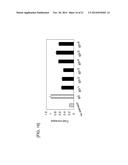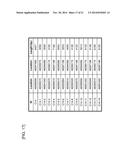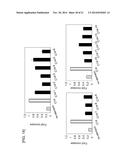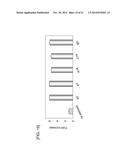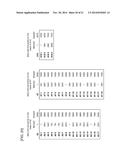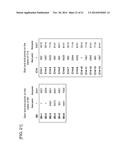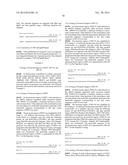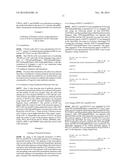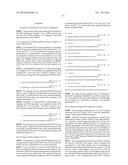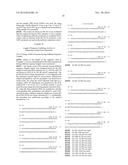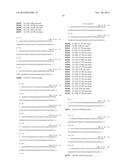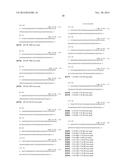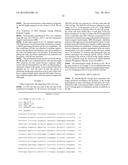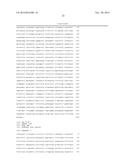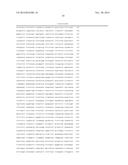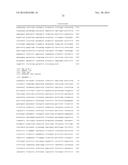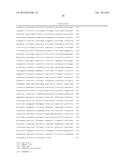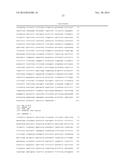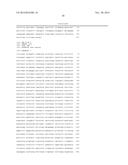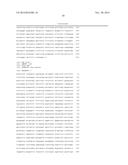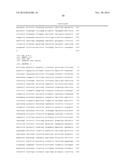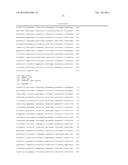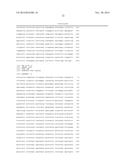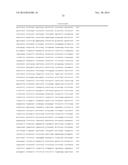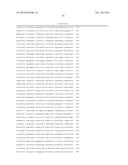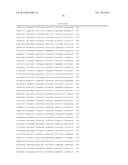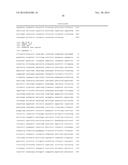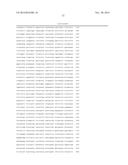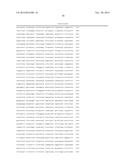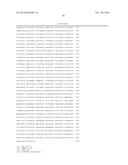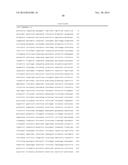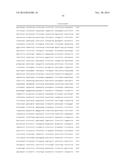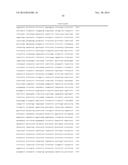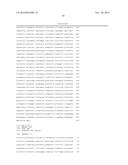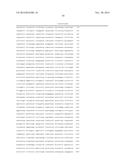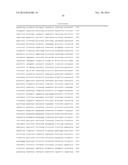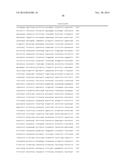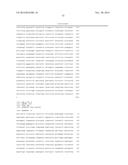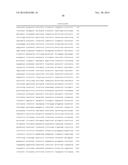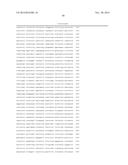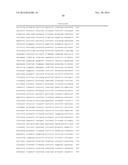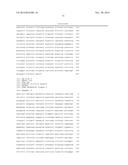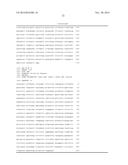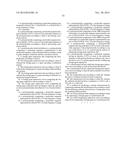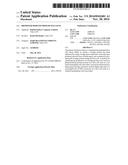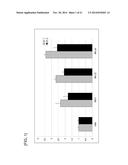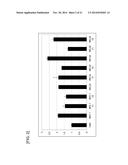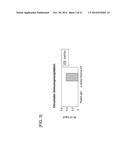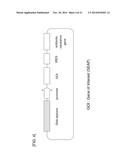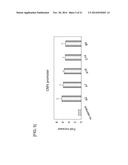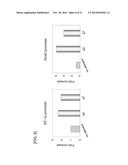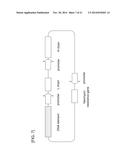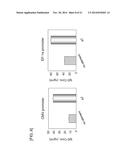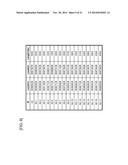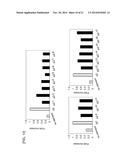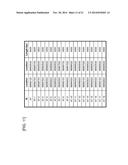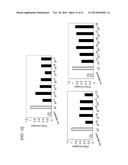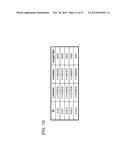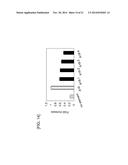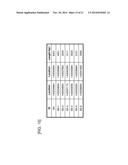Patent application title: PROMOTER DERIVED FROM HUMAN GENE
Inventors:
Kenji Murakami (Tokyo, JP)
Assignees:
DAIICHI SANKYO COMPANY, LIMITED
IPC8 Class: AC12N1585FI
USPC Class:
435 691
Class name: Chemistry: molecular biology and microbiology micro-organism, tissue cell culture or enzyme using process to synthesize a desired chemical compound or composition recombinant dna technique included in method of making a protein or polypeptide
Publication date: 2014-11-20
Patent application number: 20140342401
Abstract:
The present invention relates to a transfected mammalian host cell whose
ability to secrete a foreign protein has been enhanced by using a foreign
gene expression vector having a promoter derived from a human gene, and a
method for producing the foreign protein using the host cell. A method
for enhancing the production of a foreign protein to be used in a
pharmaceutical protein product in a host cell such as a cultured
mammalian cell is provided. A promoter derived from a human gene having a
promoter activity higher than that of a cytomegalovirus (CMV) promoter in
a host cell such as a cultured mammalian cell is provided.Claims:
1. A polynucleotide comprising a nucleotide sequence represented by SEQ
ID NO: 1, SEQ ID NO: 2, or SEQ ID NO: 3 in the Sequence Listing.
2-3. (canceled)
4. A polynucleotide comprising a nucleotide sequence having an identity of 95% or more to the nucleotide sequence of the polynucleotide according to claim 1 and having a promoter activity.
5. A polynucleotide comprising a nucleotide sequence having an identity of 99% or more to the nucleotide sequence of the polynucleotide according to claim 1 and having a promoter activity.
6. A polynucleotide which hybridizes to a polynucleotide comprising a nucleotide sequence complementary to the nucleotide sequence of the polynucleotide according to claim 1 under stringent conditions and has a promoter activity.
7. A foreign gene expression unit comprising the polynucleotide according to claim 1.
8. The foreign gene expression unit according to claim 7, wherein the foreign gene is a gene encoding a multimeric protein.
9. The foreign gene expression unit according to claim 7, wherein the foreign gene is a gene encoding a heteromultimeric protein.
10. The foreign gene expression unit according to claim 7, wherein the foreign gene is a gene encoding an antibody or a functional fragment thereof.
11. A foreign gene expression vector comprising the foreign gene expression unit according to claim 7.
12. The foreign gene expression vector comprising the foreign gene expression unit according to claim 11, and one or more polynucleotides described in (1) to (9) in the following: (1) a polynucleotide comprising a nucleotide sequence represented by SEQ ID NO: 10 in the Sequence Listing; (2) a polynucleotide comprising a nucleotide sequence represented by SEQ ID NO: 11 in the Sequence Listing; (3) a polynucleotide comprising a nucleotide sequence represented by SEQ ID NO: 12 in the Sequence Listing; (4) a polynucleotide comprising a nucleotide sequence represented by SEQ ID NO: 13 in the Sequence Listing; (5) a polynucleotide comprising a nucleotide sequence represented by SEQ ID NO: 14 in the Sequence Listing; (6) a polynucleotide comprising at least 3000 consecutive nucleotides of a nucleotide sequence represented by any one of SEQ ID NOS: 10 to 14 in the Sequence Listing; (7) a polynucleotide comprising at least 2000 consecutive nucleotides of a nucleotide sequence represented by any one of SEQ ID NOS: 10 to 14 in the Sequence Listing; (8) a polynucleotide comprising a polynucleotide sequence having an identity of 95% or more to the nucleotide sequence of the polynucleotide according to any one of the above (1) to (7), and having the activity of enhancing foreign gene expression; and (9) a polynucleotide comprising a nucleotide sequence having an identity of 99% or more to the nucleotide sequence of the polynucleotide according to any one of the above (1) to (7), and having the activity of enhancing foreign gene expression.
13. A transformed cell into which the foreign gene expression vector according to claim 11 has been introduced.
14. A transformed cell into which the foreign gene expression vector according to claim 11 and an element vector have been introduced.
15. The transformed cell according to claim 13, wherein the cell is a cultured cell derived from a mammal.
16. The transformed cell according to claim 15, wherein the cultured cell derived from a mammal is a COS-1 cell, a 293 cell, or a CHO cell.
17. A method for producing a protein characterized by comprising culturing the transformed cell according to claim 13 and obtaining a protein derived from a foreign gene from the resulting culture product.
18. Use of the polynucleotide sequence according to claim 1 for expressing a foreign gene in a transformed cell.
19. Use of the foreign gene expression vector according to claim 11 for expressing a foreign gene in a transformed cell.
Description:
CROSS-REFERENCE TO RELATED APPLICATION
[0001] This application is a continuation of International Application No. PCT/JP2012/080532, filed Nov. 27, 2012, the disclosure of which is incorporated by reference herein.
STATEMENT REGARDING SEQUENCE LISTING
[0002] The sequence listing associated with this application is provided in text format in lieu of a paper copy and is hereby incorporated by reference into the specification. The name of the text file containing the sequence listing is 43753_Sequence_Substitute--2014-08-06.txt. The text file is 109 KB; was created on Aug. 6, 2014; and is being submitted via EFS-Web with the filing of the specification.
TECHNICAL FIELD
[0003] The present invention relates to a transfected mammalian host cell whose foreign protein transcriptional activity has been enhanced by using a foreign gene expression vector having a promoter derived from a human gene and a method for producing the foreign protein using the host cell.
BACKGROUND ART
[0004] Due to the development of genetic recombination techniques, the market for protein pharmaceutical products such as therapeutic proteins and antibody drugs has rapidly expanded. In particular, antibody drugs can have high specificity without causing an adverse immunoreaction when administered to the human body, and therefore, the development thereof has been actively pursued.
[0005] As a host by which a pharmaceutical protein product typified by an antibody drug is produced, a microorganism, a yeast, an insect, an animal or plant cell, a transgenic animal or plant cell, or the like can be used. In order for the pharmaceutical protein product to have biological activity or immunogenicity, post-translational modification such as folding or glycosylation is essential. Therefore, a microorganism with which complicated post-translational modification cannot be performed, or a plant having a different glycan structure, is not suitable as the host. The use of a cultured mammalian cell such as a CHO (Chinese hamster ovary) cell, which is from a species closely related to humans, is the current standard considering that such a cell has a glycan structure similar to that of humans and is safe, and post-translational modification can be performed using such a cell.
[0006] In cases where a cultured mammalian cell is used as the host, there are problems that the growth rate is low, the productivity is low, the cost is high, etc., as compared with a microorganism or the like (NPL 1). In addition, in order to use a pharmaceutical protein product clinically, it is necessary to administer a large amount of the product. Therefore, the lack of production ability thereof is another worldwide problem. When a pharmaceutical protein product is produced in a cultured mammalian cell expression system, the production cost is high as compared with a low molecular weight synthetic pharmaceutical product. Accordingly attempts have been made to reduce the production cost by improving the respective production steps. Improvement of the production amount in the cultured mammalian cell expression system is an effective method for reducing the production cost (NPL 2 and NPL 3). Accordingly, in order to improve the productivity of a foreign gene in a cultured mammalian cell, various approaches based on promoters, enhancers, antibiotic selection markers, gene amplification, culturing engineering techniques, and the like have been investigated. In cases where a CHO cell is used as a host cell to express a foreign gene, i.e., to produce a pharmaceutical protein product, a virus-derived, human cytomegalovirus major immediate early promoter (hereinafter referred to as "CMV promoter") is generally used (NPL 4, NPL 5, and NPL 6). Further, it is known that a polynucleotide upstream of the transcription start site of a human ribosomal protein gene such as RPL32 or RPS 11 can be used as a DNA element for the protein expression in a CHO cell, in combination with another heterologous promoter (NPL 7 and PLT 1).
CITATION LIST
Patent Literature
[0007] PTL 1: WO 2006/123097
Non Patent Literature
[0007]
[0008] NPL 1: Florian M. Wurm., Nat. Biotechnol. 22(11):1393-1398, 2004
[0009] NPL 2: Farid S S., J Chromatogr B Analyt Technol Biomed Life Sci. 848(1):8-18, 2007
[0010] NPL 3: Werner R G. Economic aspects of commercial manufacture of biopharmaceuticals. J Biotechnol. 113(1-3):171-182, 2004
[0011] NPL 4: Durocher Y et al., Curr Opin Biotechnol. 20(6):700-707, 2009
[0012] NPL 5: Boshart M et al., Cell. 41(2):521-530, 1985
[0013] NPL 6: Foecking M K et al., Gene. 45(1):101-105, 1986
[0014] NPL 7: Hoeksema F. et al., Biotechnology Research International, Volume 2011, Article ID 492875, 11 pages
SUMMARY OF THE INVENTION
Technical Problem
[0015] An object of the invention is to provide a method for increasing the production of a foreign protein to be used in a pharmaceutical protein product, using a promoter having a high activity to enhance foreign gene expression in a host cell such as a cultured mammalian cell. By identifying a promoter having a promoter activity equivalent to or higher than that of a CMV promoter in a CHO cell or the like, a method for stably achieving high foreign gene expression in a mammalian cell is provided, and a method for contributing to the improvement of production levels, in other words, reduction in the production costs of a pharmaceutical protein product in a cultured mammalian cell expression system, can be provided.
Solution to Problem
[0016] The present inventors made intensive studies in order to solve the above problems, and found that a polynucleotide starting at a nucleotide located about 2 kbp upstream of the transcription start site and ending at a nucleotide immediately upstream of a nucleotide sequence corresponding to the start codon of a human ribosomal protein gene has a high promoter activity. They found that the promoter activity can significantly improve the production of a foreign protein which is to be expressed in a cultured mammalian cell, and thus completed the invention. The invention includes the following aspects.
[0017] (1) A polynucleotide comprising a nucleotide sequence represented by SEQ ID NO: 1 in the Sequence Listing.
[0018] (2) A polynucleotide comprising a nucleotide sequence represented by SEQ ID NO: 2 in the Sequence Listing.
[0019] (3) A polynucleotide comprising a nucleotide sequence represented by SEQ ID NO: 3 in the Sequence Listing.
[0020] (4) A polynucleotide comprising a nucleotide sequence having an identity of 95% or more to the nucleotide sequence of the polynucleotide according to any one of the above (1) to (3) and having a promoter activity.
[0021] (5) A polynucleotide comprising a nucleotide sequence having an identity of 99% or more to the nucleotide sequence of the polynucleotide according to any one of the above (1) to (3) and having a promoter activity.
[0022] (6) A polynucleotide which hybridizes to a polynucleotide comprising a nucleotide sequence complementary to the nucleotide sequence of the polynucleotide according to any one of the above (1) to (3) under stringent conditions and has a promoter activity.
[0023] (7) A foreign gene expression unit comprising the polynucleotide according to any one of the above (1) to (6).
[0024] (8) The foreign gene expression unit according to the above (7), wherein the foreign gene is a gene encoding a multimeric protein.
[0025] (9) The foreign gene expression unit according to the above (7), wherein the foreign gene is a gene encoding a heteromultimeric protein.
[0026] (10) The foreign gene expression unit according to the above (7), wherein the foreign gene is a gene encoding an antibody or a functional fragment thereof.
[0027] (11) A foreign gene expression vector comprising the foreign gene expression unit according to any one of the above (7) to (10).
[0028] (12) A foreign gene expression vector comprising the foreign gene expression unit according to any one of the above (7) to (10), and one or more polynucleotides selected from polynucleotides described in (a) to (i) in the following Group A:
[0029] Group A
[0030] (a) a polynucleotide comprising a nucleotide sequence represented by SEQ ID NO: 10 in the Sequence Listing;
[0031] (b) a polynucleotide comprising a nucleotide sequence represented by SEQ ID NO: 11 in the Sequence Listing;
[0032] (c) a polynucleotide comprising a nucleotide sequence represented by SEQ ID NO: 12 in the Sequence Listing;
[0033] (d) a polynucleotide comprising a nucleotide sequence represented by SEQ ID NO: 13 in the Sequence Listing;
[0034] (e) a polynucleotide comprising a nucleotide sequence represented by SEQ ID NO: 14 in the Sequence Listing;
[0035] (f) a polynucleotide comprising at least 3000 consecutive nucleotides of a nucleotide sequence represented by any one of SEQ ID NOS: 10 to 14 in the Sequence Listing;
[0036] (g) a polynucleotide comprising at least 2000 consecutive nucleotides of a nucleotide sequence represented by any one of SEQ ID NOS: 10 to 14 in the Sequence Listing;
[0037] (h) a polynucleotide comprising a polynucleotide sequence having an identity of 95% or more to the nucleotide sequence of the polynucleotide according to any one of the above (a) to (g), and having the activity of enhancing foreign gene expression; and
[0038] (i) a polynucleotide comprising a nucleotide sequence having an identity of 99% or more to the nucleotide sequence of the polynucleotide according to any one of the above (a) to (g), and having the activity of enhancing foreign gene expression.
[0039] (13) A transformed cell into which the foreign gene expression vector according to the above (11) or (12) has been introduced.
[0040] (14) A transformed cell into which the foreign gene expression vector according to the above (11) or (12) and an element vector have been introduced.
[0041] (15) The transformed cell according to the above (13) or (14), wherein the cell is a cultured cell derived from a mammal.
[0042] (16) The transformed cell according to the above (15), wherein the cultured cell derived from a mammal is a COS-1 cell, a 293 cell, or a CHO cell.
[0043] (17) A method for producing a protein characterized by culturing the transformed cell according to any one of the above (13) to (16) and obtaining a protein derived from a foreign gene from the resulting culture product.
[0044] (18) Use of the polynucleotide sequence according to any one of the above (1) to (6) for expressing a foreign gene in a transformed cell.
[0045] (19) Use of the foreign gene expression vector according to the above (11) or (12) for expressing a foreign gene in a transformed cell.
Advantageous Effects of the Invention
[0046] By introducing a foreign gene expression vector using a promoter derived from a human gene of the invention into a mammalian host cell, the expression of a foreign gene of a therapeutic protein, an antibody, or the like can be significantly enhanced. Further, by using the promoter of the invention in combination with a DNA element, the expression of a foreign gene of a therapeutic protein, an antibody, or the like can be further enhanced.
BRIEF DESCRIPTION OF THE DRAWINGS
[0047] FIG. 1 shows a graph in which the activity of promoters was evaluated by using the activity of SEAP as an index in transfected CHO-K1 polyclonal cells. The graph shows the activity of SEAP for each promoter, with the value for a CMV promoter normalized to 1. The results of two independent experiments are shown (n=3, mean±SD).
[0048] FIG. 2 shows a graph in which the activity of truncated promoters was evaluated by using the activity of SEAP as an index in transfected CHO-K1 polyclonal cells. The graph shows the activity of each promoter, with the value for a CMV promoter normalized to 1 (n=3, mean±SD).
[0049] FIG. 3 shows a graph in which it was confirmed by the amplification of a GAPDH region that a sample subjected to ChIP-on-chip was chromatin-immunoprecipitated specifically with an anti-acetylated histone H3 antibody.
[0050] FIG. 4 is a schematic view of an SEAP expression vector into which a DNA element has been inserted.
[0051] FIG. 5 shows a graph in which the expression-enhancing effects of DNA elements A2, A7, A18, B5, and C14 were confirmed by using the activity of SEAP expressed by a CMV promoter as an index in a transfected CHO cell line.
[0052] FIG. 6 shows graphs in which the expression-enhancing effects of DNA elements A2 and A7 were confirmed by using the activity of SEAP expressed by an EF-1α or an SV40 promoter as an index in a transfected CHO cell line.
[0053] FIG. 7 is a schematic view of an antibody expression (antibody gene X heavy chain and light chain co-expression) vector into which a DNA element has been inserted.
[0054] FIG. 8 shows graphs in which the expression-enhancing effect of DNA element A7 was confirmed by using the level of production (measured by an ELISA method) of an antibody expressed by a CMV or an EF-1α promoter as an index in a transfected CHO cell line.
[0055] FIG. 9 is a table showing the sequence lengths of DNA element A2 and related sequences.
[0056] FIG. 10 shows graphs in which the expression-enhancing effects of DNA element A2 and related sequences were confirmed by using the activity of SEAP as an index in a transfected CHO cell line.
[0057] FIG. 11 is a table showing the sequence lengths of DNA element A7 and related sequences.
[0058] FIG. 12 shows graphs in which the expression-enhancing effects of DNA element A7 and related sequences were confirmed by using the activity of SEAP as an index in a transfected CHO cell line.
[0059] FIG. 13 is a table showing the sequence lengths of DNA element A18 and related sequences.
[0060] FIG. 14 shows a graph in which the expression-enhancing effects of DNA element A18 and related sequences were confirmed by using the activity of SEAP as an index in a transfected CHO cell line.
[0061] FIG. 15 is a table showing the sequence lengths of DNA element B5 and related sequences.
[0062] FIG. 16 shows a graph in which the expression-enhancing effects of DNA element B5 and related sequences were confirmed by using the activity of SEAP as an index in a transfected CHO cell line.
[0063] FIG. 17 is a table showing the sequence lengths of DNA element C14 and related sequences.
[0064] FIG. 18 shows graphs in which the expression-enhancing effects of DNA element C14 and related sequences were confirmed by using the activity of SEAP as an index in a transfected CHO cell line.
[0065] FIG. 19 shows a graph in which the expression-enhancing effects of DNA elements A2, A7, A18, B5, and C14 were confirmed by using the activity of SEAP as an index in a transfected HEK293 cell line.
[0066] FIG. 20 is a table showing nucleotides at the start and end points on the basis of the full-length sequence of DNA element A2, A7, or A18.
[0067] FIG. 21 is a table showing nucleotides at the start and end points on the basis of the full-length sequence of DNA element B5 or C14.
DESCRIPTION OF EMBODIMENTS
[0068] Hereinafter, the invention will be specifically described.
[0069] The term "gene" as used herein refers to a segment which is transcribed into an mRNA and then translated into a protein, and includes not only a DNA, but also an mRNA thereof, cDNA thereof, and an RNA thereof.
[0070] The term "polynucleotide" as used herein is used in the same meaning as nucleic acid and also includes DNA, RNA, probe, oligonucleotide, and primer.
[0071] The terms "polypeptide" and "protein" as used herein are used without distinction.
[0072] The term "gene expression" as used herein refers to a phenomenon in which an mRNA is transcribed from a gene and/or a phenomenon in which a protein is translated from the mRNA.
[0073] The term "foreign gene" as used herein refers to a gene which is artificially introduced into a host cell.
[0074] The term "foreign protein" as used herein refers to a protein encoded by a foreign gene.
[0075] The term "gene expression unit" as used herein refers to a polynucleotide having, in the direction of the reading frame of transcription, at least a promoter region, a foreign gene, and a transcription terminator region (poly(A) addition signal).
[0076] The term "activity to enhance foreign gene expression" as used herein refers to the activity to enhance the production of a foreign protein in a host cell by creating an environment advantageous to transcription in any DNA around the gene expression unit containing a foreign gene and significantly improving the transcription efficiency.
[0077] The term "promoter" as used herein refers to a region to which a transcription factor involved in the initiation of transcription from DNA into RNA can bind, and is sometimes referred to as "promoter region" in this description. Examples of the promoter include a polynucleotide starting at a nucleotide located about 2 kbp upstream of a transcription start site and ending at a nucleotide immediately upstream of a nucleotide sequence corresponding to the start codon, and the promoter may contain a 5'-UTR and an intron.
[0078] The term "promoter activity" as used herein refers to an activity in which a transcription factor binds to a promoter and initiates transcription to produce a protein encoded by a gene. It can be assayed by using the activity of a protein encoded by a reporter gene such as secretory alkaline phosphatase (SEAP) as an index.
[0079] The phrase "having a promoter activity" as used herein refers to having the activity of expressing SEAP equivalent to or higher than that of a CMV promoter under the same conditions as those described below (Example 3) for evaluating a promoter activity by using the expression level of SEAP as an index.
[0080] The term "DNA element" as used herein refers to a polynucleotide having the activity of enhancing foreign gene expression in cases where the polynucleotide is located in the vicinity of a gene expression unit or in a foreign gene expression vector containing a gene expression unit.
[0081] The term "functional fragment of an antibody" as used herein refers to a partial fragment of an antibody having an antigen-binding activity and includes Fab, F(ab')2, and the like. However, the term is not limited to these molecules as long as the fragment has a binding affinity for an antigen.
[0082] The term "identity" as used herein refers to a relationship between the sequences of two or more nucleotide sequences or amino acid sequences determined by comparing the sequences, as known in the art. In the art, the term "identity" may also refer to the degree of sequence relatedness between nucleic acid molecules or between polypeptides as determined by the match between strings of two or more nucleotide sequences or two or more amino acid sequences. The "identity" can be evaluated by calculating the percentage of identical matches between the smallest of the two or more sequences with gapped alignments (if any) addressed by a specific mathematical model or computer program (i.e., "algorithms"). Specifically, the identity can be evaluated by using software such as Clustal W2 provided by European Molecular Biology Laboratory-European Bioinformatics Institute (EMBL-EBI), but the software is not limited thereto and any can be used as long as it is used by those skilled in the art.
[0083] The phrase "hybridized under stringent conditions" as used herein refers to hybridization under conditions in which a so-called specific hybrid is formed but a non-specific hybrid is not formed. Examples of the conditions include conditions in which a complementary strand of a nucleic acid comprising a nucleotide sequence having an identity of 80% or more, preferably 90% or more, more preferably 95% or more, most preferably 99% or more to another nucleic acid hybridizes, and a complementary strand of a nucleic acid comprising a nucleotide sequence having a lower identity does not hybridize. More specifically, it means that hybridization is effected at 68° C. in a commercially available hybridization solution ExpressHyb Hybridization Solution (manufactured by Clontech, Inc.) or hybridization is effected under conditions such that hybridization is performed at 68° C. in the presence of 0.7 to 1.0 M NaCl using a filter having DNA immobilized thereon, followed by washing at 68° C. using 0.1 to 2×SSC solution (1×SSC solution is composed of 150 mM NaCl and 15 mM sodium citrate) or under conditions equivalent thereto.
1. PROMOTER TO BE USED FOR ENHANCING FOREIGN GENE EXPRESSION
[0084] As a promoter derived from a human gene of the invention (hereinafter sometimes also referred to as a "promoter of the invention"), a polynucleotide starting at a nucleotide located about 2 kbp upstream of the transcription start site and ending at a nucleotide immediately upstream of a nucleotide sequence corresponding to the start codon of a human ribosomal protein gene is preferred. The promoter derived from a human gene may be a polynucleotide starting at a nucleotide located about 1 kbp or about 0.5 kbp upstream of the transcription start site and ending at a nucleotide immediately upstream of a nucleotide sequence corresponding to the start codon sequence of a human ribosomal protein gene.
[0085] The human ribosomal protein gene is preferably a human ribosomal protein S7 gene (hereinafter referred to as "RPS7"), a human ribosomal protein L32 gene (hereinafter referred to as "RPL32"), or a human ribosomal protein L34 gene (hereinafter referred to as "RPL34").
[0086] The promoter of the invention is preferably a promoter of RPS7, RPL32, or RPL34, more preferably a polynucleotide represented by any of SEQ ID NOS: 1 to 9 in the Sequence Listing, and particularly preferably a polynucleotide represented by any of SEQ ID NOS: 1 to 3.
[0087] The nucleotide sequences of SEQ ID NOS: 1, 2, and 3 are sequences starting at a nucleotide located about 2 kbp upstream of the transcription start site and ending at a nucleotide immediately upstream of a nucleotide sequence corresponding to the start codon of RPS7, RPL32, and RPL34, respectively. The nucleotide sequences of SEQ ID NOS: 4, 6, and 8 are sequences starting at a nucleotide located about 1 kbp upstream of the transcription start site and ending at a nucleotide immediately upstream of a nucleotide sequence corresponding to the start codon of RPS7, RPL32, and RPL34, respectively. The nucleotide sequences of SEQ ID NOS: 5, 7, and 9 are sequences starting at a nucleotide located about 0.5 kbp upstream of the transcription start site and ending at a nucleotide immediately upstream of a nucleotide sequence corresponding to the start codon of RPS7, RPL32, and RPL34, respectively.
[0088] Further, the promoter of the invention may be a polynucleotide which comprises a nucleotide sequence having an identity of 80% or more, preferably 90% or more, more preferably 95% or more, most preferably 99% or more to any one of the nucleotide sequences represented by SEQ ID NOS: 1 to 9, and has a promoter activity.
[0089] The promoter of the invention may be a polynucleotide which hybridizes to a polynucleotide, comprising a nucleotide sequence complementary to a polynucleotide comprising any one nucleotide sequence, selected from the group consisting of the nucleotide sequences represented by SEQ ID NOS: 1 to 9, under stringent conditions and has a promoter activity.
[0090] The promoter of the invention may be a polynucleotide which is a mutated polynucleotide comprising a nucleotide sequence in which one or more, preferably 1 to 300, more preferably 1 to 30 nucleotides have been deleted, substituted, and/or added in any one nucleotide sequence selected from the group consisting of the nucleotide sequences represented by SEQ ID NOS: 1 to 9, and has a promoter activity.
[0091] Introduction of a mutation (deletion, substitution, and/or addition) into the above-mentioned nucleotide sequence can be performed by a method known in the art such as a Kunkel method or a gapped duplex method, or an equivalent method. For example, a mutation introduction kit utilizing a site-directed mutagenesis method such as Mutant-K (manufactured by TaKaRa Bio, Inc.) or Mutant-G (manufactured by TaKaRa Bio, Inc.), an LA PCR in vitro Mutagenesis series kit (manufactured by TaKaRa Bio, Inc.) can be used. Such a mutated polynucleotide can also be used as the promoter of the invention.
[0092] The activity of the promoter of the invention to enhance foreign gene expression can be assayed by using the activity of a protein encoded by a reporter gene, such as SEAP, as an index. In cases where the activity of a reporter protein when using the promoter of the invention is equivalent to or higher than when using a CMV promoter, preferably, the activity being increased by 1.2 times or more, more preferably by 1.5 times or more, the promoter can be judged to have the activity of enhancing foreign gene expression. Even in cases where the activity is increased by about 1.2 times or more, it is expected that this will reduce the cell culture scale, the cell culture time, and the purification step, making it possible to increase the yield and reduce the cell culture cost. If the yield is increased, then it is possible to supply stably a foreign protein to be used as a pharmaceutical product. In addition, if the cell culture cost is reduced, the cost for the foreign protein to be used as a pharmaceutical product is reduced.
[0093] Further, the promoter of the invention can also be used for enhancing the expression of an endogenous gene of a host cell by introducing the promoter into the host cell using a method well known to those skilled in the art.
2. FOREIGN GENE EXPRESSION UNIT
[0094] The foreign gene expression unit of the invention (hereinafter sometimes also referred to as "gene expression unit of the invention") has, in the direction of the reading frame of transcription, at least the promoter of the invention described in the above item "1", a foreign gene, and a transcription terminator region (poly(A) addition signal).
[0095] Further, the poly(A) addition sequence may be a sequence having the activity to cause transcription termination for the transcription from the promoter, and may be a sequence from a gene identical to or different from that of the promoter.
3. DNA ELEMENT TO BE USED FOR ENHANCING FOREIGN GENE EXPRESSION
[0096] By using the gene expression unit of the invention described in the above item "2" and a DNA element in combination, the expression of a foreign gene can be further enhanced. The DNA element to be used in combination can be obtained by using the interaction between acetylated histone H3 and the element as an index as described in Example 6. In general, it is said that the acetylation of histones (H3 and H4) is associated with the activation of transcription, and two major theories have been advocated. One theory is that the acetylation of histones is associated with a change in nucleosome conformation in such a manner that histone tails are acetylated so as to be electrically neutralized, weakening DNA-histone interactions (Mellor J. (2006) Dynamic nucleosomes and gene transcription. Trends Genet. 22(6): 320-329). The other theory is that the acetylation of histones is associated with the recruitment of various transcription factors (Nakatani Y. (2001) Histone acetylases-versatile players. Genes Cells. 6(2): 79-86). According to either theory, there is a high possibility that the acetylation of histones is associated with the activation of transcription, and by performing chromatin immunoprecipitation (ChIP) using an anti-acetylated histone H3 antibody, it is possible to concentrate a DNA element that interacts with acetylated histone H3.
[0097] A2 is an example of the DNA element to be used in combination with the promoter of the invention for enhancing foreign gene expression. A2 is located in the region from 80966429 to 80974878 of human chromosome 15 and is an 8450 bp polynucleotide having an AT content of 62.2%. The nucleotide sequence of A2 is represented by SEQ ID NO: 10 in the Sequence Listing.
[0098] A7, A18, B5, and C14 are examples of similar DNA elements. A7 is located in the region from 88992123 to 89000542 of human chromosome 11 and is an 8420 bp polynucleotide having an AT content of 64.52%. The nucleotide sequence of A7 is represented by SEQ ID NO: 11 in the Sequence Listing.
[0099] A18 is located in the region from 111275976 to 111284450 of human chromosome 4 and is an 8475 bp polynucleotide having an AT content of 62.54%. The nucleotide sequence of A18 is represented by SEQ ID NO: 12 in the Sequence Listing.
[0100] B5 is located in the region from 143034684 to 143043084 of human chromosome 1 and is an 8401 bp polynucleotide having an AT content of 66.37%. The nucleotide sequence of B5 is represented by SEQ ID NO: 13 in the Sequence Listing.
[0101] Finally, C14 is located in the region from 46089056 to 46097482 of human chromosome 11 and is an 8427 bp polynucleotide having an AT content of 63.81%. The nucleotide sequence of C14 is represented by SEQ ID NO: 14 in the Sequence Listing.
[0102] The activity of enhancing foreign gene expression of the DNA element to be used in combination with the promoter of the invention can be assayed by using the activity of a protein encoded by a reporter gene such as SEAP as an index.
[0103] In cases where the DNA element is used in combination with the promoter of the invention, any one of the above DNA elements may be used alone, or two or more copies of one type of the DNA element may be used. Alternatively, two or more different types of the above DNA elements may be used in combination.
[0104] A2, A7, A18, B5, and C14 are preferred examples of the DNA element to be used in combination with the promoter of the invention.
[0105] The DNA element to be used in the invention may be a nucleotide sequence which comprises a nucleotide sequence having an identity of 80% or more, preferably 90% or more, more preferably 95% or more, most preferably 99% or more to any of the nucleotide sequences represented by SEQ ID NOS: 10 to 14 and has the activity of enhancing foreign gene expression. The nucleotide sequence homology search can be performed against, for example, the DNA Databank of Japan or the like using a program such as FASTA or BLAST.
[0106] The DNA element to be used in combination with the promoter of the invention may be a DNA element which hybridizes to a polynucleotide comprising a nucleotide sequence complementary to a polynucleotide comprising a nucleotide sequence selected from the group consisting of the nucleotide sequences represented by SEQ ID NOS: 10 to 14 under stringent conditions and has the activity of enhancing foreign gene expression.
[0107] A person skilled in the art can easily obtain such a homologue gene with reference to Molecular Cloning (Sambrook, J. et al., Molecular Cloning: a Laboratory Manual 2nd ed., Cold Spring Harbor Laboratory Press, 10 Skyline Drive Plainview, N.Y. (1989)), or the like. Further, the identity of the above-mentioned nucleotide sequence can be determined by a FASTA search or BLAST search in the same manner.
[0108] Introduction of a mutation (deletion, substitution, and/or addition) into the above-mentioned polynucleotide can be performed by a method known in the art such as a Kunkel method or a gapped duplex method, or an equivalent method. For example, a mutation introduction kit utilizing a site-directed mutagenesis method such as Mutant-K (manufactured by TaKaRa Bio, Inc.), Mutant-G (manufactured by TaKaRa Bio, Inc.), or an LA PCR in vitro Mutagenesis series kit (manufactured by TaKaRa Bio, Inc.), or the like can be used. Such a mutated polynucleotide can also be used as the DNA element of the invention.
[0109] As the DNA element to be used in combination with the promoter of the invention, a partial fragment comprising at least 3000 or at least 2000 consecutive nucleotides of a nucleotide sequence represented by any one of SEQ ID NOS: 10 to 14 in the Sequence Listing can be used. Examples of such a partial fragment include: A2-1 to A2-17 which are partial fragments of A2; A7-1 to A7-18 which are partial fragments of A7; A18-1 to A18-4 which are partial fragments of A18; B5-1 to B5-6 which are partial fragments of B5; and C14-1 to C14-14 which are partial fragments of C14. However, the DNA element is not limited to these partial fragments as long as it has the activity of enhancing foreign gene expression.
[0110] In the invention, any one of the above partial fragments may be used alone, and also two or more copies of one type of the partial fragment may be used. Alternatively, two or more different types of the partial fragments may be used in combination. Further, a full-length sequence and a partial fragment of any of the above-mentioned DNA elements may be used in combination. In the above combination, the full-length sequence and the partial fragment may be derived from the same DNA element or from different DNA elements.
[0111] As for the polynucleotide sequences of the respective fragments of A2, A2-1 corresponds to the polynucleotide sequence of nucleotides 1 to 3000 of SEQ ID NO: 10 in the Sequence Listing; A2-2 corresponds to the polynucleotide sequence of nucleotides 2801 to 5800 of SEQ ID NO: 10 in the Sequence Listing; A2-3 corresponds to the polynucleotide sequence of nucleotides 5401 to 8450 of SEQ ID NO: 10 in the Sequence Listing; A2-4 corresponds to the polynucleotide sequence of nucleotides 701 to 2700 of SEQ ID NO: 10 in the Sequence Listing; A2-5 corresponds to the polynucleotide sequence of nucleotides 701 to 2200 of SEQ ID NO: 10 in the Sequence Listing; A2-6 corresponds to the polynucleotide sequence of nucleotides 701 to 3700 of SEQ ID NO: 10 in the Sequence Listing; A2-7 corresponds to the polynucleotide sequence of nucleotides 2001 to 5000 of SEQ ID NO: 10 in the Sequence Listing; A2-8 corresponds to the polynucleotide sequence of nucleotides 4001 to 7000 of SEQ ID NO: 10 in the Sequence Listing; A2-9 corresponds to the polynucleotide sequence of nucleotides 1 to 3700 of SEQ ID NO: 10 in the Sequence Listing; A2-10 corresponds to the polynucleotide sequence of nucleotides 2001 to 5800 of SEQ ID NO: 10 in the Sequence Listing; A2-11 corresponds to the polynucleotide sequence of nucleotides 2801 to 7000 of SEQ ID NO: 10 in the Sequence Listing; A2-12 corresponds to the polynucleotide sequence of nucleotides 701 to 5800 of SEQ ID NO: 10 in the Sequence Listing; A2-13 corresponds to the polynucleotide sequence of nucleotides 2001 to 7000 of SEQ ID NO: 10 in the Sequence Listing; A2-14 corresponds to the polynucleotide sequence of nucleotides 2801 to 8450 of SEQ ID NO: 10 in the Sequence Listing; A2-15 corresponds to the polynucleotide sequence of nucleotides 1 to 5800 of SEQ ID NO: 10 in the Sequence Listing; A2-16 corresponds to the polynucleotide sequence of nucleotides 701 to 7000 of SEQ ID NO: 10 in the Sequence Listing; and A2-17 corresponds to the polynucleotide sequence of nucleotides 2001 to 8450 of SEQ ID NO: 10 in the Sequence Listing.
[0112] As for the polynucleotide sequences of the respective fragments of A7, A7-1 corresponds to the polynucleotide sequence of nucleotides 601 to 3600 of SEQ ID NO: 11 in the Sequence Listing; A7-2 corresponds to the polynucleotide sequence of nucleotides 3601 to 8420 of SEQ ID NO: 11 in the Sequence Listing; A7-3 corresponds to the polynucleotide sequence of nucleotides 5401 to 8420 of SEQ ID NO: 11 in the Sequence Listing; A7-4 corresponds to the polynucleotide sequence of nucleotides 3401 to 6400 of SEQ ID NO: 11 in the Sequence Listing; A7-5 corresponds to the polynucleotide sequence of nucleotides 1501 to 4500 of SEQ ID NO: 11 in the Sequence Listing; A7-6 corresponds to the polynucleotide sequence of nucleotides 4401 to 7400 of SEQ ID NO: 11 in the Sequence Listing; A7-7 corresponds to the polynucleotide sequence of nucleotides 2401 to 5400 of SEQ ID NO: 11 in the Sequence Listing; A7-8 corresponds to the polynucleotide sequence of nucleotides 1 to 3600 of SEQ ID NO: 11 in the Sequence Listing; A7-9 corresponds to the polynucleotide sequence of nucleotides 1501 to 5400 of SEQ ID NO: 11 in the Sequence Listing; A7-10 corresponds to the polynucleotide sequence of nucleotides 2401 to 6400 of SEQ ID NO: 11 in the Sequence Listing; A7-11 corresponds to the polynucleotide sequence of nucleotides 3401 to 7400 of SEQ ID NO: 11 in the Sequence Listing; A7-12 corresponds to the polynucleotide sequence of nucleotides 4401 to 8420 of SEQ ID NO: 11 in the Sequence Listing; A7-13 corresponds to the polynucleotide sequence of nucleotides 1 to 5400 of SEQ ID NO: 11 in the Sequence Listing; A7-14 corresponds to the polynucleotide sequence of nucleotides 1501 to 6400 of SEQ ID NO: 11 in the Sequence Listing; A7-15 corresponds to the polynucleotide sequence of nucleotides 2401 to 7400 of SEQ ID NO: 11 in the Sequence Listing; A7-16 corresponds to the polynucleotide sequence of nucleotides 3401 to 8420 of SEQ ID NO: 11 in the Sequence Listing; A7-17 corresponds to the polynucleotide sequence of nucleotides 1 to 6400 of SEQ ID NO: 11 in the Sequence Listing; and A7-18 corresponds to the polynucleotide sequence of nucleotides 1501 to 7400 of SEQ ID NO: 11 in the Sequence Listing.
[0113] As for the polynucleotide sequences of the respective fragments of A18, A18-1 corresponds to the polynucleotide sequence of nucleotides 1 to 5040 of SEQ ID NO: 12 in the Sequence Listing; A18-2 corresponds to the polynucleotide sequence of nucleotides 1001 to 6002 of SEQ ID NO: 12 in the Sequence Listing; A18-3 corresponds to the polynucleotide sequence of nucleotides 2001 to 7000 of SEQ ID NO: 12 in the Sequence Listing; and A18-4 corresponds to the polynucleotide sequence of nucleotides 3000 to 7000 of SEQ ID NO: 12 in the Sequence Listing.
[0114] As for the polynucleotide sequences of the respective fragments of B5, B5-1 corresponds to the polynucleotide sequence of nucleotides 1 to 4001 of SEQ ID NO: 13 in the Sequence Listing; B5-2 corresponds to the polynucleotide sequence of nucleotides 1 to 3200 of SEQ ID NO: 13 in the Sequence Listing; B5-3 corresponds to the polynucleotide sequence of nucleotides 2491 to 5601 of SEQ ID NO: 13 in the Sequence Listing; B5-4 corresponds to the polynucleotide sequence of nucleotides 5373 to 8401 of SEQ ID NO: 13 in the Sequence Listing; B5-5 corresponds to the polynucleotide sequence of nucleotides 901 to 4001 of SEQ ID NO: 13 in the Sequence Listing; and B5-6 corresponds to the polynucleotide sequence of nucleotides 4001 to 7000 of SEQ ID NO: 13 in the Sequence Listing.
[0115] As for the polynucleotide sequences of the respective fragments of C14, C14-1 corresponds to the polynucleotide sequence of nucleotides 960 to 4015 of SEQ ID NO: 14 in the Sequence Listing; C14-2 corresponds to the polynucleotide sequence of nucleotides 1987 to 5014 of SEQ ID NO: 14 in the Sequence Listing; C14-3 corresponds to the polynucleotide sequence of nucleotides 4020 to 7119 of SEQ ID NO: 14 in the Sequence Listing; C14-4 corresponds to the polynucleotide sequence of nucleotides 960 to 8141 of SEQ ID NO: 14 in the Sequence Listing; C14-5 corresponds to the polynucleotide sequence of nucleotides 960 to 6011 of SEQ ID NO: 14 in the Sequence Listing; C14-6 corresponds to the polynucleotide sequence of nucleotides 4939 to 8141 of SEQ ID NO: 14 in the Sequence Listing; C14-7 corresponds to the polynucleotide sequence of nucleotides 960 to 5014 of SEQ ID NO: 14 in the Sequence Listing; C14-8 corresponds to the polynucleotide sequence of nucleotides 2994 to 7119 of SEQ ID NO: 14 in the Sequence Listing; C14-9 corresponds to the polynucleotide sequence of nucleotides 4020 to 8141 of SEQ ID NO: 14 in the Sequence Listing; C14-10 corresponds to the polynucleotide sequence of nucleotides 1 to 5014 of SEQ ID NO: 14 in the Sequence Listing; C14-11 corresponds to the polynucleotide sequence of nucleotides 1987 to 7119 of SEQ ID NO: 14 in the Sequence Listing; C14-12 corresponds to the polynucleotide sequence of nucleotides 2994 to 8141 of SEQ ID NO: 14 in the Sequence Listing; C14-13 corresponds to the polynucleotide sequence of nucleotides 960 to 7119 of SEQ ID NO: 14 in the Sequence Listing; and C14-14 corresponds to the polynucleotide sequence of nucleotides 1987 to 8141 of SEQ ID NO: 14 in the Sequence Listing.
4. ACQUISITION OF POLYNUCLEOTIDE
[0116] In the invention, a polynucleotide containing a foreign gene encoding a foreign protein, the production of which is to be increased, which will be described later, can be obtained by common procedures as described below. For example, such a polynucleotide can be isolated by screening a cDNA library derived from cells or tissues expressing the foreign gene using a DNA probe synthesized from a fragment of the foreign gene. mRNA therefore can be prepared by methods commonly used in the art. For example, the cells or tissues are treated with a guanidine reagent, a phenol reagent, etc., thereby obtaining total RNA, and thereafter, poly(A)+RNA (mRNA) is obtained by an affinity column method using an oligo(dT) cellulose column or a poly U-Sepharose column containing Sepharose 2B, or the like, as a carrier or by a batch method. Also, the poly(A)+RNA may further be fractionated by sucrose density-gradient centrifugation or the like. Then, single-stranded cDNA is synthesized using the thus obtained mRNA as a template, oligo dT primers, and a reverse transcriptase. From the thus obtained single-stranded cDNA, double-stranded cDNA is synthesized using DNA polymerase I, DNA ligase, RNase H, and the like. The thus synthesized double-stranded cDNA is blunted using T4 DNA polymerase, followed by ligation to an adapter (such as EcoRI adapter), phosphorylation, and the like, and the resulting DNA is incorporated into a lambda phage such as λgt11 to achieve in vivo packaging, whereby a cDNA library is prepared. It is also possible to prepare a cDNA library using a plasmid vector instead of lambda phages. Thereafter, a clone containing the target DNA (a positive clone) may be selected from the cDNA library.
[0117] In cases where the above-mentioned promoter, a polynucleotide containing a terminator region, the above-mentioned DNA element, or a polynucleotide containing a foreign gene to be used for producing a protein is isolated from genomic DNA, according to a common procedure (Molecular Cloning (1989), Methods in Enzymology 194 (1991)), genomic DNA is extracted from a cell line of an organism to be used as a collection source, and the polynucleotide is selected and isolated. The extraction of genomic DNA can be performed according to, for example, the method of Cryer et al. (Methods in Cell Biology, 12, 39-44 (1975)) or the method of P. Philippsen et al. (Methods Enzymol., 194, 169-182 (1991)).
[0118] The target promoter, DNA element, or polynucleotide containing a foreign gene can also be obtained by, for example, the PCR method (PCR Technology. Henry A. Erlich, Stockton press (1989)). In the amplification of a polynucleotide using the PCR method, 20- to 30-mer synthetic single-stranded DNAs are used as primers and genomic DNA is used as a template. The amplified gene is used after the polynucleotide sequence of the gene is confirmed. As the template for PCR, a genomic DNA library such as a bacterial artificial chromosome (BAC)-library can be used.
[0119] On the other hand, the polynucleotide containing a foreign gene whose sequence is not known can be obtained by (a) preparing a gene library according to a common procedure, and (b) selecting a desired polynucleotide from the prepared gene library and amplifying the polynucleotide. The gene library can be prepared by partially digesting chromosomal DNA obtained by a common procedure from a cell line of an organism to be used as a collection source using an appropriate restriction enzyme to fragment the chromosomal DNA, ligating the obtained fragments to an appropriate vector, and introducing the vector into an appropriate host. The gene library can also be prepared by extracting mRNA from the cells, synthesizing cDNA from the mRNA, ligating the cDNA to an appropriate vector, and introducing the vector into an appropriate host. As the vector to be used in such preparation, a plasmid generally known as a vector for gene library preparation can be used, and also a phage vector, a cosmid, or the like can be used. As the host to be transformed or transfected, a host suitable for the type of the above-mentioned vector may be used. The polynucleotide containing the foreign gene is selected from the above-mentioned gene library by a colony hybridization method, a plaque hybridization method, or the like using a labeled probe containing a sequence specific for the foreign gene.
[0120] Further, the polynucleotide containing the foreign gene can also be produced by total chemical synthesis. For example, the gene can be synthesized by a method in which two pairs of complementary oligonucleotides are prepared and annealed, a method in which several annealed DNA strands are ligated by a DNA ligase, a method in which several partially complementary oligonucleotides are prepared and gaps are filled by PCR, or the like.
[0121] The determination of a polynucleotide sequence can be performed by a conventional technique, for example, a dideoxy method (Sanger et al., Proc. Natl. Acad. Sci., USA, 74, 5463-5467 (1977)), or the like. Further, the above determination of a polynucleotide sequence can also be easily performed using a commercially available sequencing kit or the like.
5. FOREIGN GENE EXPRESSION VECTOR, ELEMENT VECTOR
[0122] As a foreign gene expression vector of the invention, a vector containing the foreign gene expression unit described in the above item "2" containing the promoter of the invention described in the above item "1" is provided. The foreign gene expression vector of the invention may contain one type of the DNA elements described in the above item "3", two or more copies of one type of the above-mentioned DNA elements, or two or more different types of the above-mentioned DNA elements in combination. When a foreign gene is expressed in a host cell using the above-mentioned foreign gene expression vector, the DNA element may be located immediately upstream or downstream of the gene expression unit, or may be located at a position away from the gene expression unit. Further, one foreign gene expression vector containing a plurality of such DNA elements may be used. Incidentally, the DNA element may be inserted in either forward or reverse orientation with respect to the gene expression unit.
[0123] Further, as the vector to be used in the invention, a vector containing one type of the above-mentioned DNA elements, two or more copies of one type of the above-mentioned DNA elements, or two or more different types of the above-mentioned DNA elements in combination, and containing no gene expression unit (hereinafter referred to as an "element vector") is also included. Such an element vector can be used in combination with the above-mentioned foreign gene expression vector containing the DNA element or a foreign gene expression vector containing no DNA element and containing only the foreign gene expression unit. By allowing the element vector to coexist with the foreign gene expression vector, the expression of the foreign gene is enhanced as compared with cases where the foreign gene expression vector is used alone and, therefore, the combination of the above-mentioned vectors is also included within the foreign gene expression vector of the invention.
[0124] The foreign gene is not particularly limited, but examples thereof include reporter genes such as the genes of secretory alkaline phosphatase (SEAP), a green fluorescent protein (GFP), and luciferase; various enzyme genes such as an α-amylase gene and an α-galactosidase gene; genes of various interferons which are pharmaceutically useful and physiologically active proteins such as interferon α and interferon γ; genes of various interleukins such as IL-1 and IL-2; various cytokine genes such as an erythropoietin (EPO) gene and a granulocyte colony-stimulating factor (G-CSF) gene; a growth factor gene; and a gene encoding a multimeric protein such as a gene encoding a heteromultimer which is an antibody or a functional fragment thereof. These genes may be obtained by any method.
[0125] The "functional fragment of an antibody" refers to a partial fragment of an antibody having an antigen-binding activity and includes Fab, F(ab')2, Fv, scFv, diabodies, linear antibodies, polyspecific antibodies formed from antibody fragments, and the like. The functional fragment of an antibody also includes Fab' which is a monovalent fragment of a variable region of an antibody obtained by treating F(ab')2 under reducing conditions. However, the functional fragment is not limited to these molecules as long as the fragment has a binding affinity for an antigen. Further, these functional fragments include not only a fragment obtained by treating a full-length molecule of an antibody protein with an appropriate enzyme, but also a protein produced in an appropriate host cell using a genetically modified antibody gene.
[0126] Further, the foreign gene expression vector and the element vector of the invention can each contain a selection marker for selecting a transformant. By using, for example, an antibiotic resistant marker which imparts resistance to an antibiotic such as cerulenin, aureobasidin, Zeocin, canavanine, cycloheximide, hygromycin, puromycin, blasticidin, tetracycline, kanamycin, ampicillin, or neomycin, a transformant can be selected. Further, where a gene which imparts resistance to a solvent such as ethanol, resistance to the osmotic pressure of glycerol, a salt, or the like, resistance to a metal ion such as a copper ion, or the like is used as a marker, a transformant can also be selected.
[0127] The foreign gene expression vector and the element vector of the invention may each be a vector which is not incorporated into the chromosomal DNA. In general, the foreign gene expression vector is transfected into a host cell, and thereafter randomly incorporated into the chromosome. However, by using a constituent component derived from a mammalian virus such as simian virus 40 (SV40), a papillomavirus (BPV, HPV), or EBV, the vector can be used as an episomal vector which is self-replicable in the transfected host cell. For example, a vector containing an SV40-derived replication origin and a sequence encoding an SV40 large T antigen which is a trans-acting factor, a vector containing an EBV-derived oriP and a sequence encoding EBNA-1, and the like are widely used. The DNA element can effectively exhibit the activity of enhancing foreign gene expression regardless of the type of vector or the presence or absence of incorporation thereof into the chromosome.
6. TRANSFORMED CELL
[0128] The transformed cell of the invention is a transformed cell into which the foreign gene expression vector described in the above item "5" has been introduced. As the foreign gene expression vector, (A) only a foreign gene expression vector containing no DNA element may be introduced, or (B) a foreign gene expression vector containing no DNA element and an element vector may be introduced in combination. Alternatively, (C) a foreign gene expression vector containing a DNA element may be introduced, or (D) a foreign gene expression vector containing a DNA element and an element vector may be introduced in combination.
[0129] The expression of a foreign gene in a host cell by the combination described in the above (B) or (D) can be performed according to, for example, the method of Girod et al. (Biotechnology and Bioengineering, 91: 2-11 (2005)) and the method of Otte et al. (Biotechnol. Prog., 23: 801-807 (2007)).
[0130] Examples of the host cell to be transformed include a eukaryotic cell, preferred examples thereof include a mammalian cell, and more preferred examples include a cell derived from humans, mice, rats, hamsters, monkeys, or cattle. Examples of such a mammalian cell include a COS-1 cell, a 293 cell, and a CHO cell (CHO-K1, DG44, CHO dhfr-, CHO-S), but the host cell is not limited thereto.
[0131] In the invention, any method may be used for introducing the expression vector into the host cell as long as the method allows the introduced gene to be stably present in the host cell and to be adequately expressed therein. Examples of the method which is generally used include a calcium phosphate method (Ito et al., (1984) Agric. Biol. Chem., 48: 341), an electroporation method (Becker, D. M. et al., 1990, Methods. Enzymol., 194: 182-187), a spheroplast method (Creggh et al., Mol. Cell. Biol., 5: 3376 (1985)), a lithium acetate method (Ito, H. (1983) J. Bacteriol. 153: 163-168), and a lipofection method.
7. METHOD FOR PRODUCING FOREIGN PROTEIN
[0132] In the invention, a foreign protein can be produced by culturing the transformed cell described in the above item "6", into which a gene encoding the foreign protein has been introduced, by a known method, collecting the protein from the resulting culture product, followed by purification of the protein. The term "culture product" as used herein refers to cultured cells or a cell homogenate in addition to a culture supernatant. Incidentally, as the foreign protein which can be produced using the transformed cell described in the above item "6", not only a monomeric protein, but also a multimeric protein can be selected. In cases where a heteromultimeric protein formed of a plurality of different subunits is produced, it is necessary to introduce a plurality of genes encoding these subunits into the host cell described in the above item "6", respectively.
[0133] The method for culturing the transformed cell can be performed according to conventional methods for culturing host cells.
[0134] In cases where the transformed cell is a mammalian cell, the cell is cultured under conditions of, for example, 37° C. and 5% or 8% CO2 for a culture time of about 24 to 1000 hours. The culturing can be performed through batch culture, fed-batch culture, continuous culture, or the like under static, shaking, stirring, or aeration conditions.
[0135] The confirmation of the expression product of the gene encoding the foreign protein from the above-mentioned culture product (culture solution) can be performed by SDS-PAGE, a Western analysis, ELISA, or the like. In order to isolate and purify the produced protein, a conventional protein isolation and purification method may be used. After completion of the culturing, in cases where the target protein is produced in the cells, the cells are homogenized using an ultrasonic homogenizer, a French press, a Manton-Gaulin homogenizer, DYNO-MILL, or the like, thereby obtaining the target protein. Further, in cases where the target protein is produced outside the cells, the culture solution is used as such, or the cells are removed by centrifugation or the like. Thereafter, the target protein is collected by extraction or the like using an organic solvent, and then the collected target protein may be isolated and purified by using techniques such as various chromatography techniques (hydrophobic chromatography, reverse-phase chromatography, affinity chromatography, ion exchange chromatography, etc.), gel filtration using a molecular sieve, or electrophoresis using a polyacrylamide gel or the like, alone or in combination according to need.
[0136] The above-mentioned culturing methods and purification methods are only examples, and the methods are not limited thereto. The amino acid sequence of the purified gene product can be confirmed by a known amino acid analysis technique such as automated amino acid sequencing using the Edman degradation method.
8. METHOD FOR PRODUCING ANTIBODY PROTEIN
[0137] As the heteromultimeric protein to be produced using the production method described in the above item "7", an antibody protein can be exemplified. The antibody protein is a tetrameric protein comprising two molecules of heavy chain polypeptides and two molecules of light chain polypeptides. Accordingly, in order to obtain such an antibody protein in a state of maintaining an antigen-binding affinity, it is necessary to introduce both heavy and light chain genes into the transformed cell described in the above item "6". In this case, the heavy and light chain gene expression units may be present on the same expression vector or different expression vectors.
[0138] As the antibody to be produced in the invention, an antibody prepared by immunizing an experimental animal such as a rabbit, a mouse, or a rat with a desired antigen can be exemplified. Further, a chimeric antibody and a humanized antibody obtained by using the above-mentioned antibody as a starting material can be also exemplified as the antibody to be produced in the invention. Further, a human antibody obtained using a genetically modified animal or a phage display method is also included in the antibody to be produced in the invention.
[0139] The antibody gene to be used for the production of the antibody is not limited to an antibody gene having a specific polynucleotide sequence as long as the combination of the heavy chain polypeptide and the light chain polypeptide to be transcribed and translated from the antibody gene has the activity of binding to a given antigen protein.
[0140] Further, it is not necessary that the antibody gene encodes the full-length molecule of the antibody, and a gene encoding a functional fragment of the antibody can be used. Such a gene encoding a functional fragment thereof can be obtained by genetically modifying a gene encoding the full-length molecule of an antibody protein.
9. PRODUCTION METHOD FOR OTHER FOREIGN PROTEINS
[0141] Examples of the foreign protein to be produced using the production method of the invention include, in addition to the above-mentioned antibodies, various proteins derived from humans or non-humans, functional fragments thereof, and modified products thereof. Examples of such proteins and the like include peptide hormones such as atrial natriuretic peptide (ANP), brain natriuretic peptide (BNP), C-type natriuretic peptide (CNP), vasopressin, somatostatin, growth hormone (GH), insulin, oxytocin, ghrelin, leptin, adiponectin, renin, calcitonin, osteoprotegerin, and insulin-like growth factor (IGF); cytokines such as interleukin, chemokine, interferon, tumor necrosis factors (such as TNF-α, TNF-β, and TNF super family), nerve growth factors (such as NGF), cell growth factors (such as EGF, FGF, PDGF, HGF, and TGF), hematopoietic growth factors (such as CSF, G-CSF, and erythropoietin), and adipokine; receptors such as TNF receptors; enzymes such as lysozyme, protease, proteinase, and peptidase; functional fragments thereof (fragments having part or all of the biological activity of the original protein), and fusion proteins comprising any of these proteins. However, the proteins are not limited thereto.
10. EXAMPLES
[0142] Hereinafter, the invention will be specifically described with reference to the Examples. However, these Examples do not limit the technical scope of the invention. The plasmids, restriction enzymes, DNA modification enzymes, and the like to be used in the Examples of the invention are commercially available products and can be used according to common procedures. Further, procedures used for DNA cloning, polynucleotide sequencing, transformation of a host cell, culturing of a transformed host cell, collection of a protein from the resulting culture product, purification of a protein, and the like are also well known to those skilled in the art or can be found in the literature.
Example 1
Construction of Vector CMV/pSeapIRESpuro for Use in Evaluation of Promoter Activity
[0143] The evaluation of promoter activity was performed by using the expression of SEAP as an index, and a vector for use in the evaluation was constructed.
1-1) Amplification of cDNA of SEAP by PCR and Addition of Restriction Enzyme Site
[0144] The cDNA of SEAP was amplified by PCR using primers in which an NheI site was added immediately upstream of the start codon ATG, and a BglII site was added immediately downstream of the stop codon and KOD-Plus-(TOYOBO). As a template, pSEAP2-control (Clontech) was used. The obtained fragment was digested with NheI and BglII, and then purified using a MinElute Reaction Kit (Qiagen).
TABLE-US-00001 The used primers: (SEQ ID NO: 17) SEAPF: AAAGCTAGCATGCTGCTGCTGCTGCTGCTGCTGGGCC (SEQ ID NO: 18) SEAPR: AAAAGATCTTCATGTCTGCTCGAAGCGGCCGGCCGC
1-2) Construction of CMV/pSeapIRESpuro
[0145] After a pIRESpuro3 (Clontech) vector was digested with NheI and BamHI, the SEAP fragment prepared in 1-1) was integrated thereinto by a ligation reaction. The obtained plasmid was named "CMV/pSeapIRESpuro".
Example 2
Cloning of Promoter Regions of RPS7, RPL32, and RPL34
[0146] As human genes considered to contain a promoter having a high transcriptional activity, EEF2, YBX1, PPIA, PSAP, RAN, RPL32, RPL34, RPLP1, RPS7, RPS24, TMSB4X, UBC, YWHAE, ARPC2, and SERBP1 were selected by using mRNA level as an index, and cloning of the promoter region of each gene was performed. The obtained plasmids were used for the evaluation of promoter activity in Example 3.
2-1) Cloning of Promoter Region of RPS7
[0147] As the promoter region of RPS7, with reference to the mRNA sequence registered under accession number NM--001011.3 in GenBank, a sequence starting at a nucleotide located about 2 kbp upstream of the transcription start site and ending at a nucleotide immediately upstream of the nucleotide sequence corresponding to the start codon sequence of RPS7 was used.
[0148] The promoter region of RPS7 was amplified by PCR using E. coli artificial chromosome clone RP11-644P19 (GenoTechs) as a template, and also using the following primer set and KOD-Plus-(TOYOBO), and then purified using MinElute Reaction Kit (Qiagen). After CMV/pSeapIRESpuro was digested with SpeI and NheI and the CMV promoter was removed, the promoter region of RPS7 was integrated at the SpeI-NheI site using an In-Fusion Advantage PCR Cloning Kit (Clontech), whereby RPS7/pSeapIRESpuro was constructed. The nucleotide sequence of the cloned promoter region of RPS7 is represented by SEQ ID NO: 1 in the Sequence Listing.
TABLE-US-00002 Primer Set for RPS7: RPS7-F: (SEQ ID NO: 19) TTGATTATTGACTAGTATTTATGTATATTAACAGCACATTAACAGC RPS7-R: (SEQ ID NO: 20) GCAGCAGCATGCTAGCGGCTTTCTCCTGGGAGAACTGAAGGCACAGCGG
2-2) Cloning of Promoter Region of RPL32
[0149] As the promoter region of RPL32, with reference to the mRNA sequence registered under accession number NM--000994.3 in GenBank, a sequence starting at a nucleotide located about 2 kbp upstream of the transcription start site and ending at the nucleotide immediately upstream of the nucleotide sequence corresponding to the start codon sequence of RPL32 was used.
[0150] The promoter region of RPL32 was amplified by PCR using E. coli artificial chromosome clone RP11-767C1 (GenoTechs) as a template, and also using the following primer set and KOD-Plus-(TOYOBO), and then purified using a MinElute Reaction Kit (Qiagen). After CMV/pSeapIRESpuro was digested with SpeI and NheI and the CMV promoter was removed, the promoter region of RPL32 was integrated at the SpeI-NheI site using an In-Fusion Advantage PCR Cloning Kit (Clontech), whereby RPL32/pSeapIRESpuro was constructed. The nucleotide sequence of the cloned promoter region of RPL32 is represented by SEQ ID NO: 2 in the Sequence Listing.
TABLE-US-00003 Primer Set for RPL32: RPL32-F: (SEQ ID NO: 21) TTGATTATTGACTAGTCTAAAGTGATTCCTAAAGAATTCTTCCC RPL32-R: (SEQ ID NO: 22) GCAGCAGCATGCTAGCGATGCCTTTTGGGGAAGAAGCGGCCCC
2-3) Cloning of Promoter Region of RPL34
[0151] As the promoter region of RPL34, with reference to the mRNA sequence registered under accession number NM--033625.2 in GenBank, a sequence starting at a nucleotide located about 2 kbp upstream of the transcription start site and ending at the nucleotide immediately upstream of the nucleotide sequence corresponding to the start codon sequence of RPL34 was used.
[0152] The promoter region of RPL34 was amplified by PCR using E. coli artificial chromosome clone RP11-462C24 (GenoTechs) as a template, and also using the following primer set and KOD-Plus-(TOYOBO), and then purified using a MinElute Reaction Kit (Qiagen). After CMV/pSeapIRESpuro was digested with SpeI and NheI and the CMV promoter was removed, the promoter region of RPL34 was integrated at the SpeI-NheI site using an In-Fusion Advantage PCR Cloning Kit (Clontech), whereby RPL34/pSeapIRESpuro was constructed. The nucleotide sequence of the cloned promoter region of RPL34 is represented by SEQ ID NO: 3 in the Sequence Listing.
TABLE-US-00004 Primer Set for RPL34: RPL34-F: (SEQ ID NO: 23) TTGATTATTGACTAGTATGGTGGCACAATCATGGTTCACTGCAGCC RPL34-R: (SEQ ID NO: 24) GCAGCAGCATGCTAGCTCTGAGTGCCTAAATTAAGAATAGAGTAACATC
2-4) Cloning of Promoter Regions of Other Human Genes
[0153] Cloning of each of the promoter regions of EEF2, YBX1, PPIA, PSAP, RAN, RPLP1, RPS24, TMSB4X, UBC, YWHA, ARPC2, and SERBP1 was performed according to the method described in the above 2-1), whereby pSeapIRESpuro containing the cloned polynucleotide was constructed.
Example 3
Evaluation of Promoter Activity Using Expression Level of SEAP in Transfected CHO-K1 Polyclonal Cells as Index
3-1) Transfection
[0154] CHO-K1 cells (ATCC) were subcultured in 5% CO2 at 37° C. using F-12 nutrient mixture medium (GIBCO) containing 10% Ultra-Low IgG FBS (GIBCO).
[0155] The CHO-K1 cells were seeded onto a 6-well plate (IWAKI) at 5×105 cells/well. On the subsequent day, 2 μg of each of CMV/pSeapIRESpuro, RPS7/pSeapIRESpuro, RPL32/pSeapIRESpuro, RPL34/pSeapIRESpuro, or the like constructed in Examples 1) and 2) was transfected using Lipofectamine 2000 (Invitrogen).
3-2) Antibiotic Selection with Puromycin
[0156] Two days after transfection, the cells were collected from the 6-well plate by a trypsin treatment, the total amount of the collected cells was seeded into a 6-cm dish (Nunc), and also puromycin (Clontech) was added to the medium at a final concentration of 8 μg/ml to start antibiotic selection.
3-3) Evaluation Using Transfected Polyclonal Cell Line
[0157] After 11 days from the start of antibiotic selection, the transfected polyclonal cell line was collected with trypsin, and the number of cells was counted. Then, the cells were seeded onto a 24-well plate (IWAKI) at 1×105 cells/mL/well. After 24 hours, the culture supernatant was collected, and the activity of SEAP in the culture supernatant was measured using SensoLyte® pNPP Secreted Alkaline Phosphatase Reporter Assay (ANASPEC). The activity of SEAP was higher under the control of each of the promoter regions of RPS7, RPL32, and RPL34 than under the control of the CMV promoter (CMV/pSeapIRESpuro) serving as the control, and the activity of SEAP was 1.7 times or more, 2.0 times or more, and 2.5 times or more higher than that of the control, respectively (FIG. 1). Meanwhile, the activity of SEAP was lower under the control of each of the promoter regions of EEF2, YBX1, PPIA, PSAP, RAN, RPLP1, RPS24, TMSB4X, UBC, YWHA, ARPC2, and SERBP1 than under the control of the CMV promoter.
Example 4
Cloning of Truncated Promoter
[0158] By using as the truncated promoters of RPS7, RPL32, and RPL34, a nucleotide sequence (T1) starting at a nucleotide located about 1 kb upstream of the transcription start site and ending at the nucleotide immediately upstream of the nucleotide sequence corresponding to the start codon of each gene, and a nucleotide sequence (T2) starting at a nucleotide located about 0.5 kb upstream of the transcription start site and ending at the nucleotide immediately upstream of the nucleotide sequence corresponding to the start codon of each gene, cloning of the truncated promoters was performed.
4-1) Cloning of RPS7T1 and RPS7T2
[0159] RPS7T1 and RPS7T2 were amplified by PCR using RPS7/pSeapIRESpuro constructed in 2-1) as a template, and also using the following primer set and KOD-Plus-(TOYOBO), and then purified using a MinElute Reaction Kit (Qiagen). After CMV/pSeapIRESpuro was digested with SpeI and NheI and the CMV promoter was removed, each of the promoter regions of RPS7T1 and RPS7T2 was integrated at the SpeI-NheI site using an In-Fusion Advantage PCR Cloning Kit (Clontech), whereby RPS7T1/pSeapIRESpuro and RPS7T2/pSeapIRESpuro were constructed. The nucleotide sequences of the cloned promoter regions of RPS7T1 and RPS7T2 are represented by SEQ ID NOS: 4 and 5 in the Sequence Listing, respectively.
TABLE-US-00005 Primer set for RPS7T1 RPS7-T1: (SEQ ID NO: 25) TTGATTATTGACTAGTCCTAGTGTGGCTTCTGCATTTTTC ACAGTGC RPS7-R: (SEQ ID NO: 20) GCAGCAGCATGCTAGCGGCTTTCTCCTGGGAGAACTGAAG GCACAGCGG Primer set for RPS7T2 RPS7-T2: (SEQ ID NO: 26) TTGATTATTGACTAGTCCTCGGCTCACGGCAGCCTCGACCT TTCGGC RPS7-R: (SEQ ID NO: 20) GCAGCAGCATGCTAGCGGCTTTCTCCTGGGAGAACTGAAG GCACAGCGG
4-2) Cloning of RPL32T1 and RPL32T2
[0160] RPL32T1 and RPL32T2 were amplified by PCR using RPL32/pSeapIRESpuro constructed in 2-2) as a template, and also using the following primer set and KOD-Plus-(TOYOBO), and then purified using a MinElute Reaction Kit (Qiagen). After CMV/pSeapIRESpuro was digested with SpeI and NheI and the CMV promoter was removed, each of the promoter regions of RPL32T1 and RPL32T2 was integrated at the SpeI-NheI site using an In-Fusion Advantage PCR Cloning Kit (Clontech), whereby RPL32T1/pSeapIRESpuro and RPL32T2/pSeapIRESpuro were constructed. The nucleotide sequences of the cloned promoter regions of RPL32T1 and RPL32T2 are represented by SEQ ID NOS: 6 and 7 in the Sequence Listing, respectively.
TABLE-US-00006 Primer set for RPL32T1 RPL32T1: (SEQ ID NO: 27) TTGATTATTGACTAGTCCTCTCGAGTAACTGGGACTACA GGCATGC RPL32-R: (SEQ ID NO: 22) GCAGCAGCATGCTAGCGATGCCTTTTGGGGAAGAAGC GGCCCC Primer set for RPL32T2 RPL32T2: (SEQ ID NO: 28) TTGATTATTGACTAGTGCAGTTTCGCCCAGTGGTTAGAA GCGTGG RPL32-R: (SEQ ID NO: 22) GCAGCAGCATGCTAGCGATGCCTTTTGGGGAAGAAGCG GCCCC
4-3) Cloning of RPL34T1 and RPL34T2
[0161] RPL34T1 and RPL34T2 were amplified by PCR using RPL34/pSeapIRESpuro constructed in 2-3) as a template, and also using the following primer set and KOD-Plus-(TOYOBO), and then purified using a MinElute Reaction Kit (Qiagen). After CMV/pSeapIRESpuro was digested with SpeI and NheI and the CMV promoter was removed, each of the promoter regions of RPL34T1 and RPL34T2 was integrated at the SpeI-NheI site using an In-Fusion Advantage PCR Cloning Kit (Clontech), whereby RPL34T1/pSeapIRESpuro and RPL34T2/pSeapIRESpuro were constructed. The nucleotide sequences of the cloned promoter regions of RPL34T1 and RPL34T2 are represented by SEQ ID NOS: 8 and 9 in the Sequence Listing, respectively.
TABLE-US-00007 Primer set for RPL34T1 RPL34T1: (SEQ ID NO: 29) TTGATTATTGACTAGTGCTTCCTGGAGGTGCATTCTAAGAGCGCTCCCC RPL34-R: (SEQ ID NO: 24) GCAGCAGCATGCTAGCTCTGAGTGCCTAAATTAAGAATAGAGTAACATC Primer set for RPL34T2 RPL34T2: (SEQ ID NO: 30) TTGATTATTGACTAGTGTAAAGCTTGTGCTCTGAATAAATGACAAGG RPL34-R: (SEQ ID NO: 24) GCAGCAGCATGCTAGCTCTGAGTGCCTAAATTAAGAATAGAGTAACATC
Example 5
Evaluation of Activity of Truncated Promoter Using Expression Level of SEAP in Transfected CHO-K1 Polyclonal Cells as Index
5-1) Transfection
[0162] CHO-K1 cells (ATCC) were subcultured in 5% CO2 at 37° C. using F-12 nutrient mixture medium (GIBCO) containing 10% Ultra-Low IgG FBS (GIBCO).
[0163] The CHO-K1 cells were seeded onto a 6-well plate (IWAKI) at 2×105 cells/well. On the subsequent day, 2 μg of each of CMV/pSeapIRESpuro, RPS7/pSeapIRESpuro, RPS7T1/pSeapIRESpuro, RPS7T2/pSeapIRESpuro, RPL32/pSeapIRESpuro, RPL32T1/pSeapIRESpuro, RPL32T2/pSeapIRESpuro, RPL34/pSeapIRESpuro, RPL34T1/pSeapIRESpuro, and RPL34T2/pSeapIRESpuro constructed in Examples 1), 2), and 4) was transfected using Fugene 6 (Roche Applied Science).
5-2) Antibiotic Selection with Puromycin
[0164] Two days after transfection, the cells were collected from the 6-well plate by a trypsin treatment, and the total amount of the collected cells was seeded into a 6-cm dish (Nunc), and also puromycin (Clontech) was added to the medium at a final concentration of 8 μg/ml to start antibiotic selection.
5-3) Evaluation Using Transfected Polyclonal Cell Line
[0165] After 11 days from the start of antibiotic selection, each transfected polyclonal cell line was collected with trypsin, and the number of cells was counted. Then, the cells were seeded onto a 24-well plate (IWAKI) at 1×105 cells/mL/well. After 24 hours, the culture supernatant was collected, and the activity of SEAP in the culture supernatant was measured using the SensoLyte (registered trademark) pNPP Secreted Alkaline Phosphatase Reporter Assay (ANASPEC). The measurement results are shown in FIG. 2. The activity of SEAP was higher under the control of each of the truncated promoters than under the control of the CMV promoter (CMV/pSeapIRESpuro) serving as the control, and thus, it was shown that these promoters have a higher promoter activity than the CMV promoter.
Example 6
Extraction of DNA Element
6-1) Chromatin Immunoprecipitation Using Anti-Acetylated Histone H3 Antibody
[0166] ChIP using an anti-acetylated histone antibody was performed using EZ ChIP (Upstate) according to the following procedure. Incidentally, unless otherwise stated, Upstate's products were used as the antibodies, buffers, and the like in the following procedure.
[0167] First, 293F cells (Invitrogen) were cultured using GIBCO (registered trademark) FreeStyle® 293 Medium (Invitrogen) under conditions of 37° C. and 8% CO2, followed by centrifugation (1000 rpm, 5 min, room temperature), whereby cells in the growth phase were collected. After 2×107 cells were stirred in a medium containing 1% formaldehyde for 10 minutes, 10× glycine was added thereto, followed by stirring at room temperature for 5 minutes. After centrifugation (3000 rpm, 5 min, 4° C.), the supernatant was removed, and PBS was added to the cell pellet to suspend the cells. Then, the cell suspension was centrifuged again to remove PBS, and thereafter an SDS lysis buffer was added to the cell pellet to suspend and lyse the cells. Each sample obtained by cell lysis was subjected to DNA fragmentation using an ultrasonic homogenizer (BRANSON) while cooling the sample with ice water, and a dilution buffer containing a protease inhibitor cocktail and Protein G-immobilized agarose were added thereto. The resulting mixture was stirred at 4° C. for 1 hour, followed by centrifugation, and then the supernatant was collected. Subsequently, 10 μg of normal rabbit IgG or an α-acetyl histone H3 antibody was added thereto, followed by stirring overnight at 4° C. To the resulting solution, Protein G-immobilized agarose was added, and the resulting mixture was stirred at 4° C. for 1 hour, followed by centrifugation, and then the pellet was collected. The thus obtained pellet was washed twice with Low Salt Immune Complex Wash Buffer, twice with High Salt Immune Complex Wash Buffer, twice with LiCl Immune Complex Wash Buffer, and finally four times with TE Buffer. Then an elution buffer (containing 20 μl of 1 M sodium hydrogen carbonate, 10 μl of SDS, and 170 μl of sterile water) was added thereto. After 30 minutes, the mixture was centrifuged, and the supernatant was collected.
[0168] Subsequently, 5 M sodium chloride was added to the supernatant, and the resulting mixture was heated overnight at 65° C. Then RNase A was added thereto, and the resulting mixture was incubated at 37° C. for 30 minutes. Then 0.5 M EDTA, 1 M Tris-HCl, and Proteinase K were added thereto, and the resulting mixture was incubated at 45° C. for 2 hours.
[0169] Finally, Reagents A, B, and C were added thereto in an amount 5 times greater than that of the solution obtained by the treatment with Proteinase K, followed by centrifugation (10000 rpm, 30 sec, room temperature) using a spin filter, whereby chromatin-immunoprecipitated DNA was purified.
6-2) Microarray Analysis
[0170] By using a GenomePlex Complete Whole Genome Amplification (WGA) Kit (Sigma), each ChIP sample obtained in 6-1) was amplified. The procedure was in accordance with Sigma's protocol accompanying the Kit.
[0171] In order to confirm ChIP, by using 320 ng of each DNA amplified by WGA as a template, and also using the following primers and SYBR (registered trademark) Premix Ex Taq® (Perfect Real Time) (TAKARA), a glycelaldehyde-3-phosphate dehydrogenase (GAPDH) gene was internally amplified by the PCR method (95° C. for 5 sec and 60° C. for 20 sec×45 cycles). Incidentally, GAPDH is a house keeping gene to be used as a positive control for confirming whether a DNA element is enriched by ChIP, and the PCR method was performed using primers attached to an EZ ChIP (Upstate).
TABLE-US-00008 (SEQ ID NO: 31) 5'-TACTAGCGGTTTTACGGGCG-3' (SEQ ID NO: 32) 5'-TCGAACAGGAGGAGCAGAGAGCGA-3'
[0172] As a result, it was confirmed that GAPDH was amplified specifically in the sample subjected to immunoprecipitation with an anti-acetylated histone H3 antibody (FIG. 3). Each of the DNA samples amplified by WGA was subjected to microarray analysis (NimbleGen) to perform Chromatin Immunoprecipitation-on-chip (ChIP-on-chip). "ChIP-on-chip" is a technique for identifying each DNA element by subjecting DNA enriched in 6-1) to microarray analysis.
6-3) Extraction of DNA Element
[0173] Based on the results of the ChIP-on-chip analysis obtained in 6-2), 5 sequences having an AT content of 62% or more were extracted.
[0174] A2: chromosome 15 (80966429 to 80974878)
[0175] A7: chromosome 11 (88992123 to 89000542)
[0176] A18: chromosome 4 (111275976 to 111284450)
[0177] B5: chromosome 1 (143034684 to 143043084)
[0178] C14: chromosome 11 (46089056 to 46097482)
Example 7
Effect of DNA Element Using Expression of Secretory Alkaline Phosphatase (SEAP) as Index
7-1) Construction of SEAP Expression Vector
[0179] By using pSEAP2-control (Clontech) as a template, the SEAP gene was amplified by the PCR method (94° C. for 30 sec and 68° C. for 2 min×40 cycles) using the following primers and KOD-Plus-(TOYOBO).
TABLE-US-00009 (SEQ ID NO: 33) 5'-AAAGCTAGCATGCTGCTGCTGCTGCTGCTGCTGGGCC-3' (SEQ ID NO: 34) 5'-AAAAGATCTTCATGTCTGCTCGAAGCGGCCGGCCGC-3'
[0180] Subsequently, the amplified SEAP fragment was separated by agarose gel electrophoresis and cut out from the gel, followed by purification using a QlAquick Gel Extraction Kit (Qiagen). The thus obtained DNA fragment was used as an insert. The insert was digested with the restriction enzymes NheI and BglII, and a vector pIRES hyg3 (Clontech) was digested with the restriction enzymes NheI and BamHI. The resulting DNA fragments were subjected to agarose gel electrophoresis to separate the target fragments, respectively, and the target fragments were cut out from the gel, followed by purification. Then, a ligation reaction and transformation were performed. The ligation reaction was performed using the LigaFast Rapid DNA Ligation System (Promega). The transformation was performed as follows. First, frozen competent cells JM109 (TAKARA) were thawed, 10 μl of a solution obtained after the ligation reaction was added to a solution of the thawed cells, and the resulting mixture was left to stand on ice for 30 minutes. Thereafter, a heat shock (42° C., 45 sec) was applied to the mixture, and the mixture was cooled on ice for 5 minutes. To this cell suspension, 1 ml of LB medium was added, and the resulting mixture was shaken at 37° C. for 1 hour. Then, the mixture was plated on an LB plate containing 0.1 mg/ml ampicillin, and the plate was incubated at 37° C. for 14 to 16 hours. Thereafter, by alkaline lysis, a target plasmid was collected from colonies cultured on the LB plate. Finally, the polynucleotide sequence of SEAP in the plasmid obtained by alkaline lysis was determined, whereby pCMV/SEAP ires Hygro was constructed.
7-2) Cloning of DNA Element
[0181] Subsequently, each of the DNA elements extracted in Example 6 was cloned from a bacterial artificial chromosome (BAC) containing a polynucleotide sequence corresponding to the DNA element into the SEAP expression vector obtained in 7-1) using a BAC SUBCLONING Kit (Gene Bridges).
[0182] First, pCMV/SEAP ires Hygro obtained in 7-1) was digested with the restriction enzyme SpeI for several hours, followed by ethanol precipitation, and the precipitate was dissolved in sterile water. By using the vector digested with SpeI as a template, the PCR method (94° C. for 15 sec, 55° C. for 30 sec, and 68° C. for 10 min×30 cycles) was performed using the following primers and KOD-Plus-(TOYOBO).
TABLE-US-00010 A2D: (SEQ ID NO: 35) 5'-GGAAATTGAGAAGTATCATTCACAACAGTACCACAAACA TGAAATAAATGTGGATCCTATTAATAGTAATCAATTACG-3' A2R: (SEQ ID NO: 36) 5'-CTCATTCTGTGGGTTGTCATTTCACTTCCTTGATGCTATCC TTTCAAGCAAAATCCTAGTCAATAATCAATGTCAACG-3' A7D: (SEQ ID NO: 37) 5'-CTTATTTTCTAAGTAGTATAGACTTAATTGTGAGAACAA AATAAAAACTTGGATCCTATTAATAGTAATCAATTACG-3' A7R: (SEQ ID NO: 38) 5'-CTCTTCCCATTCTCATTTGAATCTACTTCAAAAGGTTTAC CATACTAAGACCTAGTCAATAATCAATGTCAACG-3' A18D: (SEQ ID NO: 39) 5'-CGCCTGTAATCCCAGCACTTTGGGAGGCTGAGGCGGGTG GATCACCTGAGGTCGATCCTATTAATAGTAATCAATTACG-3' A18R: (SEQ ID NO: 40) 5'-CATACAGAAGCCAGTTTGAACTGAGACCTCACTCCATTTC TTACAAGTTATGCCCTAGTCAATAATCAATGTCAACG-3' B5D: (SEQ ID NO: 41) 5'-ACCGTTTTATATTGTTTAAGCATTTCCTAGACATATTTGGC TACAAATCTAGATCCTATTAATAGTAATCAATTACG-3' B5R: (SEQ ID NO: 42) 5'-GATCTTAGGGGGGCTGATTATATAAAACAATAGAAATGT AGTCTTAGATGAAACCTAGTCAATAATCAATGTCAACG-3' C14D: (SEQ ID NO: 43) 5'-CACAAAGTTCACTGTCAAGGCCAGGTGATGAGGCCCACA CATGCCCGGACCTTGATCCTATTAATAGTAATCAATTACG-3' C14R: (SEQ ID NO: 44) 5'-CAAAACCTCATCTCTACTGAAAATAGAAAATTAGCTGGG CGTGGTGGCAGGTGCCCTAGTCAATAATCAATGTCAACG-3'
[0183] After the amplification was confirmed by agarose gel electrophoresis using a portion of the reaction solution, the rest of the reaction solution was subjected to ethanol precipitation. The precipitate was dissolved in sterile water, and the resulting solution was used as DNA for transformation.
[0184] Subsequently, preparation of Escherichia coli for transformation was performed.
[0185] BAC clones corresponding to the 5 sequences extracted in Example 6 are as follows.
TABLE-US-00011 TABLE 1 Extracted sequence Corresponding BAC clone A2 RP11-152F13 A7 RP11-643G5 A18 RP11-115A14 B5 RP11-640M9 C14 RP11-702F3
[0186] 10 μl of the above-mentioned BAC clone (Advanced GenoTechs Co.), which had been thawed, was inoculated into 1 ml of a medium (containing chloramphenicol at a final concentration of 15 μg/ml) and incubated overnight at 37° C. 30 μl of the culture solution was transferred to 1.4 ml of a medium (containing chloramphenicol at a final concentration of 15 μg/ml) and incubated at 37° C. for 2 hours. Centrifugation and washing with sterile water were repeated twice, and the cells were suspended in 20 μl of sterile water. To a cooled cuvette (0.1 cm), 1 μl of pRED/ET (Gene Bridges) and Escherichia coli were added, followed by electroporation (1350 V, 10 μF). Then, 1 ml of SOC medium was added thereto, and the resulting mixture was incubated at 30° C. for 70 minutes. 100 μl of the culture solution was plated on an LB plate (containing tetracycline and chloramphenicol at final concentrations of 3 μg/ml and 15 μg/ml, respectively), and incubated overnight at 30° C. On the subsequent day, each colony thus obtained was inoculated into 1 ml of a medium (containing tetracycline and chloramphenicol at final concentrations of 3 μg/ml and 15 μg/ml, respectively), and incubated overnight at 30° C. 30 μl of the culture solution was transferred to 1.4 ml of a medium (containing tetracycline and chloramphenicol at final concentrations of 3 μg/ml and 15 μg/ml, respectively), and incubated at 30° C. for 2 hours. Then, 50 μl of 10% L-arabinose was added thereto, and incubation was further performed at 37° C. for 1 hour. Thereafter, washing with sterile water was repeated twice, and Escherichia coli, which was suspended in 30 μl of sterile water, and 1 μl of the DNA for transfection were added to a cooled cuvette (0.1 cm), followed by electroporation (1350 V, 10 g). Then, 1 ml of SOC medium was added thereto, and the resulting mixture was incubated at 37° C. for 90 minutes. The total amount of the culture solution was plated on an LB plate (containing 100 μg/ml ampicillin), and the plate was incubated. Thereafter, a target plasmid was obtained by alkaline lysis. Finally, the sequence of the obtained plasmid and the restriction enzyme sites thereof were confirmed, whereby a target plasmid was constructed (FIG. 4).
7-3) Evaluation Using SEAP Expression as Index
[0187] Each plasmid constructed in 7-2) was evaluated using the host cell CHO-K1 (ATCC) and the transfection reagent Lipofectamine 2000 (Invitrogen).
[0188] Antibiotic selection with hygromycin at 800 μg/ml was performed for about 2 weeks starting 2 days after transfection, whereby a stably expressing polyclonal cell line was established. The thus established cell line was subjected to medium replacement on the day before measurement, and a given number of the cells were seeded onto a 24-well plate (IWAKI). At 24 hours after plating the cells, the culture supernatant was collected, and the activity of SEAP was measured. The activity of SEAP in the culture supernatant was measured using SensoLyte® pNPP Secreted Alkaline Phosphatase Reporter Assay (ANASPEC).
[0189] The measured results are shown in FIG. 5. When the activity of SEAP in the control with no element was normalized to 1, the activity of SEAP in the culture supernatant of the stably expressing CHO cell line having the DNA element A2, A7, A18, B5, or C14 showed a numerical value five times or more higher than that of the control. Based on the results, it was confirmed that all the 5 types of DNA elements dramatically enhance SEAP expression. Incidentally, the polynucleotide sequences of the above 5 types of DNA elements are represented by SEQ ID NOS: 10 to 14 in the Sequence Listing, respectively.
Example 8
Generality of Promoter to be Used in Combination
[0190] The promoter of the vector used in the evaluation of the DNA elements in Example 7 was a CMV promoter, and thus the use of DNA elements in combination with other general promoters was studied.
8-1) Construction of SEAP Expression Vector Using EF-1α and SV40 Promoters
[0191] By using pSEAP2-control (Clontech) as a template, the SEAP gene was amplified by the PCR method (94° C. for 30 sec and 68° C. for 2 min×40 cycles) using the primers described in 7-1) and KOD-Plus-. The amplified SEAP gene was prepared as an insert in the same manner as in 7-1). The insert was digested with the restriction enzymes NheI and BglII, and a pIRES puro3 vector (Clontech) was digested with the restriction enzymes NheI and BamHI, and pCMV/SEAP ires Puro was constructed in the same manner as in 7-1).
[0192] Subsequently, by using pEF1/V5-His A (Invitrogen) as a template, an EF-1α promoter was amplified by the PCR method (94° C. for 15 sec, 60° C. for 30 sec, and 68° C. for 2 min×30 cycles) using the following primers and KOD-Plus-.
TABLE-US-00012 (SEQ ID NO: 45) 5'-AAAACTAGTCAGAGAGGAATCTTTGCAGCTAATGGACC-3' (SEQ ID NO: 46) 5'-AAAGATATCCCTAGCCAGCTTGGGTGGTACCAAGC-3'
[0193] By using the above-constructed pCMV/SEAP ires Puro as a vector, digestion with the restriction enzymes SpeI and EcoRV was performed for the vector and the promoter, and pEF/SEAP ires Puro was constructed according to the method described in 7-1).
[0194] Similarly, by using pcDNA3.1+(Invitrogen) as a template, an SV40 promoter was amplified by the PCR method (94° C. for 15 sec, 60° C. for 30 sec, and 68° C. for 1 min×30 cycles) using the following primers and KOD-Plus-.
TABLE-US-00013 (SEQ ID NO: 47) 5'-AAAACTAGTCTGTGGAATGTGTGTCAGTTAGGGTG-3' (SEQ ID NO: 48) 5'-AAAGATATCAGCTTTTTGCAAAAGCCTAGGCCTC-3'
[0195] By using the above-constructed pCMV/SEAP ires Puro as a vector, digestion with the restriction enzymes SpeI and EcoRV was performed for the vector and the promoter, and pSV40/SEAP ires Puro was constructed according to the method described in 7-1).
8-2) Cloning of DNA Element A2 or A7
[0196] Subsequently, cloning of the DNA element A2 or A7 was performed using the pEF/SEAP ires Puro and pSV40/SEAP ires Puro constructed in 8-1) as basic structures.
[0197] First, pEF/SEAP ires Puro and pSV40/SEAP ires Puro were digested with the restriction enzyme SpeI for several hours, followed by ethanol precipitation, and the precipitate was dissolved in sterile water. By using the respective vectors digested with SpeI as templates, DNA for transfection was prepared by the PCR method (94° C. for 15 sec, 55° C. for 30 sec, and 68° C. for 10 min×30 cycles) using the following primers and KOD-Plus-.
TABLE-US-00014 A2 (EF/D): (SEQ ID NO: 49) 5'-GGAAATTGAGAAGTATCATTCACAACAGTACCACAA ACATGAAATAAATGTGCTAGTCAGAGAGGAATCTTTGCAGC-3' A2 (SV40/D): (SEQ ID NO: 50) 5'-GGAAATTGAGAAGTATCATTCACAACAGTACCACA AACATGAAATAAATGTGCTAGTCTGTGGAATGTGTGTCAGTTAG-3' A2 (EF and SV40/R): (SEQ ID NO: 51) 5'-CTCATTCTGTGGGTTGTCATTTCACTTCCTTG ATGCTATCCTTTCAAGCAAAATTTTAAAACTTTATCCATCTTTGCA-3' A7 (EF/D): (SEQ ID NO: 52) 5'-CTTATTTTCTAAGTAGTATAGACTTAATTGTGAGAAC AAAATAAAAACTTGCTAGTCAGAGAGGAATCTTTGCAGC-3' A7 (SV40/D): (SEQ ID NO: 53) 5'-CTTATTTTCTAAGTAGTATAGACTTAATTGTGAGA ACAAAATAAAAACTTGCTAGTCTGTGGAATGTGTGTCAGTTAG-3' A7 (EF and SV40/R): (SEQ ID NO: 54) 5'-CTCTTCCCATTCTCATTTGAATCTACTTCAAA AGGTTTACCATACTAAGAACTAGTTTTAAAACTTTATCCATCTTTGCA-3'
[0198] By using the thus prepared DNA for transfection and a BAC transfected with pRed/ET, the DNA element A2 or A7 was cloned into the vector described in 8-1). Incidentally, the procedure was performed according to the method described in 7-2).
8-3) Evaluation Using SEAP Expression as Index
[0199] Each plasmid constructed in 8-2) was evaluated using the host cell CHO-K1 (ATCC) and the transfection reagent Lipofectamine 2000 (Invitrogen).
[0200] Antibiotic selection with puromycin at 8 μg/ml was performed for about 2 weeks starting 2 days after transfection, whereby a stably expressing polyclonal cell line was established. The thus established cell line was subjected to medium replacement on the day before measurement, and a given number of the cells were seeded onto a 24-well plate. At 24 hours after plating the cells, the culture supernatant was collected, and the activity of SEAP was measured. The activity of SEAP in the culture supernatant was measured using SensoLyte® pNPP Secreted Alkaline Phosphatase Reporter Assay (ANASPEC).
[0201] The measurement results are shown in FIG. 6. When the activity of SEAP in the control with no element was normalized to 1, the DNA element A2 or A7 exhibited an expression-enhancing effect such that the activity of SEAP was two times or more higher in the case of use with the EF-1α promoter, and four times or more higher in the case of use with the SV40 promoter than that of the control. Based on these results, it was confirmed that these DNA elements exhibit the effect of enhancing foreign gene expression when used in combination with a general promoter.
Example 9
Evaluation Using Antibody Expression as Index
[0202] 9-1) Construction of Human Light Chain Expression Vector pEF6KCL
[0203] By using the plasmid pEF6/V5-HisB (Invitrogen) as a template, a DNA fragment between position 2174 (immediately downstream of BGHpA) and position 2958 (SmaI) (a DNA fragment containing an f1 origin of replication and an SV40 promoter and origin of replication, hereinafter referred to as "fragment A", the polynucleotide sequence of fragment A being represented by SEQ ID NO: 15 in the Sequence Listing) was obtained by the PCR method using the following primers and KOD-Plus-.
TABLE-US-00015 (SEQ ID NO: 55) 5'-CCACGCGCCCTGTAGCGGCGCATTAAGC-3' (SEQ ID NO: 56) 5'-AAACCCGGGAGCTTTTTGCAAAAGCCTAGG-3'
[0204] The obtained fragment A and a DNA fragment containing a DNA sequence encoding a human κ chain secretory signal, a human κ chain constant region, and a human poly(A) addition signal (hereinafter referred to as "fragment B") were ligated by overlapping PCR. The thus obtained DNA fragment in which fragment A and fragment B were ligated was digested with the restriction enzymes KpnI and SmaI, and the resulting fragment was ligated to plasmid pEF6/V5-HisB (Invitrogen) which was digested with the restriction enzymes KpnI and SmaI, whereby a human light chain expression vector pEF6KCL having a signal sequence, a cloning site, a human κ chain constant region, and a human poly(A) addition signal sequence downstream of the EF-1α promoter was constructed.
[0205] A DNA fragment obtained by digesting the pEF6KCL prepared by the above-mentioned method with the restriction enzymes KpnI and SmaI was ligated to pEF1/myc-HisB (Invitrogen) which was digested with KpnI and SmaI, followed by transformation, alkaline lysis, and sequencing, whereby a plasmid pEF1KCL was constructed.
9-2) Construction of Human Heavy Chain Expression Vector pEF1FCCU
[0206] A DNA fragment (the polynucleotide sequence of this DNA fragment is represented by SEQ ID NO: 16 in the Sequence Listing) containing a DNA sequence encoding a human IgG1 signal sequence and a constant region amino acid sequence was digested with the restriction enzymes NheI and PmeI, and the resulting fragment was ligated to a plasmid pEF 1 KCL which was digested with NheI and PmeI, whereby a human heavy chain expression vector pEF1FCCU having a signal sequence, a cloning site, a human heavy chain constant region, and a human poly(A) addition signal sequence downstream of the EF-1α promoter was constructed.
9-3) Construction of Single Humanized Antibody Gene X Expression Vector
(Humanized Antibody Gene X/pEF_LHN#)
[0207] By ligating the L-chain or H-chain expression vector constructed in 9-1) or 9-2), a single antibody expression vector (pEF_LHN (lacking a variable region)) was constructed.
[0208] A restriction enzyme SalI site was added by the PCR method to both ends of the gene expression unit: one upstream of the promoter and the other downstream of the poly(A) of pEF1KCL. Agarose gel electrophoresis, cutting out of a desired DNA fragment from the gel, and purification of the DNA fragment were then performed, whereby an insert was prepared. By digesting the vector pEF1FCCU constructed in 9-2) with the restriction enzyme SalI, the vector was linearized at the SalI site located upstream of the gene expression unit. Then, the linearized vector was ligated to the above insert, followed by transformation, alkaline lysis, and sequencing, whereby a single humanized antibody expression vector (pEF_LHN (lacking a variable region)) was constructed.
[0209] Subsequently, the following oligonucleotides were introduced into an AatII site of the vector pEF_LHN (lacking a variable region).
TABLE-US-00016 (SEQ ID NO: 57) 5'-CGCGGCCGCACTAGTGACGT-3' (SEQ ID NO: 58) 5'-CACTAGTGCGGCCGCGACGT-3'
[0210] The respective oligonucleotides were diluted to 5 pmol, and by using T4 Polynucleotide Kinase (TAKARA), a reaction was allowed to proceed at 37° C. for 1 hour. Then, 10×H buffer (TAKARA) was added thereto, and annealing was performed by a reaction at 96° C. for 1 minute and then at room temperature for 30 minutes. These oligonucleotides and the vector pEF_LHN which was digested with the restriction enzyme AatII were ligated, followed by transformation, alkaline lysis, and sequencing, whereby pEF_LHN# (lacking a variable region) was constructed.
[0211] By integrating a variable region of the humanized antibody gene X into the above-constructed universal vector (pEF_LHN# (lacking a variable region)), the construction of a single humanized antibody gene X expression vector (humanized antibody gene X/pEF_LHN#) was completed.
[0212] First, by using the following primers and KOD-Plus-, an L-chain variable region of the humanized antibody gene X was amplified by the PCR method (94° C. for 15 sec, 55° C. for 30 sec, and 68° C. for 1 min×30 cycles).
TABLE-US-00017 L-chain variable region: (SEQ ID NO: 59) 5'-AAACATATGGCGACATCCAGATGAC-3' (SEQ ID NO: 60) 5'-AAACGTACGCTTGATCTCCACCTTGG-3'
[0213] The amplified L-chain variable region fragment and the universal vector (pEF_LHN# (lacking a variable region)) were digested with the restriction enzymes NdeI and BsiWI, followed by agarose gel electrophoresis, cutting out of a desired fragment from the gel, purification, ligation reaction, transformation, alkaline lysis, and sequencing, whereby the L-chain variable region was integrated into the vector. In the same manner, by using the following primers and KOD-Plus-, an H-chain variable region of the humanized antibody gene X was amplified by the PCR method (94° C. for 15 sec, 55° C. for 30 sec, and 68° C. for 1 min×30 cycles).
TABLE-US-00018 H-chain variable region: (SEQ ID NO: 61) 5'-AAAGCTGAGCCAGGTGCAGCTGCAGG-3' (SEQ ID NO: 62) 5'-AAAGCTGAGCTCACGGTCACCAGGGTTC-3'
[0214] The amplified H-chain variable region fragment and the vector having the L-chain variable region inserted therein were digested with the restriction enzyme BlpI, followed by agarose gel electrophoresis, cutting out of a desired fragment from the gel, purification, ligation reaction, transformation, alkaline lysis, and sequencing, whereby the H-chain variable region was integrated into the vector and a single humanized antibody gene X expression vector (humanized antibody gene X/pEF_LHN#) was constructed.
9-4) Construction of Single Humanized Antibody Gene X Expression Vector
(Humanized Antibody Gene X/pCMV_LHN#)
[0215] By using the single humanized antibody gene X expression vector (humanized antibody gene X/pEF_LHN#) constructed in 9-3) as a basic vector structure, another single humanized antibody gene X expression vector (humanized antibody gene X/pCMV_LHN#) was constructed by replacing the promoter according to the following procedure.
[0216] By using pIRES puro3 as a template, a CMV promoter fragment was amplified by the PCR method (94° C. for 30 sec and 68° C. for 3 min×40 cycles) using the following primers and KOD-Plus-.
TABLE-US-00019 Upstream of H-chain: (SEQ ID NO: 63) 5'-CTTTTGCAAAAAGCTTCGCGTTACATAACTTACGGTAAATGGCC-3' (SEQ ID NO: 64) 5'-TTCATGGTGGCGCTAGCCCGCAGATATCGATCCGAGCTCGGTA-3' Upstream of L-chain: (SEQ ID NO: 65): 5'-TGACGTCGACAAGCTTCGCGTTACATAACTTACGGTAAATGGCC-3' (SEQ ID NO: 66) 5'-CTGGATGTCGCCATATGCGCCGGAGATCCACAGCAGCAGGGAGA TGAACACCTGGGTCTGCAGCACCATGGTGGCGCTAGCCCGCAGATATCGA TCCGAGCTCGGTA-3'
[0217] To the PCR reaction solution, the restriction enzyme DpnI was added, and a reaction was allowed to proceed at 37° C. for 1 hour, followed by purification using a MinElute reaction Cleanup kit (Qiagen), whereby a sample for use in In-Fusion was prepared. Meanwhile, the humanized antibody gene X/pEF_LHN# was digested with the restriction enzymes HindIll, NheI, NdeI, and FseI, followed by agarose gel electrophoresis, whereby two large fragments among the resulting fragments were separated. Each of the fragments was cut out from the gel, and the DNA was extracted from the gel, whereby a sample for use in In-Fusion was prepared. All the samples for use in In-Fusion were put together, and cloning was performed using an In-Fusion® Advantage PCR Cloning Kit (TAKARA), followed by transformation, alkaline lysis, and sequencing, whereby a single humanized antibody gene X expression vector (humanized antibody gene X/pCMV_LHN#) was constructed.
9-5) Cloning of DNA Element A7
[0218] A7 was selected from the 5 types of DNA element which had been confirmed to have the effect of enhancing SEAP expression, and cloned into an antibody expression vector.
[0219] In the same manner as in 7-2), by using each of the single humanized antibody gene X expression vectors (humanized antibody gene X/pEF_LHN# and humanized antibody gene X/pCMV_LHN#) digested with the restriction enzyme NotI as a template, DNA for transfection was prepared by the PCR method (94° C. for 15 sec, 55° C. for 30 sec, and 68° C. for 11 min×30 cycles) using the following primers and KOD-Plus-.
TABLE-US-00020 Humanized antibody gene X/pEF_LHN# D: (SEQ ID NO: 67) 5'-CTCTTCCCATTCTCATTTGAATCTACTTCAAAAGGTTTACCATACTA AGACTCGAGGCACTAGTGACGTCAGGTGGCACT-3' Humanized antibody gene X/pEF_LHN# R: (SEQ ID NO: 68) 5'-CTCTTCCCATTCTCATTTGAATCTACTTCAAAAGGTTTACCATACTA AGAGCACTAGTGACGTCAGGTGGCACTTTTCGG-3'
[0220] Humanized antibody gene X/pCMV_LHN# D: Humanized antibody gene X/pEF_LHN# D was used.
[0221] Humanized antibody gene X/pCMV_LHN# R: Humanized antibody gene X/pEF_LHN# R was used.
[0222] By using the above-prepared DNA for transfection and a BAC transfected with pRed/ET, the DNA element A7 was cloned into the single humanized antibody gene X expression vectors described in 9-3) and 9-4). A schematic view of the vector construct is shown in FIG. 7. Incidentally, the procedure was performed according to the method described in 7-2).
9-6) Evaluation Using Antibody Expression as Index
[0223] Each plasmid constructed in 9-5) was evaluated using the host cell CHO-K1 (ATCC) and the transfection reagent Lipofectamine 2000 (Invitrogen).
[0224] Antibiotic selection with Geneticin (Roche) at 800 μg/ml was performed for about 2 weeks starting 2 days after transfection, whereby a stably expressing polyclonal cell line was established. The thus established cell line was subjected to medium replacement on the day before measurement, and a given number of the cells were seeded onto a 24-well plate. At 24 hours after plating the cells, the culture supernatant was collected, and the expression level of the antibody in the culture supernatant was measured by the ELISA method. Incidentally, the ELISA was performed as follows. In a 96-well plate coated with anti-kappa light chain at 50 ng/well, 100 μl of the cell-free culture supernatant was added to each well, and the plate was incubated at 37° C. for 1 hour. Subsequently, the sample (culture supernatant) was removed, and each well was washed with 200 μl of PBS-Tween (0.05%). Then, 100 μl of HRP-labeled anti-human IgG (Fc) was added to each well and the plate was incubated at 37° C. for an additional 1 hour. Thereafter, the HRP-labeled anti-human IgG (Fc) was removed, and each well was washed with PBS-Tween (0.05%). Then, a color was developed using a POD Substrate ABTS Kit (Nacalai), and the absorbance at a measurement wavelength of 405 nm was measured. For the dilution of the anti-kappa light chain, the anti-human IgG (Fc), and the sample, PBS-Tween (0.05%) was used. By using human IgG serially diluted to 12 ng, 6 ng, 3 ng, 1.5 ng, 0.75 ng, 0.375 ng, and 0.1875 ng as a standard, the concentration of the sample was calculated.
[0225] The results are shown in FIG. 8. It was confirmed that the sample having the DNA element A7 has a greater effect of enhancing antibody production as compared with a control with no element when the EF-1α promoter or the CMV promoter was used in the antibody expression vector.
Example 10
Length of Sequence Exhibiting Activity of Enhancing Foreign Gene Expression
10-1) Cloning of DNA Elements Having Different Sequence Lengths
[0226] Based on the length of the sequence used in Example 7, vectors containing each of the DNA elements but having different sequence lengths were constructed.
[0227] The details of the DNA elements having different sequence lengths which were designed based on the full length of each of the DNA elements A2, A7, A18, B5, and C14 are shown in FIGS. 9, 11, 13, 15, and 17, respectively. The pCMV/SEAP ires Hygro described in 7-1) was digested with the restriction enzyme SpeI for several hours, followed by ethanol precipitation, and the precipitate was dissolved in sterile water. By using the vector digested with SpeI as a template, DNA for transfection was prepared by the PCR method (94° C. for 15 sec, 55° C. for 30 sec, and 68° C. for 10 min×30 cycles) using the following primers and KOD-Plus-. By using the thus prepared DNA for transfection and the corresponding BAC transfected with pRed/ET, each DNA element having a different sequence length was cloned into the pCMV/SEAP ires Hygro described in 7-1). Incidentally, the procedure was performed according to the method described in 7-2).
TABLE-US-00021 A2-1D: (SEQ ID NO: 69) 5'-CATGCACAGATTAGCCATTTAGTACTTACTAAATCAAAC TCAATTTCTGAAGTCTAGTTATTAATAGTAATCAATTACG-3' A2-1R: (SEQ ID NO: 70) 5'-CTCATTCTGTGGGTTGTCATTTCACTTCCTTGATGCTATCC TTTCAAGCAAAATTCAATAATCAATGTCAACGCGTATAT-3' A2-2D: (SEQ ID NO: 71) 5'-ACACTGGTCAAAGGGACAGGTCATTGTTATGCTGGCAAT GCAGGCTGCTGAAAACTAGTTATTAATAGTAATCAATTACG-3' A2-2R: (SEQ ID NO: 72) 5'-ACTGTAGCTTCTTATTTTTTACCTGCAGTGCATTCCTGTA AAAGTAGTGTGGAGTCAATAATCAATGTCAACGCGTATAT-3' A2-3D: (SEQ ID NO: 73) 5'-CTGGAAATTGAGAAGTATCATTCACAACAGTACCACAAA CATGAAATAAATGTGCTAGTTATTAATAGTAATCAATTACG-3' A2-3R: (SEQ ID NO: 74) 5'-CCAAGCTTGTCCAACCGCGGCCTGCAGGCTGCATGCAGC CTGTGAAGGCTTTGATCAATAATCAATGTCAACGCGTATAT-3' A2-4D: (SEQ ID NO: 75) 5'-TCAATCATTTATCAATTTTATCTTCAAAGTCCCTCACTTC AGGGAGATGATATACTAGTTATTAATAGTAATCAATTACG-3' A2-4R: (SEQ ID NO: 76) 5'-ATATATAAAAGTTCATGTATATATAAAATCATGCAATA CACGGCCTTTTGTGACTCAATAATCAATGTCAACGCGTATAT A2-5D: (SEQ ID NO: 77) 5'-CGCATAAAAGGAAAAGCATCCTTAAAATAAACACCATC AATGGCTCCTCGGTGGCTAGTTATTAATAGTAATCAATTACG-3'
[0228] A2-5R: A2-5R was used.
TABLE-US-00022 A2-6D: (SEQ ID NO: 78) 5'-GGGAGGCTACAGCTTGCCTCTCTAACCACTAAAAGGCA TGACCCTCCTCAAAGCTAGTTATTAATAGTAATCAATTACG-3'
[0229] A2-6R: A2-6R was used.
TABLE-US-00023 A2-7D: (SEQ ID NO: 79) 5'-TCTGGCTTCCCTGGGCCACGCTGGAAGAAGAATTGTC TTGCGCCACACATAAAACTAGTTATTAATAGTAATCAATTACG-3'
TABLE-US-00024 A2-7R: (SEQ ID NO: 80) 5'-AGCTGATTTTTACGTTAAATGTAACATGTAAAGAAATAT ATGTGTGTTTTTAGATCAATAATCAATGTCAACGCGTATAT-3' A2-8D: (SEQ ID NO: 81) 5'-GTGAAGAGGAGGAGATGTCAAAATTCAAAGTCTTAAAT GATGTAGTTTTAAGTACTAGTTATTAATAGTAATCAATTACG-3' A2-8R: (SEQ ID NO: 82) 5'-ATGACACTTGATATTGTTGTTTATATTGCTGGTTAGTATG TGCCTTCATTTACCTCAATAATCAATGTCAACGCGTATAT-3'
[0230] A2-9D: A2-6D was used.
[0231] A2-9R: A2R was used.
[0232] A2-10D: A2-2D was used.
[0233] A2-10R A2-7R was used.
[0234] A2-11D: A2-8D was used.
[0235] A2-11R: A2-2R was used.
[0236] A2-12D: A2-2D was used.
[0237] A2-12R: A2-4R was used.
[0238] A2-13D: A2-8D was used.
[0239] A2-13R: A2-7R was used.
[0240] A2-14D: A2D was used.
[0241] A2-14R: A2-2R was used.
[0242] A2-15D: A2-2D was used.
[0243] A2-15R: A2R was used.
[0244] A2-16D: A2-8D was used.
[0245] A2-16R: A2-4R was used.
[0246] A2-17D: A2D was used.
[0247] A2-17R: A2-7R was used.
TABLE-US-00025 A7-1D: (SEQ ID NO: 83) 5'-AAAAACAAAACTGGAGTAAACAAGATGAATTGTTTTAA TAGAGGCACTGTATTACTAGTTATTAATAGTAATCAATTACG-3' A7-1R: (SEQ ID NO: 84) 5'-ATACAATGTTCCATGTATTCTGTGCCTGAACCTATGCAGC TGATGTAGCTGAAGTCAATAATCAATGTCAACGCGTATAT-3' A7-2D: (SEQ ID NO: 85) 5'-GATCTTATTTTCTAAGTAGTATAGACTTAATTGTGAGAAC AAAATAAAAACTTGCTAGTTATTAATAGTAATCAATTACG-3' A7-2R: (SEQ ID NO: 86) 5'-TGTTGTTTTCAGCCACTAAGTTTGAGGTGATTTGTTCTGG CAGTCCTAGGAAACTCAATAATCAATGTCAACGCGTATAT-3'
[0248] A7-3D: A7-2D was used.
TABLE-US-00026 A7-3R: (SEQ ID NO: 87) 5'-AGCCTACACTACCCTTTGCAGCCTTTGGTAACTATCCTT CTGCTGTCTACCTCCTCAATAATCAATGTCAACGCGTATAT-3' A7-4D: (SEQ ID NO: 88) 5'-AGGAGCTCCTGAATGAAGGACATCACTCAGCTGTGTTAA GTATCTGGAACAATACTAGTTATTAATAGTAATCAATTACG-3' A7-4R: (SEQ ID NO: 89) 5'-GACATAAAATGTAAGATATGATATGCTATGTAAGATATG ATACCTGCCTTAAAATCAATAATCAATGTCAACGCGTATAT-3' A7-5D: (SEQ ID NO: 90) 5'-CACTGCTTGATACTTACTGTGGACTTTGAAAATTATGAAT GTGTGTGTGTGTGTCTAGTTATTAATAGTAATCAATTACG-3' A7-5R: (SEQ ID NO: 91) 5'-CAATTACATTCCAGTGATCTGCTACTTAGAATGCATGACT GAACTCCTGGGTGGTCAATAATCAATGTCAACGCGTATAT-3' A7-6D: (SEQ ID NO: 92) 5'-TTATTTTGAAGAGAAACTCCTGGTTCCCACTTAAAATCCT TTCTTGTTTCCAAGCTAGTTATTAATAGTAATCAATTACG-3' A7-6R: (SEQ ID NO: 93) 5'-AAGCAGTGTGTGTTTACCTGCATGTGTATGTGAATTAAC TCTGTTCCTGAGGCATCAATAATCAATGTCAACGCGTATAT-3' A7-7D: (SEQ ID NO: 94) 5'-ATTGCATGTTCTCATTTATTTGTGGGATGTAAAAATCAAA ACAATAGAACGTATCTAGTTATTAATAGTAATCAATTACG-3' A7-7R: (SEQ ID NO: 95) 5'-TTGGGAGGCCGCAGCTGGTAGATCACTTGAGGCCACGAA TTTGACACCAGCAGGTCAATAATCAATGTCAACGCGTATAT-3'
[0249] A7-8D: A7-1D was used.
[0250] A7-8R: A7R was used.
[0251] A7-9D: A7-7D was used.
[0252] A7-9R: A7-5R was used.
[0253] A7-10D: A7-4D was used.
[0254] A7-10R: A7-7R was used.
[0255] A7-11D: A7-6D was used.
[0256] A7-11R: A7-4R was used.
[0257] A7-12D: A7-2D was used.
[0258] A7-12R: A7-6R was used.
[0259] A7-13D: A7-7D was used.
[0260] A7-13R: A7R was used.
[0261] A7-14D: A7-4D was used.
[0262] A7-14R: A7-5R was used.
[0263] A7-15D: A7-6D was used.
[0264] A7-15R: A7-7R was used.
[0265] A7-16D: A7-2D was used.
[0266] A7-16R: A7-4R was used.
[0267] A7-17D: A7-4D was used.
[0268] A7-17R: A7R was used.
[0269] A7-18D: A7-6D was used.
[0270] A7-18R: A7-5R was used.
TABLE-US-00027 A18-1: (SEQ ID NO: 96) 5'-ATCCCCTGCTCTGCTAAAAAAGAATGGATGTTGACTCTC AGGCCCTAGTTCTTGATCCTATTAATAGTAATCAATTACG-3'
[0271] A18-1R: A18R was used.
TABLE-US-00028 A18-2D: (SEQ ID NO: 97) 5'-CTAAAGTGCTGGGATTACAGGCATAAGCCACCGTGCCC GGCTGGAGCATTGGGATCCTATTAATAGTAATCAATTACG-3' A18-2R: (SEQ ID NO: 98) 5'-ACTACTTACACATTTCGAGTTTTAAATAAGGCGTTCAA TATAGAGTGAACACCTAGTCAATAATCAATGTCAACG-3' A18-3D: (SEQ ID NO: 99) 5'-CAGGCATAAGCCACCGCACCCGGCCACCCCTTACTAAT TTTTAGTAACGTCGATCCTATTAATAGTAATCAATTACG-3' A18-3R: (SEQ ID NO: 100) 5'-CTGATTGACTTTGACCTCTGCTTTCCAACTTTGCCCCAA AGAAAGTTAGTCACCTAGTCAATAATCAATGTCAACG-3'
[0272] A18-4D: A18-3D was used.
TABLE-US-00029 A18-4R: (SEQ ID NO: 101) 5'-TTCAATGAAACAAGCTCTGTGAGGCTCATTTGTACCCAT TTTGTTCAGTACTGCCTAGTCAATAATCAATGTCAACG-3' B5-1D: (SEQ ID NO: 102) 5'-ACATACCCAGAGACACTGAGAGAGACAGACAGACAGTA AACAGAGGAGCACGATCCTATTAATAGTAATCAATTACG-3'
[0273] B5-1R: B5R was used.
TABLE-US-00030 B5-2D: (SEQ ID NO: 103) 5'-GCTCAATTGTATCTTATGAAAACAATTTTTCAAAATAAA ACAAGAGATATGATCCTATTAATAGTAATCAATTACG-3'
[0274] B5-2R: B5R was used.
TABLE-US-00031 B5-3D: (SEQ ID NO: 104 5'-CCTGTGCTGAATACCGTCTGCATATGTATAGGAAAGGGT TAACTCAGCAGGGATCCTATTAATAGTAATCAATTACG-3' B5-3R: (SEQ ID NO: 105) 5'-TATGTGAATGGAAATAAAATAATCAAGCTTGTTAGAAT TGTGTTCATAATGACCCTAGTCAATAATCAATGTCAACG-3'
[0275] B5-4D: B5D was used.
TABLE-US-00032 B5-4R: (SEQ ID NO: 106) 5'-GAAAGTCTACAATTTTTTCAGTTTAAAATGGTATTTATTT GTAACATGTACCCTAGTCAATAATCAATGTCAACG-3'
[0276] B5-5D: B5-1D was used.
TABLE-US-00033 B5-5R: (SEQ ID NO: 107) 5'-CAAAGATGAAGGATGAGAGTGACTTCTGCCTTCATTAT GTTATGTGTTCATATCCTAGTCAATAATCAATGTCAACG-3' B5-6D: (SEQ ID NO: 108) 5'-CAGTGAATTATTCACTTTGTCTTAGTTAAGTAAAAATAAA ATCTGACTGTGATCCTATTAATAGTAATCAATTACG-3' B5-6R: (SEQ ID NO: 109) 5'-GAACAGACAGGTGAATGAGCACAGAGGTCATTTGTAAAC CGTTTGTGGTTAGCCTAGTCAATAATCAATGTCAACG-3' C14-1D: (SEQ ID NO: 110) 5'-CTTTTTGGCTTCTGTGTTTAAGTTATTTTTCCCCTAGGCC CACAAACAGAGTCGATCCTATTAATAGTAATCAATTACG-3' C14-1R: (SEQ ID NO: 111) 5'-AACCTTGGAAAAATTCTGTTGTGTTTAGAAGCATGTACC AATCTATCACTCCTAGTCAATAATCAATGTCAACG-3' C14-2D: (SEQ ID NO: 112) 5'-CTATTCACTGTCTGTAGGATGAAAAAGTTAATAACAC CCTGAGAGGTTTCGATCCTATTAATAGTAATCAATTACG-3' C14-2R: (SEQ ID NO: 113) 5'-CCTTAGATTAGTTTATTGTATTTTTTATCAGCTACTATA AGGTTTACACACCCTAGTCAATAATCAATGTCAACG-3' C14-3D: (SEQ ID NO: 114) 5'-CAAGACCCTCAAAATTCAAAAATTTCCTTTATCTTGCTG TAGCACCTCCTGCGATCCTATTAATAGTAATCAATTACG-3' C14-3R: (SEQ ID NO: 115) 5'-GGAGGGGATAGGAAGGGGATGAGGCCTAACAGGTTGA TGATCTAGGCTTTACCTAGTCAATAATCAATGTCAACG-3' C14-4D: (SEQ ID NO: 116) 5'-CTCAAAAAGGAGATAATTCCAGCCCCTCGCCTTAAAGA ATCCCTATCAAGTGATCCTATTAATAGTAATCAATTACG-3'
[0277] C14-4R: C14-1R was used.
TABLE-US-00034 C14-5D: (SEQ ID NO: 117) 5'-CGCTTGAACCTGGGAGGCAGAGGTTGCAGTGAGCCGA GATCACGCCGTTGGATCCTATTAATAGTAATCAATTACG-3'
[0278] C14-5R: C14-1R was used.
[0279] C14-6D: C14-4D was used.
TABLE-US-00035 C14-6R: (SEQ ID NO: 118) 5'-TTAACTTTTTCATCCTACAGACAGTGAATAGTAAAGCTT TCTGTGAAGACATACCCTAGTCAATAATCAATGTCAACG-3'
[0280] C14-7D: C14-2D was used.
[0281] C14-7R: C14-1R was used.
[0282] C14-8D: C14-3D was used.
TABLE-US-00036 C14-8R: (SEQ ID NO: 119) 5'-AAATTATTTCCTGGTGGGCAATATTAGAATATGGGGAAT GTTTGCTTCTGAGCCTAGTCAATAATCAATGTCAACG-3'
[0283] C14-9D: C14-4D was used.
[0284] C14-9R: C14-3R was used.
[0285] C14-10D: C14-2D was used.
[0286] C14-10R: C14R was used.
[0287] C14-11D: C14-3D was used.
[0288] C14-11R: C14-2R was used.
[0289] C14-12D: C14-4D was used.
[0290] C14-12R: C14-8R was used.
[0291] C14-13D: C14-3D was used.
[0292] C14-13R: C14-1R was used.
[0293] C14-14D: C14-4D was used.
[0294] C14-14R: C14-2R was used.
[0295] As for the polynucleotide sequences of the respective fragments of A2, A2-1 corresponds to the polynucleotide sequence of nucleotides 1 to 3000 of SEQ ID NO: 10 in the Sequence Listing; A2-2 corresponds to the polynucleotide sequence of nucleotides 2801 to 5800 of SEQ ID NO: 10 in the Sequence Listing; A2-3 corresponds to the polynucleotide sequence of nucleotides 5401 to 8450 of SEQ ID NO: 10 in the Sequence Listing; A2-4 corresponds to the polynucleotide sequence of nucleotides 701 to 2700 of SEQ ID NO: 10 in the Sequence Listing; A2-5 corresponds to the polynucleotide sequence of nucleotides 701 to 2200 of SEQ ID NO: 10 in the Sequence Listing; A2-6 corresponds to the polynucleotide sequence of nucleotides 701 to 3700 of SEQ ID NO: 10 in the Sequence Listing; A2-7 corresponds to the polynucleotide sequence of nucleotides 2001 to 5000 of SEQ ID NO: 10 in the Sequence Listing; A2-8 corresponds to the polynucleotide sequence of nucleotides 4001 to 7000 of SEQ ID NO: 10 in the Sequence Listing; A2-9 corresponds to the polynucleotide sequence of nucleotides 1 to 3700 of SEQ ID NO: 10 in the Sequence Listing; A2-10 corresponds to the polynucleotide sequence of nucleotides 2001 to 5800 of SEQ ID NO: 10 in the Sequence Listing; A2-11 corresponds to the polynucleotide sequence of nucleotides 2801 to 7000 of SEQ ID NO: 10 in the Sequence Listing; A2-12 corresponds to the polynucleotide sequence of nucleotides 701 to 5800 of SEQ ID NO: 10 in the Sequence Listing; A2-13 corresponds to the polynucleotide sequence of nucleotides 2001 to 7000 of SEQ ID NO: 10 in the Sequence Listing; A2-14 corresponds to the polynucleotide sequence of nucleotides 2801 to 8450 of SEQ ID NO: 10 in the Sequence Listing; A2-15 corresponds to the polynucleotide sequence of nucleotides 1 to 5800 of SEQ ID NO: 10 in the Sequence Listing; A2-16 corresponds to the polynucleotide sequence of nucleotides 701 to 7000 of SEQ ID NO: 10 in the Sequence Listing; and A2-17 corresponds to the polynucleotide sequence of nucleotides 2001 to 8450 of SEQ ID NO: 10 in the Sequence Listing.
[0296] As for the polynucleotide sequences of the respective fragments of A7, A7-1 corresponds to the polynucleotide sequence of nucleotides 601 to 3600 of SEQ ID NO: 11 in the Sequence Listing; A7-2 corresponds to the polynucleotide sequence of nucleotides 3601 to 8420 of SEQ ID NO: 11 in the Sequence Listing; A7-3 corresponds to the polynucleotide sequence of nucleotides 5401 to 8420 of SEQ ID NO: 11 in the Sequence Listing; A7-4 corresponds to the polynucleotide sequence of nucleotides 3401 to 6400 of SEQ ID NO: 11 in the Sequence Listing; A7-5 corresponds to the polynucleotide sequence of nucleotides 1501 to 4500 of SEQ ID NO: 11 in the Sequence Listing; A7-6 corresponds to the polynucleotide sequence of nucleotides 4401 to 7400 of SEQ ID NO: 11 in the Sequence Listing; A7-7 corresponds to the polynucleotide sequence of nucleotides 2401 to 5400 of SEQ ID NO: 11 in the Sequence Listing; A7-8 corresponds to the polynucleotide sequence of nucleotides 1 to 3600 of SEQ ID NO: 11 in the Sequence Listing; A7-9 corresponds to the polynucleotide sequence of nucleotides 1501 to 5400 of SEQ ID NO: 11 in the Sequence Listing; A7-10 corresponds to the polynucleotide sequence of nucleotides 2401 to 6400 of SEQ ID NO: 11 in the Sequence Listing; A7-11 corresponds to the polynucleotide sequence of nucleotides 3401 to 7400 of SEQ ID NO: 11 in the Sequence Listing; A7-12 corresponds to the polynucleotide sequence of nucleotides 4401 to 8420 of SEQ ID NO: 11 in the Sequence Listing; A7-13 corresponds to the polynucleotide sequence of nucleotides 1 to 5400 of SEQ ID NO: 11 in the Sequence Listing; A7-14 corresponds to the polynucleotide sequence of nucleotides 1501 to 6400 of SEQ ID NO: 11 in the Sequence Listing; A7-15 corresponds to the polynucleotide sequence of nucleotides 2401 to 7400 of SEQ ID NO: 11 in the Sequence Listing; A7-16 corresponds to the polynucleotide sequence of nucleotides 3401 to 8420 of SEQ ID NO: 11 in the Sequence Listing; A7-17 corresponds to the polynucleotide sequence of nucleotides 1 to 6400 of SEQ ID NO: 11 in the Sequence Listing; and A7-18 corresponds to the polynucleotide sequence of nucleotides 1501 to 7400 of SEQ ID NO: 11 in the Sequence Listing.
[0297] As for the polynucleotide sequences of the respective fragments of A18, A18-1 corresponds to the polynucleotide sequence of nucleotides 1 to 5040 of SEQ ID NO: 12 in the Sequence Listing; A18-2 corresponds to the polynucleotide sequence of nucleotides 1001 to 6002 of SEQ ID NO: 12 in the Sequence Listing; A18-3 corresponds to the polynucleotide sequence of nucleotides 2001 to 7000 of SEQ ID NO: 12 in the Sequence Listing; and A18-4 corresponds to the polynucleotide sequence of nucleotides 3000 to 7000 of SEQ ID NO: 12 in the Sequence Listing.
[0298] As for the polynucleotide sequences of the respective fragments of B5, B5-1 corresponds to the polynucleotide sequence of nucleotides 1 to 4001 of SEQ ID NO: 13 in the Sequence Listing; B5-2 corresponds to the polynucleotide sequence of nucleotides 1 to 3200 of SEQ ID NO: 13 in the Sequence Listing; B5-3 corresponds to the polynucleotide sequence of nucleotides 2491 to 5601 of SEQ ID NO: 13 in the Sequence Listing; B5-4 corresponds to the polynucleotide sequence of nucleotides 5373 to 8401 of SEQ ID NO: 13 in the Sequence Listing; B5-5 corresponds to the polynucleotide sequence of nucleotides 901 to 4001 of SEQ ID NO: 13 in the Sequence Listing; and B5-6 corresponds to the polynucleotide sequence of nucleotides 4001 to 7000 of SEQ ID NO: 13 in the Sequence Listing.
[0299] As for the polynucleotide sequences of the respective fragments of C14, C14-1 corresponds to the polynucleotide sequence of nucleotides 960 to 4015 of SEQ ID NO: 14 in the Sequence Listing; C14-2 corresponds to the polynucleotide sequence of nucleotides 1987 to 5014 of SEQ ID NO: 14 in the Sequence Listing; C14-3 corresponds to the polynucleotide sequence of nucleotides 4020 to 7119 of SEQ ID NO: 14 in the Sequence Listing; C14-4 corresponds to the polynucleotide sequence of nucleotides 960 to 8141 of SEQ ID NO: 14 in the Sequence Listing; C14-5 corresponds to the polynucleotide sequence of nucleotides 960 to 6011 of SEQ ID NO: 14 in the Sequence Listing; C14-6 corresponds to the polynucleotide sequence of nucleotides 4939 to 8141 of SEQ ID NO: 14 in the Sequence Listing; C14-7 corresponds to the polynucleotide sequence of nucleotides 960 to 5014 of SEQ ID NO: 14 in the Sequence Listing; C14-8 corresponds to the polynucleotide sequence of nucleotides 2994 to 7119 of SEQ ID NO: 14 in the Sequence Listing; C14-9 corresponds to the polynucleotide sequence of nucleotides 4020 to 8141 of SEQ ID NO: 14 in the Sequence Listing; C14-10 corresponds to the polynucleotide sequence of nucleotides 1 to 5014 of SEQ ID NO: 14 in the Sequence Listing; C14-11 corresponds to the polynucleotide sequence of nucleotides 1987 to 7119 of SEQ ID NO: 14 in the Sequence Listing; C14-12 corresponds to the polynucleotide sequence of nucleotides 2994 to 8141 of SEQ ID NO: 14 in the Sequence Listing; C14-13 corresponds to the polynucleotide sequence of nucleotides 960 to 7119 of SEQ ID NO: 14 in the Sequence Listing; and C14-14 corresponds to the polynucleotide sequence of nucleotides 1987 to 8141 of SEQ ID NO: 14 in the Sequence Listing.
[0300] The start and end points of the respective fragments on the full-length sequence are also shown in FIGS. 20 and 21.
10-2) Evaluation of DNA Elements Having Different Sequence Lengths
[0301] Each plasmid constructed in 10-1) was evaluated using the host cell CHO-K1 (ATCC) and the transfection reagent Lipofectamine 2000.
[0302] In the same manner as in 7-3), antibiotic selection with hygromycin was performed after transfection, whereby a stably expressing polyclonal cell line was established. The thus established cell line was subjected to medium replacement on the day before measurement, and a given number of the cells were seeded onto a 24-well plate. At 24 hours after plating the cells, the culture supernatant was collected, and the activity of SEAP was measured.
[0303] The measurement results are shown in FIGS. 10, 12, 14, 16, and 18. It was confirmed that not only the full-length DNA elements, but also clones having a sequence length shorter than the full length have an effect on enhancement of expression. Based on the results, it was confirmed that DNA elements A2, A7, A18, B5, and C14 have the activity of enhancing foreign gene expression even in cases where they have a sequence length shorter than the full length. However, they exhibit the highest effect when the sequence length is the full length.
Example 11
Effect Using Host Cells Other than CHO Cell Line
[0304] A CHO cell line was used as the cell line in the evaluation in Examples 7 to 10. However, in Example 11, an HEK293 cell line was selected as a cell line other than the CHO cell line. The HEK293 cell line was subjected to static culture at 37° C. in the presence of 5% CO2 using DMEM medium (Invitrogen) containing 10% FCS, and a given number of the cells were seeded onto a 6-well plate on the day before transfection. In order to evaluate the SEAP expression vector containing each DNA element constructed in 8-2), transfection was performed using each plasmid and the transfection reagent Lipofectamine 2000 (Invitrogen). Antibiotic selection with hygromycin was performed for about 2 weeks starting 2 days after transfection, whereby a stably expressing polyclonal cell line was established. The thus established cell line was subjected to medium replacement on the day before measurement, and a given number of the cells were seeded onto a 24-well plate. At 24 hours after plating the cells, the culture supernatant was collected, and the activity of SEAP was measured. The activity of SEAP in the culture supernatant was measured using the SensoLyte® pNPP Secreted Alkaline Phosphatase Reporter Assay (ANASPEC).
[0305] The measurement results are shown in FIG. 19. In the same manner as in Example 3, it was confirmed that each DNA element is also highly effective in enhancing the expression of a foreign gene (SEAP) in the HEK293 cell line.
INDUSTRIAL APPLICABILITY
[0306] By introducing the foreign gene expression unit using a promoter according to the invention, or the foreign gene expression vector according to the invention, into mammalian host cells, it becomes possible to improve the production of a foreign gene of a therapeutic protein, an antibody, or the like.
Sequence CWU
1
1
1612348DNAHomo sapiens 1atttatgtat attaacagca cattaacagc taaaaagaaa
aactcacata atcatattag 60ttcatagaaa caatgcattt gacatactcc aacatccatt
catgatttta ttttattttg 120tatttatata ttttttttga gatggagtct cgctgtcacc
caggctggag tgcaatggct 180cgatctcggc tcactgcagg ctccgccccc ggcggttcac
gccattctcc tgcctcagcc 240tcccgagtag ctgggactac aggcgcccgc cacctcgccc
agctaatttt ttgtattttt 300agtagagacg gggtttcacc gtgttagcca ggatggtctc
gatctcctga cctcgtgatc 360cacccgcctc ggcctcccaa agtgctggga ttacaggcgt
gagccaccgt gcccggccca 420tgattttaaa aaaacctctc agaaatagaa acagagggaa
cttcctgaat ttgattaaaa 480atacctgcaa aatcctagag ctaatattat acttaatggt
gaaagactga atggttttcc 540cctaagatgg agaacaaggc acggatgtcc ttgctcacca
ctcctattca acaaaggact 600ggaaaccaga aataacttta attttttttt ttctcaagtg
ataggttcac agagaaaaag 660ctttactgga tgaactttta gattactact tttatagagc
agcagagata aaagccaggt 720cgaaaagtgc atgtggagta aggaaatgga cctagttcga
caaaagggct cagaacgact 780gcccagatga gattgtagac gcagctgtag tttactttct
atctggaaga aacttcaagt 840tatccttaat tttccaagga gacagtcact taccttttaa
aaaacattat tagagaagca 900ccgggcggga gcatatctag cattaaaaat gtgggatgaa
taccatctct gcttggtaaa 960ggtggttggg aatcctgaga gagggcacct agtgtggctt
ctgcattttt cacagtgcct 1020ggaccacggc tgaaagtaac tcttgcatga catttgacag
aagaggaaac cgaagctcag 1080attaaattcc ctgtccacag cgggatcatt cggcacgagt
tcctccctgt ctggaatgct 1140cttccccagc aatagatcct gcggctcttc cgtgtctcag
tctaatgtca ttccgttcca 1200ggattcccga cttcttaaag cataaataat ccctccccac
cctctcattg tactgttatg 1260taacttatta caatatgtca ttatatattt agtcatactg
ctttaggtaa tgtcttctcc 1320actgaactgt aagctccatg agggcaagag ttcagtcggt
tttacttaat aattagcacc 1380tagtacagta ctagcataga atgaaggcct cgcaattttt
tttaaattta tttttagaca 1440gggtcttgcg ctgtcgccca ggctggagtg cagtggtgca
acctcggctc acggcagcct 1500cgacctttcg gctccagcga tcctcccgcg tcggcctccg
gggtagctgg gactgcaggc 1560gcgcaccacc atgactggct aatttttttt tttttttttt
tgtagacatg gggtctcgcc 1620atgttgccca ggctggttcc tgagctcaag tgatcctcct
gcctcggcct cccaaagtgc 1680tgggattaca ggcgtgagcc tcagcgccca gccaagttag
ccttttttaa acgtcctgtc 1740tccggaggtt gccgaagttg gttttcttcg gcctccttct
ctctcccagg cccagggctg 1800ggacgaggcc ggttcccgcc tgcaacctgc actgaagacg
ggaaccttgg gagccggtac 1860cggaacgctc ggaaacggca ccaaagtacg aatcctaggg
cggaaaagcg ttaccaagac 1920actcgtcccc agagccgctt cctgggactc tctagcctcc
taccgcttct cagtgatgtt 1980ccggtttccg ccctcctcct cgcgctgttt ccgcctcttg
ccttcggacg ccggattttg 2040acgtgctctc gcgagatttg ggtctcttcc taagccggcg
ctcggcaagg taggttggcg 2100gcctgctctc cgacagaact tttcttcttg ggttgaggaa
aacgcctttt ggagtcaggc 2160cctggagggg cgagccttgc tcacagggtg gggatacagc
cgattacccg ccctgtgctt 2220tccgatggct tctgcggggc gagcggggcc tggccggggg
gtgcgggcgg gagggcgagc 2280cagcggcgcc tgcagcccgg gccgcgtaac gctgaccgct
gtgccttcag ttctcccagg 2340agaaagcc
234823345DNAHomo sapiens 2ctaaagtgat tcctaaagaa
ttcttccctt ttatcacttc cagtaggcct ctgtgaaacc 60aaatctacct ccgcttacaa
gaaagatgct gggctggcct tctctcaaag tctttccaaa 120cttttcttgg cattgactta
gacaccctag gaatctaact tgagaaaatg ttttcattaa 180aaaaaatctc aggaagtaaa
acctcctgaa tgattactga gttgacataa atcttatgtg 240tatattctta tcagaaaaaa
agtatcttca ttttgtggga caccaattca tgtattatta 300ttattttgag acaaagtttc
gctcttgttg cccaggctgg agtgcaatgg cgcgatctcc 360acttactgca acctccacct
cctgagttca agtgattctc gtgcctcagc ctccctagta 420gctggaacta caggcatgtg
ccaccacacc cagctaattt tttgtaactt tagtagagat 480ggggtttcac catgttggcc
aggatggact cgaactcctg accacaggtg atctgcccac 540ctcagcttcc caaagtgctg
ggattacagg catgagccac cgcgcccagt cgctgggtct 600tacagtaact ttatgtttaa
cattttgagg aaatgctatt cttttccaaa gtgactgcac 660catttcatat ttgcactagc
actgtacgga cattcccatt tctctgtcct agtgagtgtg 720aaatggtatc tcactgcagt
tccagtttgt atttccctga tggctaatga tgtggatcat 780ttcatgtgtt cattggccac
agagaaatgt ctatttggat tctttaccca tttttcaatt 840gggttatttg tctttatagg
tttgttgttg ttgagacaga gtcttgctct gtcactcagg 900ctggagtgca gtggcattat
cacagctaac tgcagtctag aactgctggg ctcacgtgat 960catcccagct cagcctctcg
agtaactggg actacaggca tgcgccacca gccccagcta 1020attattttat tttttgtaga
gacagggtct tactatgttg cctaggccgg tcttgaactc 1080ctgggctcaa gcaaatctcc
cacctcagac tcccaaagta ttggaattat aggtgtgaac 1140catagtgctc agccaatttg
cacaataatc ttaaatacaa aagctaagca aaacaaatca 1200agagcatctt taaaaactag
gcagtctggg aggcaggggc tgccgtgagc cgtgagatgg 1260cacctttgca ttccagccta
ggtgacagag ggaggccctg tctaaaaaaa accaaaaacc 1320aaaaaacaaa acaaaacaaa
aaacatctag gcagtagctc gtgcccgtaa tcccagctac 1380tcaggaggct gaggcgagag
aatcgtttga gcccaggagt tcaagaccag cctgggcaac 1440agagtgagac cccatttcta
aaaaatgaac aaagaaaaac taggcagttt cgcccagtgg 1500ttagaagcgt ggagtttgga
gtcaagtctc caaatttcat cttccacata tgcaaaatgg 1560agacaataat aggggtacgt
tatagaattg tggtaggcat agtgaactcc atcgcatgtt 1620agctgttttc gttactattt
actgtctaaa ttcggtgatg aaattattag gaagtctctg 1680tcttgttctc ttctgaccac
taagaggcgc acttcggagt agaagaaacg cgggcggaaa 1740tagcccaaaa gcggattggc
ttcgacttct ggcggaagta aattcctccc tccaccaggt 1800cttattagct cagaaagaat
tccaaatttc tacgtagtcc caaggatagg tagaatacat 1860ttctcagtcc tattcctagt
tattattgtc tattaaaaca tgtatactca gaatttttgc 1920ggcattattt tttgacgtgt
ctttatttta tttaaaagag ccggagccgg aagtgcttgc 1980ctttttccct gctaggaccc
aggggttacg acccatcagc ccttgcgcgc caccgtccct 2040tctctcttcc tcggcgctgc
ctacggaggt ggcagccatc tccttctcgg taagtgttaa 2100tccgtggcaa tccgcattcc
tgcgggattc atctggcccc gtcgcccagt ggtgcggagg 2160cctccccttc agcgcggtag
tgtctgtggg tattgttatt gtcagcttac tggagcgtgt 2220acaggaacag aacgaagccg
ccgagttgat agggctttgc gtcccagagc ctcctgccct 2280ccgcctgtat tcagagctgc
gggctgcttg tttgttcctt ggcggtggag ggtgctagtt 2340gaggccagac ttcggggtct
cctgggggcc gtgggacgac caggggtggc ccagcttgac 2400agctttcagc tgggatctgt
ggatcccagc gctcaccaat gtcggcccac gtgtattcgt 2460tcatgccatg gccggcttct
tccgctgcag tctctggccc gagggctgct gctgcgggac 2520cgccaaggaa agacgagctg
taggtcggct ggtccagctg caggcagaaa ttctggtagt 2580atctctggga atatgaagat
gcaactgccc ccaccttgcc ttcgaggata tcatgggcca 2640gaaggcagag tcgttttgaa
tacgtggttc attgagtacc cactctgggc cagttgatgg 2700ctgcgaagag agcagaaggg
gtgctgctgt aggaaatcaa tggctcggaa gaccacactg 2760aggaaggtgt gagttgatac
tggaagatct ccaggtttga ggcatcttca gaggtatatg 2820gtggttttgt gtgtgttgag
ggtgtggtag cgcagcagct ccctagggaa ttagaaggtt 2880ttattgaaca tttaccctgt
gacaggcact gcaggcattc agcgcgcagt gtcatcttca 2940ttttacaggt gaggaaaaga
ctcaggttca agtagatggt caaggccagt actaccggaa 3000ggaccatctg ggggttcgga
cactggtggg gtgggatttg ctgccccttg caaattgaga 3060gtgtcttggg gtcagttttg
atttgctcag ctgttggcat tctttgggct ctgagtgggt 3120gaggtgaccc ttgacctcct
gggatcgcat ctggagagtg cctagtattc tgccagcttc 3180ggaaagggag ggaaagcaag
cctggcagag gcacccattc cattcccagc ttgctccgta 3240gctggcgatt ggaagacact
ctgcgacagt gttcagtccc tgggcaggaa agcctccttc 3300caggattctt cctcacctgg
ggccgcttct tccccaaaag gcatc 334533337DNAHomo sapiens
3atggtggcac aatcatggtt cactgcagcc tcaaacttct aggctcaagt gatcctccag
60cctcagcctc ctgagtaggt gggactaaag gtgtgtgcta caacacctgg ctaattaaaa
120aaaaaaaatt tgtagagatg ggcgtctcgc tatgttgccc aggctgatct ttaactacag
180gtctcagtga tctttctgta tcagcctccc gaagtgctag gattaacagg catgggccac
240tgtacctggc tgtctttgaa gtttttaata agattgccat atctctctca agactgatca
300agaaaaaatg caaatacaaa tttaaagaga gggaaaaata gtattatgga actgggttaa
360gtaccttaag ggaaaactac aacaatgaga ccactattct tatctacttg ggtgggggaa
420ggcacggaca gagacgtaaa caacagcata gtgtgccaag ggctcccatc tcctgttctc
480ttctgctctg caaagtctct cttaaaatat agagaacata ttgcaagtaa atacattcat
540tagtgcattt attcaaaaac cacatttgtc tctctatgca agcttccatc tcaatgcctg
600gcacagagac gaaaaggatt tcagaggaca aaaatcaaag gactggaaag gagggaagta
660gctgatgaca aggtcggggg agaagcagct atttgagagt gagcagaggg aaggatataa
720ccagagcctt ccatctggtg ttgtgacaaa gatggcagtg atgtgaggct tgatagaatc
780aataggcctc acagttcaag acagactaca tgccctcagt cacttgcctg ctttcttggt
840ttgctagatg gattagaaat actagaagga aagttgagtg ggtactggga tatcctatcc
900aaatcctctc ttctggggca atgcagctgc ctcacagcaa ccacgttgtg gatcacctga
960ccccgccttt ctcagcttcc tggaggtgca ttctaagagc gctccccata agccaacact
1020caagtctctt cgaggtgtgt ttccagggag cctgatctaa gattaaaaac ttaaaggccc
1080cttttagaat tgtcttttac agcccaggca aagagttctt tactttttta gaggtcatga
1140atccctttga caaggtgatg aaagccaggg accctcttct cagaaaaata cacacgtgcg
1200cttaatgtaa aattttacat actgttttaa aggttaaact ttaccaccca tgaaaagcct
1260caagtagttc tttgtacata atcataagat tagcaaccat ttactgagca cttcctctct
1320ataagaccct gtgctaagtg ctttaacttc ataatgcctt tgatcatgac ataacatggc
1380acggtagttc ctaatatctt ccttttagag atttaagggc ttgctcaaag taacatagct
1440aataattagc agacactgga ttaaaatccc aatttgtttg taaagcttgt gctctgaata
1500aatgacaagg aaagagaagg gaaggttgaa gaagggaagg ttcttgaagg tccctggtcc
1560ttgaaggtcc cttaaccata aatgtcaaga gttgggattt aaacccaggt ctaacgccag
1620agctggcgcc ctttagatta aaagtgcagt gtccatgaca acgaaagaag ttgattttgt
1680cccacctttg ctctttgcgg cttttcattt gcgtttgttt ccacagcgat ttccaataga
1740tttctgcgtg gccttgacac agacagctag tgtgaatccc cgcccacaga ggggcggcac
1800gttggttgcc gtacaacgtg gtggttccct gcatctctgc ccacgtcgga gaggtgcgtc
1860ggcttccgta caacacggat actctctctc tgacgcaact tcctgtcctg cgcaattcta
1920tttgaccttt gaactggcaa aggctttttt cttcctcttc cggggacgtt gtctgcaggt
1980atggatgttg ttctcttttc cctgtcttta tttccttacc aatcggctgc catccgagga
2040gctgaggaag cctagagctc tcagaagcag tcctttgagc tggtgtaggg gtaaggggca
2100caacagggag gttggtggtg aggaagttcc ttactttgat ctttggaaat cccttgttcc
2160tggtggcacc tccaaagccg tgagtagcca cagctcacca cccgggactt tgctgcattc
2220caagtgtagc gtttggagac taacgagttg tggtttggcg gtttgagtct ggaaaatcgc
2280caaacgtttt catattttac acccacgttt tcacagcacg cctgtacgtg tccttagtct
2340ttgggagggc agggtccggc gagttcgggt ggtttcgcta tttggcttct gcgtccaagg
2400cccatgtcaa ggaagagaaa aatgtgttag aagtttctgt cttgcttttg gagatgcaaa
2460cagaataatg gcttcataaa tcactcgcac tggttttacg tgtcaagttt tggtgtctgg
2520taattctgtt ttagtttaat tttagtgaga ggcttgtgac aacaaatgag gtggttacaa
2580ggggtggaat gggaagatta aattagttca agtattgatt atgttttacg ttgggtagtt
2640cccttaacga agttgctcgt atgcatatct gtataaccga tttgctaaat aacatcacga
2700tgtttccaga agtgggaaga aagcaggtgc cataacccaa agaaacttgt gtaatatcaa
2760aattagtatt aaagggtatg cctttacgca ggtggtgctt tagggcaaga cattgaaccc
2820tgatatgtgc caggcattgt gttgggacgg atagcccacg tcgtttaatc ctaatgacag
2880ctgtataaag tagacagaat tcccatgtta gagataagga ggctagctcc ttgcccttta
2940tattcccagt aaatggcata gctaaggatt cgacttcaga gctcactttt tgtgctcttt
3000gtttaaagcg gtgtttctcc aactgggctc gtggcacttt tctggacacc actccaaaca
3060aaattagact ctgagtaagg agcctggtca tcagaacgtt aaggaagtgc cacgtttgat
3120taccatcagg aaagctaaca ttcttggcct cttgtttatc agtcaccttt aaatacaagt
3180agttttaaaa tgtggaataa tacatcttaa tttaagggtg ttacatacaa ggatatgtat
3240gtgaatgaaa tagaccacat gatactgttt tgagatttta tttactttta caatggaaag
3300atttgatgtt actctattct taatttaggc actcaga
333741361DNAHomo sapiens 4cctagtgtgg cttctgcatt tttcacagtg cctggaccac
ggctgaaagt aactcttgca 60tgacatttga cagaagagga aaccgaagct cagattaaat
tccctgtcca cagcgggatc 120attcggcacg agttcctccc tgtctggaat gctcttcccc
agcaatagat cctgcggctc 180ttccgtgtct cagtctaatg tcattccgtt ccaggattcc
cgacttctta aagcataaat 240aatccctccc caccctctca ttgtactgtt atgtaactta
ttacaatatg tcattatata 300tttagtcata ctgctttagg taatgtcttc tccactgaac
tgtaagctcc atgagggcaa 360gagttcagtc ggttttactt aataattagc acctagtaca
gtactagcat agaatgaagg 420cctcgcaatt ttttttaaat ttatttttag acagggtctt
gcgctgtcgc ccaggctgga 480gtgcagtggt gcaacctcgg ctcacggcag cctcgacctt
tcggctccag cgatcctccc 540gcgtcggcct ccggggtagc tgggactgca ggcgcgcacc
accatgactg gctaattttt 600tttttttttt ttttgtagac atggggtctc gccatgttgc
ccaggctggt tcctgagctc 660aagtgatcct cctgcctcgg cctcccaaag tgctgggatt
acaggcgtga gcctcagcgc 720ccagccaagt tagccttttt taaacgtcct gtctccggag
gttgccgaag ttggttttct 780tcggcctcct tctctctccc aggcccaggg ctgggacgag
gccggttccc gcctgcaacc 840tgcactgaag acgggaacct tgggagccgg taccggaacg
ctcggaaacg gcaccaaagt 900acgaatccta gggcggaaaa gcgttaccaa gacactcgtc
cccagagccg cttcctggga 960ctctctagcc tcctaccgct tctcagtgat gttccggttt
ccgccctcct cctcgcgctg 1020tttccgcctc ttgccttcgg acgccggatt ttgacgtgct
ctcgcgagat ttgggtctct 1080tcctaagccg gcgctcggca aggtaggttg gcggcctgct
ctccgacaga acttttcttc 1140ttgggttgag gaaaacgcct tttggagtca ggccctggag
gggcgagcct tgctcacagg 1200gtggggatac agccgattac ccgccctgtg ctttccgatg
gcttctgcgg ggcgagcggg 1260gcctggccgg ggggtgcggg cgggagggcg agccagcggc
gcctgcagcc cgggccgcgt 1320aacgctgacc gctgtgcctt cagttctccc aggagaaagc c
13615867DNAHomo sapiens 5cctcggctca cggcagcctc
gacctttcgg ctccagcgat cctcccgcgt cggcctccgg 60ggtagctggg actgcaggcg
cgcaccacca tgactggcta attttttttt tttttttttt 120gtagacatgg ggtctcgcca
tgttgcccag gctggttcct gagctcaagt gatcctcctg 180cctcggcctc ccaaagtgct
gggattacag gcgtgagcct cagcgcccag ccaagttagc 240cttttttaaa cgtcctgtct
ccggaggttg ccgaagttgg ttttcttcgg cctccttctc 300tctcccaggc ccagggctgg
gacgaggccg gttcccgcct gcaacctgca ctgaagacgg 360gaaccttggg agccggtacc
ggaacgctcg gaaacggcac caaagtacga atcctagggc 420ggaaaagcgt taccaagaca
ctcgtcccca gagccgcttc ctgggactct ctagcctcct 480accgcttctc agtgatgttc
cggtttccgc cctcctcctc gcgctgtttc cgcctcttgc 540cttcggacgc cggattttga
cgtgctctcg cgagatttgg gtctcttcct aagccggcgc 600tcggcaaggt aggttggcgg
cctgctctcc gacagaactt ttcttcttgg gttgaggaaa 660acgccttttg gagtcaggcc
ctggaggggc gagccttgct cacagggtgg ggatacagcc 720gattacccgc cctgtgcttt
ccgatggctt ctgcggggcg agcggggcct ggccgggggg 780tgcgggcggg agggcgagcc
agcggcgcct gcagcccggg ccgcgtaacg ctgaccgctg 840tgccttcagt tctcccagga
gaaagcc 86762372DNAHomo sapiens
6cctctcgagt aactgggact acaggcatgc gccaccagcc ccagctaatt attttatttt
60ttgtagagac agggtcttac tatgttgcct aggccggtct tgaactcctg ggctcaagca
120aatctcccac ctcagactcc caaagtattg gaattatagg tgtgaaccat agtgctcagc
180caatttgcac aataatctta aatacaaaag ctaagcaaaa caaatcaaga gcatctttaa
240aaactaggca gtctgggagg caggggctgc cgtgagccgt gagatggcac ctttgcattc
300cagcctaggt gacagaggga ggccctgtct aaaaaaaacc aaaaaccaaa aaacaaaaca
360aaacaaaaaa catctaggca gtagctcgtg cccgtaatcc cagctactca ggaggctgag
420gcgagagaat cgtttgagcc caggagttca agaccagcct gggcaacaga gtgagacccc
480atttctaaaa aatgaacaaa gaaaaactag gcagtttcgc ccagtggtta gaagcgtgga
540gtttggagtc aagtctccaa atttcatctt ccacatatgc aaaatggaga caataatagg
600ggtacgttat agaattgtgg taggcatagt gaactccatc gcatgttagc tgttttcgtt
660actatttact gtctaaattc ggtgatgaaa ttattaggaa gtctctgtct tgttctcttc
720tgaccactaa gaggcgcact tcggagtaga agaaacgcgg gcggaaatag cccaaaagcg
780gattggcttc gacttctggc ggaagtaaat tcctccctcc accaggtctt attagctcag
840aaagaattcc aaatttctac gtagtcccaa ggataggtag aatacatttc tcagtcctat
900tcctagttat tattgtctat taaaacatgt atactcagaa tttttgcggc attatttttt
960gacgtgtctt tattttattt aaaagagccg gagccggaag tgcttgcctt tttccctgct
1020aggacccagg ggttacgacc catcagccct tgcgcgccac cgtcccttct ctcttcctcg
1080gcgctgccta cggaggtggc agccatctcc ttctcggtaa gtgttaatcc gtggcaatcc
1140gcattcctgc gggattcatc tggccccgtc gcccagtggt gcggaggcct ccccttcagc
1200gcggtagtgt ctgtgggtat tgttattgtc agcttactgg agcgtgtaca ggaacagaac
1260gaagccgccg agttgatagg gctttgcgtc ccagagcctc ctgccctccg cctgtattca
1320gagctgcggg ctgcttgttt gttccttggc ggtggagggt gctagttgag gccagacttc
1380ggggtctcct gggggccgtg ggacgaccag gggtggccca gcttgacagc tttcagctgg
1440gatctgtgga tcccagcgct caccaatgtc ggcccacgtg tattcgttca tgccatggcc
1500ggcttcttcc gctgcagtct ctggcccgag ggctgctgct gcgggaccgc caaggaaaga
1560cgagctgtag gtcggctggt ccagctgcag gcagaaattc tggtagtatc tctgggaata
1620tgaagatgca actgccccca ccttgccttc gaggatatca tgggccagaa ggcagagtcg
1680ttttgaatac gtggttcatt gagtacccac tctgggccag ttgatggctg cgaagagagc
1740agaaggggtg ctgctgtagg aaatcaatgg ctcggaagac cacactgagg aaggtgtgag
1800ttgatactgg aagatctcca ggtttgaggc atcttcagag gtatatggtg gttttgtgtg
1860tgttgagggt gtggtagcgc agcagctccc tagggaatta gaaggtttta ttgaacattt
1920accctgtgac aggcactgca ggcattcagc gcgcagtgtc atcttcattt tacaggtgag
1980gaaaagactc aggttcaagt agatggtcaa ggccagtact accggaagga ccatctgggg
2040gttcggacac tggtggggtg ggatttgctg ccccttgcaa attgagagtg tcttggggtc
2100agttttgatt tgctcagctg ttggcattct ttgggctctg agtgggtgag gtgacccttg
2160acctcctggg atcgcatctg gagagtgcct agtattctgc cagcttcgga aagggaggga
2220aagcaagcct ggcagaggca cccattccat tcccagcttg ctccgtagct ggcgattgga
2280agacactctg cgacagtgtt cagtccctgg gcaggaaagc ctccttccag gattcttcct
2340cacctggggc cgcttcttcc ccaaaaggca tc
237271862DNAHomo sapiens 7gcagtttcgc ccagtggtta gaagcgtgga gtttggagtc
aagtctccaa atttcatctt 60ccacatatgc aaaatggaga caataatagg ggtacgttat
agaattgtgg taggcatagt 120gaactccatc gcatgttagc tgttttcgtt actatttact
gtctaaattc ggtgatgaaa 180ttattaggaa gtctctgtct tgttctcttc tgaccactaa
gaggcgcact tcggagtaga 240agaaacgcgg gcggaaatag cccaaaagcg gattggcttc
gacttctggc ggaagtaaat 300tcctccctcc accaggtctt attagctcag aaagaattcc
aaatttctac gtagtcccaa 360ggataggtag aatacatttc tcagtcctat tcctagttat
tattgtctat taaaacatgt 420atactcagaa tttttgcggc attatttttt gacgtgtctt
tattttattt aaaagagccg 480gagccggaag tgcttgcctt tttccctgct aggacccagg
ggttacgacc catcagccct 540tgcgcgccac cgtcccttct ctcttcctcg gcgctgccta
cggaggtggc agccatctcc 600ttctcggtaa gtgttaatcc gtggcaatcc gcattcctgc
gggattcatc tggccccgtc 660gcccagtggt gcggaggcct ccccttcagc gcggtagtgt
ctgtgggtat tgttattgtc 720agcttactgg agcgtgtaca ggaacagaac gaagccgccg
agttgatagg gctttgcgtc 780ccagagcctc ctgccctccg cctgtattca gagctgcggg
ctgcttgttt gttccttggc 840ggtggagggt gctagttgag gccagacttc ggggtctcct
gggggccgtg ggacgaccag 900gggtggccca gcttgacagc tttcagctgg gatctgtgga
tcccagcgct caccaatgtc 960ggcccacgtg tattcgttca tgccatggcc ggcttcttcc
gctgcagtct ctggcccgag 1020ggctgctgct gcgggaccgc caaggaaaga cgagctgtag
gtcggctggt ccagctgcag 1080gcagaaattc tggtagtatc tctgggaata tgaagatgca
actgccccca ccttgccttc 1140gaggatatca tgggccagaa ggcagagtcg ttttgaatac
gtggttcatt gagtacccac 1200tctgggccag ttgatggctg cgaagagagc agaaggggtg
ctgctgtagg aaatcaatgg 1260ctcggaagac cacactgagg aaggtgtgag ttgatactgg
aagatctcca ggtttgaggc 1320atcttcagag gtatatggtg gttttgtgtg tgttgagggt
gtggtagcgc agcagctccc 1380tagggaatta gaaggtttta ttgaacattt accctgtgac
aggcactgca ggcattcagc 1440gcgcagtgtc atcttcattt tacaggtgag gaaaagactc
aggttcaagt agatggtcaa 1500ggccagtact accggaagga ccatctgggg gttcggacac
tggtggggtg ggatttgctg 1560ccccttgcaa attgagagtg tcttggggtc agttttgatt
tgctcagctg ttggcattct 1620ttgggctctg agtgggtgag gtgacccttg acctcctggg
atcgcatctg gagagtgcct 1680agtattctgc cagcttcgga aagggaggga aagcaagcct
ggcagaggca cccattccat 1740tcccagcttg ctccgtagct ggcgattgga agacactctg
cgacagtgtt cagtccctgg 1800gcaggaaagc ctccttccag gattcttcct cacctggggc
cgcttcttcc ccaaaaggca 1860tc
186282363DNAHomo sapiens 8gcttcctgga ggtgcattct
aagagcgctc cccataagcc aacactcaag tctcttcgag 60gtgtgtttcc agggagcctg
atctaagatt aaaaacttaa aggccccttt tagaattgtc 120ttttacagcc caggcaaaga
gttctttact tttttagagg tcatgaatcc ctttgacaag 180gtgatgaaag ccagggaccc
tcttctcaga aaaatacaca cgtgcgctta atgtaaaatt 240ttacatactg ttttaaaggt
taaactttac cacccatgaa aagcctcaag tagttctttg 300tacataatca taagattagc
aaccatttac tgagcacttc ctctctataa gaccctgtgc 360taagtgcttt aacttcataa
tgcctttgat catgacataa catggcacgg tagttcctaa 420tatcttcctt ttagagattt
aagggcttgc tcaaagtaac atagctaata attagcagac 480actggattaa aatcccaatt
tgtttgtaaa gcttgtgctc tgaataaatg acaaggaaag 540agaagggaag gttgaagaag
ggaaggttct tgaaggtccc tggtccttga aggtccctta 600accataaatg tcaagagttg
ggatttaaac ccaggtctaa cgccagagct ggcgcccttt 660agattaaaag tgcagtgtcc
atgacaacga aagaagttga ttttgtccca cctttgctct 720ttgcggcttt tcatttgcgt
ttgtttccac agcgatttcc aatagatttc tgcgtggcct 780tgacacagac agctagtgtg
aatccccgcc cacagagggg cggcacgttg gttgccgtac 840aacgtggtgg ttccctgcat
ctctgcccac gtcggagagg tgcgtcggct tccgtacaac 900acggatactc tctctctgac
gcaacttcct gtcctgcgca attctatttg acctttgaac 960tggcaaaggc ttttttcttc
ctcttccggg gacgttgtct gcaggtatgg atgttgttct 1020cttttccctg tctttatttc
cttaccaatc ggctgccatc cgaggagctg aggaagccta 1080gagctctcag aagcagtcct
ttgagctggt gtaggggtaa ggggcacaac agggaggttg 1140gtggtgagga agttccttac
tttgatcttt ggaaatccct tgttcctggt ggcacctcca 1200aagccgtgag tagccacagc
tcaccacccg ggactttgct gcattccaag tgtagcgttt 1260ggagactaac gagttgtggt
ttggcggttt gagtctggaa aatcgccaaa cgttttcata 1320ttttacaccc acgttttcac
agcacgcctg tacgtgtcct tagtctttgg gagggcaggg 1380tccggcgagt tcgggtggtt
tcgctatttg gcttctgcgt ccaaggccca tgtcaaggaa 1440gagaaaaatg tgttagaagt
ttctgtcttg cttttggaga tgcaaacaga ataatggctt 1500cataaatcac tcgcactggt
tttacgtgtc aagttttggt gtctggtaat tctgttttag 1560tttaatttta gtgagaggct
tgtgacaaca aatgaggtgg ttacaagggg tggaatggga 1620agattaaatt agttcaagta
ttgattatgt tttacgttgg gtagttccct taacgaagtt 1680gctcgtatgc atatctgtat
aaccgatttg ctaaataaca tcacgatgtt tccagaagtg 1740ggaagaaagc aggtgccata
acccaaagaa acttgtgtaa tatcaaaatt agtattaaag 1800ggtatgcctt tacgcaggtg
gtgctttagg gcaagacatt gaaccctgat atgtgccagg 1860cattgtgttg ggacggatag
cccacgtcgt ttaatcctaa tgacagctgt ataaagtaga 1920cagaattccc atgttagaga
taaggaggct agctccttgc cctttatatt cccagtaaat 1980ggcatagcta aggattcgac
ttcagagctc actttttgtg ctctttgttt aaagcggtgt 2040ttctccaact gggctcgtgg
cacttttctg gacaccactc caaacaaaat tagactctga 2100gtaaggagcc tggtcatcag
aacgttaagg aagtgccacg tttgattacc atcaggaaag 2160ctaacattct tggcctcttg
tttatcagtc acctttaaat acaagtagtt ttaaaatgtg 2220gaataataca tcttaattta
agggtgttac atacaaggat atgtatgtga atgaaataga 2280ccacatgata ctgttttgag
attttattta cttttacaat ggaaagattt gatgttactc 2340tattcttaat ttaggcactc
aga 236391858DNAHomo sapiens
9gtaaagcttg tgctctgaat aaatgacaag gaaagagaag ggaaggttga agaagggaag
60gttcttgaag gtccctggtc cttgaaggtc ccttaaccat aaatgtcaag agttgggatt
120taaacccagg tctaacgcca gagctggcgc cctttagatt aaaagtgcag tgtccatgac
180aacgaaagaa gttgattttg tcccaccttt gctctttgcg gcttttcatt tgcgtttgtt
240tccacagcga tttccaatag atttctgcgt ggccttgaca cagacagcta gtgtgaatcc
300ccgcccacag aggggcggca cgttggttgc cgtacaacgt ggtggttccc tgcatctctg
360cccacgtcgg agaggtgcgt cggcttccgt acaacacgga tactctctct ctgacgcaac
420ttcctgtcct gcgcaattct atttgacctt tgaactggca aaggcttttt tcttcctctt
480ccggggacgt tgtctgcagg tatggatgtt gttctctttt ccctgtcttt atttccttac
540caatcggctg ccatccgagg agctgaggaa gcctagagct ctcagaagca gtcctttgag
600ctggtgtagg ggtaaggggc acaacaggga ggttggtggt gaggaagttc cttactttga
660tctttggaaa tcccttgttc ctggtggcac ctccaaagcc gtgagtagcc acagctcacc
720acccgggact ttgctgcatt ccaagtgtag cgtttggaga ctaacgagtt gtggtttggc
780ggtttgagtc tggaaaatcg ccaaacgttt tcatatttta cacccacgtt ttcacagcac
840gcctgtacgt gtccttagtc tttgggaggg cagggtccgg cgagttcggg tggtttcgct
900atttggcttc tgcgtccaag gcccatgtca aggaagagaa aaatgtgtta gaagtttctg
960tcttgctttt ggagatgcaa acagaataat ggcttcataa atcactcgca ctggttttac
1020gtgtcaagtt ttggtgtctg gtaattctgt tttagtttaa ttttagtgag aggcttgtga
1080caacaaatga ggtggttaca aggggtggaa tgggaagatt aaattagttc aagtattgat
1140tatgttttac gttgggtagt tcccttaacg aagttgctcg tatgcatatc tgtataaccg
1200atttgctaaa taacatcacg atgtttccag aagtgggaag aaagcaggtg ccataaccca
1260aagaaacttg tgtaatatca aaattagtat taaagggtat gcctttacgc aggtggtgct
1320ttagggcaag acattgaacc ctgatatgtg ccaggcattg tgttgggacg gatagcccac
1380gtcgtttaat cctaatgaca gctgtataaa gtagacagaa ttcccatgtt agagataagg
1440aggctagctc cttgcccttt atattcccag taaatggcat agctaaggat tcgacttcag
1500agctcacttt ttgtgctctt tgtttaaagc ggtgtttctc caactgggct cgtggcactt
1560ttctggacac cactccaaac aaaattagac tctgagtaag gagcctggtc atcagaacgt
1620taaggaagtg ccacgtttga ttaccatcag gaaagctaac attcttggcc tcttgtttat
1680cagtcacctt taaatacaag tagttttaaa atgtggaata atacatctta atttaagggt
1740gttacataca aggatatgta tgtgaatgaa atagaccaca tgatactgtt ttgagatttt
1800atttactttt acaatggaaa gatttgatgt tactctattc ttaatttagg cactcaga
1858108450DNAHomo sapiens 10attttgcttg aaaggatagc atcaaggaag tgaaatgaca
acccacagaa tgagagataa 60tttttgcaaa tcatgtatct gataagggac ctgtagtcag
aatatgcaaa gaacccttac 120aattcaataa gacaacccaa tttaaaaaca ggcaaaggat
gtgaataggc atttctccaa 180agatacggaa aaacggccaa taagcacata aaaagatgct
caaaatcatt tgccatttgg 240gaaatgcaat caaaaccaca atgaggtatc acttcacgcc
cattagggtg gctatagatc 300agaaagtcag ataacatgtg ttggcaagca catggaaaca
ctgaagtcct tacacactgc 360tggtaggaat gtaaaatggt gcagccactg tggaaaacag
ttttccaatt tctcaaaatg 420ttaaacacag ttatcataca cccaagcaat tctactctta
ggtatatacc caagagaaat 480gaaaacatat gtcttcacca gaacttgctg ttcacagcag
cattatgcat aatagaccaa 540aagtggaaac aactcaactg cccatcaact ggtgaatgga
taagtaaaat gtgatgtaac 600cagtcattgg actgtcattc attaataaaa agaacaaggt
actgattcat gttctaacat 660gagtgaatct tgaaaacact atgctaaatt aaagaagcca
gtcacaaaag gccgtgtatt 720gcatgatttt atatatacat gaacttttat atatatataa
ttatatatat tatatataat 780tttatatata taaatttcta tatataaata tataaaatca
tatatatgat atatattttt 840tcatatacat catatatatt tacaaaaatt atatatcata
tatcatatga tatatgagat 900atatatcatg atatatatga tatatgatat atatcatatg
agatatatga tatcatgaga 960tatatgatat catatgatat atatgatata gatatcatat
gatatatata taatatatat 1020atgatagata tattatatat gatagatatg atagatatca
tattatatat gatagatatg 1080atagatatca tattatatat gatagatata gatatcatat
tatatatgat agatatgata 1140gatatcatat tatatatgat agatatgata gatatcatat
tatatatgat agatatgata 1200gatatcatat tatatatgat agatatgata gatatcatat
tatatatgat agatatgata 1260gatatcatat tatatatgat agatatgata gatatcatat
tatatatgat agatatgata 1320gatatcatat tatatatgat agatatgata gatatcatat
tatatatgat agatatgata 1380gatatcatat tatatatgat agatatgata gatatcatat
tatatatgat agatatgata 1440gatatcatat tatatatgat atcatatata taccacatac
atcatatata catcatatat 1500acatcatata tatcatacat atatatgaac tttccagaat
aggtatatca ataaagacag 1560gaagtataca agtggttgcc acagcctgag aggagcaggg
aatggtgagt gactgctaat 1620ggatatggca ctttttttgg ggggtgatga aaatgttctg
gtcagacaat ggcaattaca 1680aaactgtata cacacgaaaa accaaagaat cacacacttt
aaaagggagg atttagctcg 1740gcatggtggc atgcgcctgt actcccagtt actcgggagg
ctgaagcagg actgcttaga 1800gcccaggact tcaaggctgc agcgagctat gatcgctcca
ctgcactcca acaaggatga 1860cagtgcgaga cccgttttct aaataataat aataataata
ataataaata acccaaggta 1920cccagttcac atgcaaaacc actggtaaac ataaattatc
tccaagtaat ctagaaagaa 1980aatgagcaca taagacgtct tctaaaaaca cacatatatt
tctttacatg ttacatttaa 2040cgtaaaaatc agctatgcag aagttacatg aacattttat
gttggaaagg taaatgacta 2100ttattaatac agaatggtta agtacattta tgtttttatg
tacaaacgca taaaaggaaa 2160agcatcctta aaataaacac catcaatggc tcctcggtgg
tcacaaaaca aaatcctcac 2220acctttgtct tccttcacaa ttgagcttta tccacctttt
caggcttatc tcccattatt 2280acctgacaca aacttgggtg ggccagagtt tccactgacc
atcccccgac tattcatcca 2340acactatgtt cactgcctcc cattcctgac catttgcctt
ttgtcttcaa ctaattctgg 2400ggacgttttg tccaaataaa tgatccatat tcttgaaggc
tggaatcaag tcctattaca 2460aatatatttt ctcaccctct ccagagcata gcaacccagc
atctactggc ctctcacagc 2520tctaaccatc cacaacccta agctggcttc tcatcaaacg
ggtacttttc accacccaaa 2580ttcaattaat tcactcttac aataatgaag aatagtcgcc
tacagcctac cttttccagc 2640cttgattcaa tcatttatca attttatctt caaagtccct
cacttcaggg agatgatata 2700tcagctttca cccagagtcc taaagaaaac agcactcttg
ccaatgacat agtgccacct 2760agtggcaaca taaggtaaat cacagtggca gtagaaggat
ctccacacta cttttacagg 2820aatgcactgc aggtaaaaaa taagaagcta cagtactgtt
tggcaggaca atttgtttca 2880tacgtgcata ctatcgccct gactaaatta actcgcaagt
cttacaggta ttatttgttt 2940tcagttccat gcacagatta gccatttagt acttactaaa
tcaaactcaa tttctgaagt 3000gtcttacacc aatatattca tgcacatatg gttaaaattt
tccttgagga tctatcatgt 3060gagagtgtgg cttattataa caagtaaaca gaacaaataa
atacaaaatg aaaagaaatc 3120gtatgattta ctcgcatata agggagcttg ttgtggatta
agtttcatga cccaggacac 3180tgaaacagaa atggaataaa tgagaataaa attaaaagtt
gtcatcaaaa atatagaagc 3240catctaaaga cctaggtgtc aagcatagct ctatgagtac
aatcccgtgc ctgagattac 3300catatgccca gctgtatgct atacactaag agatttagga
aggaagcggg gtcagggatt 3360gaccccagac tccatctttt caagtgggga agaaagatct
tccgattgaa aaataaaggc 3420aaaaaaggct tcaccgtcac agaagtttca acaaccaaca
ggatatttaa aacagttatc 3480aaagcaaaac cattgtatgt tcacttacat ttttacatag
tccctcaaac tcacaaaatg 3540ctgtttactc agggacttct tccggtctta ctagggagcc
tggaaagtga cgggaggatt 3600gcaagggacc actagaaccc tcttcctcaa ttccccttct
ctgagaaggg aggctacagc 3660ttgcctctct aaccactaaa aggcatgacc ctcctcaaag
ttaatagccg gattccctga 3720tagatatttt cactaaatga attctcataa aactctcact
aagatttaga gaaggcttcc 3780agggttgaat tcctgaacat taagaacagc atgtttttta
aaagtttaac ttggtgattg 3840gaccaggact tcatctaggc tatgaatgct cagaatggta
ggtcctttac caaacagctt 3900gagtttgtgt ataaagtgat ctcatcctct taagagtcag
agaaacagaa ccaagcgact 3960tcactataat ttgatctgag gaagtttctt actcacaata
ggtaaatgaa ggcacatact 4020aaccagcaat ataaacaaca atatcaagtg tcattcacac
atgcaaaaaa cagacaaaat 4080cccaaactct gtgttctaac aaatcgcaaa aacctcacta
acaataaatt gaaatgacca 4140aatgtttgga ctgaaaagca atgccttggt agcctagcca
tgcctaactc aaataacaga 4200accatctcga tgttaaaatc ctcacagatc aagctgtgta
tgtctcgggt caagacttcg 4260ccaaaaagca gtgagcacac acttaagagg gaaaaaatct
acctcagcct cctaaatgca 4320atcatctcta cacgagttgc aggccccaag cttcaacgtg
ttctgctgga caacgcagta 4380gaaagctgac aagcaggtgg ccttcccaca ctgactgaac
cacctccatg cccatgtcca 4440ttcattttct tgcccacccc atgtgctata acagacctcc
tggctcaggg cactctttcc 4500ttcctgactg ccttcactta atgactttgt acttttaggt
gcaaaaatta tctgcagaaa 4560tccacactga aaaccaagct tgagaaaggc agcaataacc
aacattttta caagaagaac 4620aaggtcaata tcaagcccat cagattcaaa tagcaagcat
ggatgaaaat gaaagattga 4680aaggcttgag tgccttctta atgtattaaa tatccattta
atttacaatt aagctcactg 4740tgctcactgg ccttttaatc agctttccag gtcctgctca
gacttgccta ggacatggga 4800atgaaagaac ctatacattt atggaccaat ctaccttaac
taacttgtca agtgttcctg 4860catcaagcag aagaaacatc agtgaaactg atacaggaat
taaccccttg ttaatccata 4920aaacttaaag gagcgggatc caatcttctg gcttccctgg
gccacgctgg aagaagaatt 4980gtcttgcgcc acacataaaa tacacgaaca ctaataatag
ctgctaagct ttaaaaaaat 5040tgcaaaaaag gaaaatctca taattttttg tttgttgtga
ggtggagcct cactctgtca 5100cccaggccgg agtgcagtgg caccatcttg gctcactgca
acctctgcct cctgggttca 5160agccattctc ctgcctcagc ctcccgagta gctgggatga
taggcgtgtg ccaccatgcc 5220cagctaattt tcgtattttt agtagagacg gggtttcacc
atgttggcca ggctggtctc 5280aaactcctga cctcaggtga tccacccacc tcggcctccc
aaagtgctgg gattacaggt 5340gtgagccacc gtgcccggcc aatgttttaa gaacgtttac
gaatttgtat tgggccacat 5400tcaaagcctt cacaggctgc atgcagcctg caggccgcgg
ttggacaagc ttggattaga 5460gaaatctaca gagacaaact agtgacttag tagccctctg
atagctcatg atttgcaaga 5520aacttaggat gactatgtgt aaagaccaca aacatcaatt
taactgaatg gttcccgcca 5580cactggaatg aggaagctga gcaaactcag aggactctaa
gaaagggctg atgtcatctg 5640aactgttcgg aattataaac tcctctaaac atgtttcaaa
gccagaactt gtaggagttg 5700ttctgataca cggattaaaa gagggatgac aaagtgtctg
tcccccacac tggtcaaagg 5760gacaggtcat tgttatgctg gcaatgcagg ctgctgaaaa
gaatgtatct gtcaaaagta 5820atcaaagtaa tgaccccaga aggctccaga aacagactgg
taaattcagg ttgctttcag 5880acttccacaa tgctggcaca caaggggaaa gacaaaacta
acatttacag agcattatat 5940ttgatattac atttaatccc cattaaaaag atactatttc
ccgtttcact agtgaaaaag 6000ttgatctttc aaaggttaaa ttatttaaca ccaaggtcaa
agggtaagtt ggagagacca 6060gattcaaacc cagtctgaca ttaaaacatg tgttttcccc
ccacatcgtc tcctgctaat 6120aacctcaaat ctaaaaactg acttgcccta caccttgagc
cccatcctac aaactctccc 6180tgacgttatt aattcagctg tcactgtgca cctacaacgt
gccagacacc atactcctca 6240acactctgta ggcacagaag gaacagataa aaatccctac
cttcatagat attattctag 6300gggtaacaca ggtaaataaa acattaaaat agttttcaca
tagtagcaaa ttccatatag 6360caaaataaaa cagaagaagg aatagcaaat gagggagatg
ccctcttaaa catggtgctg 6420agggaaggcc tccctgagaa agatatcatt taccccaaaa
ataaaaaagc aagtaataga 6480aaaaacaggt aaaaggtgtt ctagacactt aaacctgcca
cattgagaac tcagggttct 6540gatgcaaaac ctcgctgcat agaatgcatt aacttatttt
tatacattta aacaaacaaa 6600ctctacttaa gaactgtgtt ctaaaggaag gagcatatta
caggaaggca atttttggtc 6660agagtagaca cacttaaaaa ctaaacctat tgaaagacca
agaacaactg aaagtctttg 6720ctttgtcaga tttttgacca aaaggaaaat taaagaaaca
caccgtgccc atccaatgat 6780ttcaccaagg aattttaaga gagaaaatcc tacttcttcc
tcacccagta gccagtgaaa 6840tgactgagca aattcacaag ttcactgggg ctgctttcat
gtaacacagg gacaacacat 6900gacagacaca gtggaaccct acaggttgcc tagtatttga
aagactgtga agaggaggag 6960atgtcaaaat tcaaagtctt aaatgatgta gttttaagta
tgttcagcaa tttcaccact 7020cagtagtaaa gccagctaca gttgaaagca atcagaaatt
tgaggggtgt gaaataagca 7080gaagcacaga agttaaggat ttgtattctt cccacatttt
ccactttatt ttatactgct 7140gagaaaaaac aaatttaata gttttctgct gtataagaga
gacacattca ctttatgtca 7200cagtaagagt cactcaattt taatacaact atctcaatgt
ataaattaac attctccccc 7260ctgcccacac atagtaagtc tcttatgatg ttgctgatta
gagaagcaaa agttgccgct 7320acaattctct tcctgcattt taatataaac aatcatcagt
cttttcttca tagagtgcag 7380tgtgggcact atcatcagaa tgtaccagca ctgggtgtgc
aaagtttaca aagattagca 7440agagcaaaag tgttgagatt tttgaaattc atgctgctgc
aaagaagtat gtaaaaactc 7500actcaccata gaggaccaca cagaaactca ggcatgaagt
tatatggctg tgtgagtggt 7560ttgggagaag gaacggaaag cacttccacc aacctatatg
cctgagcaaa ttaatgcaaa 7620acctcagaag ctacaaaaaa gtttatctac ctaaattaaa
attggtgtcc acagcagtag 7680ccagcaaaat gcctgcgaag cgcaaagtgg taaatatttt
agggtctgta ggtcatatgg 7740tctctgttaa acaatatgta aatgaatggg tgtggctgtg
ttccaataaa acttcattta 7800taaaaagagg cagcatggta catccagtca gcaagctata
atgtaccaac ccccggtcta 7860acactaacca aatacctctt aataagccaa agaaactgtg
tcctcttagg ccggaagcgg 7920tggctcacac ctataatccc agcattttgg gaggccgagg
cggggagatc acctgaggtc 7980aggagtttga gaccatcctg gccaacatgg tgaaacccta
tttctactaa aaatacaaaa 8040attagccagg cgtgctggcg ggcgcctgta atgccaacta
ctggggaggc tgaagcacga 8100gaatcgcttg aacccaggag gcagaggttg cagcgagcct
agatcacgcc attgcactcc 8160agcctgggca acaagagaga aactccgtct caaaaaaaaa
aaaggaaata aaagtataca 8220aagtgaaaac aaagaaatta aactgccctt atttgccagt
gacattactg tctatgcaca 8280aaattccaaa aatctacaaa aaagcttcta gtactaaaaa
tgagtttagc aaggttgtag 8340aatccaaggt cagcatataa cataaaatca ccttcctata
tactagcaat caccaactgg 8400aaattgagaa gtatcattca caacagtacc acaaacatga
aataaatgtg 8450118420DNAHomo sapiens 11tcttagtatg gtaaaccttt
tgaagtagat tcaaatgaga atgggaagag agaaaaggga 60gagaagcaac ataagaaatc
tcttttaagg aattttatat agagagaaac agaggaatca 120gttgatagtt ggaaattatt
ttaaagaaaa tgggttattt taaagaaaaa aggtattaca 180acatgtttgc actattgtgg
gaataatcaa gttgagacag aaaattattt tttaaggaag 240agtctaattg ctgaagtgaa
agagaatgaa tgagaccctg tgcataagtg tgatcagata 300ggagcatgta cagctcaagt
aagaacagga agaaagagac aataaacatg tacagatagg 360atgggctggt cgatgtggtg
gtgaaaagac atgcgagtta ttactgatta cttctatttc 420cccagtgaaa taggaagcca
ggttcataaa ccaaaatgaa gaggagcgag gcagtattgg 480aagttcagga aaagtaatag
gtgtaaaaat atgtaaagta gaattaccag ggagtatgaa 540gatacatttc caattaagga
tgaagaattt aaagtgaggc cagccaatac ccctgctttg 600cttcagctac atcagctgca
taggttcagg cacagaatac atggaacatt gtatttaaat 660agggcctgga ttttacaaaa
gtaacacaat gaagaagaga gatgcaaggc tatttgaggg 720tgtttgtggg agagattgta
aaatattagc taagtaagaa ggggactgca aattttagtg 780gtataaagga atgaggaaaa
gtgtaaatac agtggggtca aagaatgttt ggagccaagg 840cactagaggc aattagctga
aaatgtaggt gattattggt gagtgacatg gtttaaatga 900aaagtataga agggtacaat
tatccatcat gaaaagttct agggtacaac taagatctga 960gtagctgaag tagaatgaaa
gtagaatgga cctttccata tccagccagg ttcagtgaca 1020gaaggttagg aaacaaatta
taaaccactt gagagaacat atcccctaag ttgtttttgc 1080tatttttctt tcagcatata
tttgttggaa tgccaactat gttcagttca attaatatgg 1140gcttcttaaa taagggctcc
agcactggat aatcctgcca tttattttga tacattccat 1200cctgctgctc agatctattg
gcatctacag gatgtctttt gagaagatgg gcattcacat 1260ccctatgtcc tagcaaattt
ccaactcaga aaaccacatt aggcttctct atatatcttc 1320caactatttc aatggaaaat
acaattctct gatttcttcc tatgatattt atcaaagaga 1380atggtgcctg ccagttctag
ggtgggggaa ctcaatacaa atcaccaacc tttagatgac 1440accctgtctt caaagtgctt
tcaaagtctg gcagaaaaaa agtacccagt ggctataaga 1500ccacccagga gttcagtcat
gcattctaag tagcagatca ctggaatgta attggctagt 1560gagttcattt tactcttctc
ttcttggtca catgttaccg cccttgtacc ctgcacgttc 1620tctttcccag acttacaaag
catgttctct tgaattcgtt ctctttttaa attcacacag 1680tcttaatgat tcttctttca
caagagtctt tcactcttac aattcagttc aagtcatcca 1740catgcttatt atgagcaagg
gtctgggact taggggaaaa gggaataaaa agatgaatga 1800aatgtgatcc ctgcagtcca
agagcttgct gtgaaaaagg aagtttggct tacattgcct 1860ccctaatccc ttggctaggc
cagaacagaa tattgtctaa aacctcctca cgtcagcagt 1920cctctggggt ggtgactgga
agtagaattt aaacaaaaat ataattgaca cataataatt 1980gtgcatactt atagggtaca
atctgatgtt tcgatatgtg tttaaatggg tgcattgtgt 2040aatgatcaaa ttgaggtaat
ttatccacca ccttgaagag agatttttca atattctcat 2100tgcgaagaag caggaatttt
tagcagacaa ctgagatgct tcttgttcac actaagtcat 2160tctgacgatg gatttacata
acttgttgtt ttttttgtgt gtgtgttttt gagacagagt 2220cttactttgt cgactaggct
gaagtgcagt ggcacaatct cggctcactg caacctccac 2280ctcccgggtt caaacgattc
tcctgcctca gcctcctgag tagctgggat tacaggtgca 2340tgcaactagg cctggctaat
ttttatattt ttaatacaga tgggatttca ccatgttggc 2400cctgctggtg tcaaattcgt
ggcctcaagt gatctaccag ctgcggcctc ccaaagtgca 2460gggattacag gtgtgagaca
ccaagcctgg tacatttaca tttcttatct ggatctttcc 2520tttagtaagt gctaaggaat
cctacttccc ccaatatttt ttcctatttc aatgttttag 2580catgtatcat gttactactt
tgcagacatt tgattttccc ctttgtttac tgtaaagtat 2640atttttatag cctttgtaat
agaagtattc taaaatctgc ctgcaaccta tctttctgac 2700tctgcatttt agggaataat
tctctgttgt ggaatgaaaa aaaaaacaga gcctgtggag 2760tcagagatct catttcaaat
tatagttatc cctaggaata aatctgagtg acaggtagta 2820tagtataata ataagtataa
agctatggtt aaggaaaact caacaacctt atctgtaaat 2880tgggatgaca acagcctacg
tcaaaaaaat gtgaaggtaa atgagataat gtaaggctga 2940tacttagtaa gcaatttaaa
aacacccaaa aaactattgc catgattact ctacttactc 3000tatttctcta tgctccaggc
aaatgaacta ctaatgaccc aggggtcctt ccccattctc 3060ttcttcacaa ggaaatattc
tctctctgtg tgctgtttat taaaatctac tgcccctttt 3120agaagccttt ccagatcatc
ccatggccaa gaacgatcgc tgcttcctct tctttacata 3180cagatgtttt tctcctgctt
gacaattatt tttgtgcaat tattttcctt ttgattgtgt 3240ttttaatgtc ccccccaccc
cacaattttc cagactgttt gctccacgag agaggagacc 3300atcatctctg tgctcaccgt
tgtatgacca gtatcctgag gagtggctgt tacataatta 3360catcaggcac tcaataaaaa
tttgatgaat aaacactgga ttttaaggca ggtatcatat 3420cttacatagc atatcatatc
ttacatttta tgtccctcac ataaatacca cagagtgaag 3480tatatgacag ataaggtcat
ttctcttgat aagtacatag tccagtctga aacagatatg 3540ccaaaaaaaa acaaaactgg
agtaaacaag atgaattgtt ttaatagagg cactgtatta 3600gtttcctagg actgccagaa
caaatcacct caaacttagt ggctgaaaac aacaaaaatt 3660tattgtctca cagttataga
tgttagaagt ataaaattaa ggtgtcagtg ggattggttc 3720cttctggggg ctgtggaaga
gaatctgtcc caagccttca cactgtaaag tacagtactg 3780gagggatagg acttcaactt
gctctatctc agatagagag gagccatttg ttgtgaattg 3840agaagagggg tatgttgaat
ccataataag cacataaaaa cttggctggt tcataggaga 3900agtaacatgt ttccagctct
agtaaaaaac aaattgaagt ggcctataaa aaggtacaga 3960gtacgacaga atgaaaaata
aatgaacaag aatacagaga ggatgtggta aattatcatg 4020tttccctaat atgttattgg
acactaaatg gtattagaat tatttatcaa taataattct 4080aaactgttgc aattgaaaga
atatattaag tggtgttata tgagaagtgc cagggcattc 4140tcatttctgt ccaatgggag
aaacattttc gtttgagacc tccgtgaata atacagtctt 4200ttagttagga gagctgcatt
ttgagtggtg caggcagaat ggcgatctct cacccacaca 4260aacactaaga tagagagaga
cagagacaga gacagagaca gcagagagag acagagaaag 4320gaagtacagg tactcagata
gagataagcc atttcttgac attaagaaat aaagtagaat 4380ccattggagg gaaataaaac
tgcctcagga acagagttaa ttcacataca catgcaggta 4440aacacacact gcttgatact
tactgtggac tttgaaaatt atgaatgtgt gtgtgtgtgt 4500gtgtgtacat tcagccctcc
atatccatgg attttgcatt cacagattca accaaccatg 4560aattaaaaac atttggaaat
aacaaacatt aaaatataac aatacaacaa taaaaataat 4620acaaataaaa aatatagtgt
aacaactgtt tacatagcat gtatgttgta ttaagtagta 4680taaatctaga gattacttaa
tgtataccag aggatgcata ggctatatgc aaatactatg 4740ccactttaaa ctgataagaa
cagatactaa acttcatctt agccaaaagt cagagaaaca 4800atataactat gccattttac
ataagggact tgagctgagc atcctcagat ttcagtatct 4860ttggagttcc tggaaacaat
tccttgtttt atatatatat atgtgtgtgt atatatatat 4920atatatatac acacatatat
atatatatat atatatgata gctactgagt gacaggtgat 4980attataccat accacttgtc
actcagtagc tgtatatgca tatgtatata tatacatata 5040catatatgtg tgtatgtgta
tgtgtgtgtg tgtgtgtgtg tgtgtgtatg ctgtctttcc 5100tcggtatcac agggaattgg
agatatatat attcttttca gtacaaaaaa aattgaacac 5160agatgggtat ggtaccagaa
cagaaggtaa agacacatga aaaaaatttg caacaacatg 5220aatggaactg gagatcatta
tttgaggaga aataatccag gcacagaaaa acaagcattt 5280tattatttta ggtgaaagac
aaacatttta ttttaggtga aataatccag gcacagaaag 5340acaaacattg catgttctca
tttatttgtg ggatgtaaaa atcaaaacaa tagaacgtat 5400ggaggtagac agcagaagga
tagttaccaa aggctgcaaa gggtagtgta ggctttgagg 5460gtgaggtggg gatggttatt
gggtacaaaa aatagttaga aagaataaat aatatctagt 5520atttaatagc acaacaggtt
gactatagtc aaaataacat aattgtacaa tttaaatatg 5580aaattaaata tatatacaag
actagaacac caagttgaat gactccagct tgcgaaaccc 5640acattgatca ccatgcttgc
cccaagggaa gctgtacaat gtctggctcg tccagaaccc 5700catcatttat cactagcaat
ctattgtcca taatcatgtt taaattaata gcattttaaa 5760ggtacaaata ttttttaaaa
aacaaataat tatttaattc gccttttaaa agctttttaa 5820aaacgttttt aaaaactttt
ttaaagtcct gaggactatt ttctttaaag tgctcagtta 5880cagagctcca tatattgggc
tatgatagcc ttacctgatt cttgccaaga atctagtgcc 5940cagaaaatgc aaatacaaag
taagcaactg aaaaataaac aaataagttg gaggtatgct 6000acctgttgaa atatgaccta
gcgcaaacac ctatgccact tgcttatgaa atcatatagg 6060ttttcggtgt gcagttttga
ctgaatgagg gagtttacgc tggaccacaa gggggcccct 6120ctgtcaataa cgtactccat
ttgtgtatta agtcaaaaat gaaatggaag agaaaagaaa 6180catcgatgac cccaagtctc
tttaattgaa tggaggtaaa agggaaacaa cgaatgagaa 6240aagtactctg cccttttaag
aatcttgcat tcacattcct gatgaagtta tttttcctcc 6300tctcactgat tcccatttca
ctctattaca tagcaccgtg ttccccagga gctcctgaat 6360gaaggacatc actcagctgt
gttaagtatc tggaacaata aatatactag tttcaatgtc 6420taggctatgg gtattccttt
ttactgaagg tatgacatat agctgcccag gcctgactaa 6480attaatagta ataataatta
ataatggcaa atttttattc tattaagtta cttggcttga 6540cttgtagaaa tagcaacatt
catctgaaat gccccctcct acacttatgt ctaaggacaa 6600atcccacata caccacagat
aacttcattt tacatgtttt attctgttac caaactaaat 6660ttttatcata tagtctgttg
ctcactgaac tcttcagtaa ttctcaacat accatgtaaa 6720gcattaagca cagttccaac
acagagcaaa tgagcaataa ctgttagtta ttataacatt 6780attatgtgtt ttcagtgcat
taaaccactg gtctgatacc tagcccaaca ttctattaaa 6840ccacataatc cagttgaata
atatatgata atataataaa atggcgataa gtgctaaata 6900tccagataga aacacagatg
gaatcagaca gctttcccaa gaaatagaga aaatagtaga 6960taggcgatct aggcctaagc
actctaagca gaagctaagt tatcacagga tatcttggca 7020atctgtggca cgtgaaccct
tttcttctgg agtctggaac tatgttgcaa ctctcacttt 7080ctccctatct agagactcag
tttgttccct tgtgattatc agcagttgag aaatccttag 7140accttctgaa aggactactt
tttaaattta tatatataat atttaaaata catatcttta 7200tatataatat atatttaaat
atataatatt taaattaata tatatttaaa tatataatat 7260ttaaattaat atatatttaa
ataaataaat ttatatttaa atatataata attaaaatat 7320atttttaatg aacagagagt
aaaggattat tttgaagaga aactcctggt tcccacttaa 7380aatcctttct tgtttccaag
tttttcaaat ggagccctct ttaccagctt gccccctcag 7440agataagctg ttcccctact
tattcagatc tgagatctga aaacattcct tttcctgtga 7500gttcagctag gacaaagatg
gagctttttg ataaaatttg gcaaacacat tttttaaaga 7560tgaaaatttt taaaaattga
aaaaaaaaca tttatagaaa gagacttcta atccaaattt 7620aacttctcaa actatgtttt
gaccggctag cataatgttt cagtctttct ggagaatgcc 7680ccttgaaact gttttcttct
acacaacttc ctcctttcct ttgactttcc tgctctggaa 7740gggaagaaca ggaagaggac
agatcaaatt actcaagagg aaggacaaga aataaggaac 7800caaattatca acaattggag
aaagaaagct gatgtcagta tcatttcata tatgattatg 7860tcagagtcag gtggataagc
caatcctgtt gaatagcata cttttcctgc tactcctgaa 7920gggtaaagag gtctttctct
tacaaagccg tcctagctag taatcttaca ggtgcaaaaa 7980gcttgttttc atgttatttc
ttagtaactc aaaatacctc taaagttata catattatga 8040aagtactaca gtcacagtgc
tgagaaaagg agtaaataag acaatgtata taaaaacact 8100tggctcagcc cctggctctg
tggttgataa atattaagtt agtattcatt attattataa 8160tttccaaaga gtccattaaa
agatatagaa gaagggaggc agcaataaca ctaagagaaa 8220attccattat ctccaactat
ttatcctcta gcccaaaata attgccatta gaaagagcaa 8280ctttaacaaa aattttaagt
tgcaatagat gttcaacttt aaatccatcc cagaaaaatt 8340tctaaccaaa ggagcataga
agatttgatc ttattttcta agtagtatag acttaattgt 8400gagaacaaaa taaaaacttg
8420128475DNAHomo sapiens
12gcataacttg taagaaatgg agtgaggtct cagttcaaac tggcttctgt atgacttcaa
60agccaaagtc agcaacttag aaggcaaaaa ttataattta gttggcaaat acgagaaaag
120gtcagaaaca catgaaatga agctcaatag gaacacttac agggtagcag ggtagtagcc
180tagggaaaaa agtcagacac taaaattgtt taaataggta agttcaaggg acaggtaaag
240accttagtgg gtaagaagcc aatcagcaga cgaactgcaa gcaagcactg tctctctttc
300ccttctgtct cctcttgtag taactgacca caattaaggc tgcctagggg aataatgaag
360taatcctcct attatcagca atggtctgat ccagtgccag gcaccacaga caacttggtg
420ttcagagaag atccttcaag atgaacaaag ggtcaaaata aaaaattcta gaagagagaa
480gactgatcac aatttaatgt aaggcttgga aggaactgat ctctaccttc cttaacatct
540caagaacttc ctcagattca ttggatgttg agtgtgtgtg agtctagtag aaaaatgaat
600ttttgtttct taacttggat atgtgattag gatgttaata attaagtctg ggctaatatt
660gaaggtatct tatgatgggc ttcttaaagc attgatcaca aagactgcat gttcataaac
720tgagctgcac ttgttaggat tctagatgtt tgaaatttct tgtgttattt tggtctcaga
780tttctagaca aattttctca aattcctatt tcactttttg acatatcatg agtgactcaa
840atgtttgccc ttgagtcgga aaacacccag cattaggaat aggcacataa acataatact
900tcaagcttca gatttaagct caattataaa gtgtttaaag gctgtgctga tagttcttct
960gagtagaatt cctacaacta tgggtttgtc tataataaaa tgttcactct atattgaacg
1020ccttatttaa aactcgaaat gtgtaagtag taataaagaa aatatgtcct cctgtaacca
1080aagctaggac cgattacatg ttcacttgac tgacagatac aatcacctat attaggagca
1140atcagcactt ccttacaaac taacaacttg agatgtagtg ttcccattgg ctatgaagat
1200tttctttatt tactcagaat agtctgtagg atctgccagc tgcccctgat tataccagct
1260gcacccaatg atcacagtga acattatttt acattctaaa taactggtgc aaggtgagcc
1320atggttttct gagtttccta tcacctttgt gtttcaggtc ctcaaatgtt aatttgtaaa
1380gctgctgttt caggcaaaac taacaaaatt agcatctaat caataaccat actatgtcca
1440cccatatcct ataacacaga agtaggggaa gagtgagaaa ggtggaagtg gagaaataga
1500ggcccaaaaa gaaagtttta tcacaggaat atctagatgt cttctgggat tgtctgttaa
1560agagctgtga cactcatata aatgcagaat tactctcttt cttccttgtt ggttagaagg
1620ccaagggtgc catggtaata ctaccaaaca tatatcaaag cttggcagga aaaatggtac
1680cttcagaaat tttataatct gatatcaaat aggtcaagaa atataataaa actagtttct
1740ttggtttcct tagaaacctg gaaaacttta aattagaaac ttagaaagct ttaaatcaga
1800ctttgtagtt aaaaaaggaa attttagttc cttccagcat tagaattccg tgattctctg
1860actctgagcc tggattaaat ctagcccagc tgagtggaaa cttaagtaac tagctggttg
1920cctttagtga tcttccactt tatggctgct tccgcctaag aagttcatca tcgtgactta
1980ctttctttgg ggcaaagtcg tgactaactt tctttggggc aaagttggaa agcagaggtc
2040aaagtcaatc agaaatggga caaactcact tcctactgcc tggtgaaggg gccattttca
2100gtagcccctt ttcaagatta gtttcattca agatttgata agctgttttg actttactat
2160agatcttatt atccatgtca gttaagttta tgcttccact aaatctatct gaattcaaaa
2220ggtaaaaagc taatgctcag tcttatcaga tttatcttat ttattaatag aatgtggatt
2280tttttaagca tataacaata atagtaatga taggaccata aatgtggatg gctctttaca
2340agtcactaac attacataaa ttcctcaaca acacactctg aggccataac aaacttttag
2400aaataacaca attggctacg gaactccagc catctagctt catgggctcc cactttaatt
2460tcaaaacaac agaactgtgc acattcattt acatgattag ggcagagctt aactgtatct
2520catgtagcac ctacatcatt cttcagacaa acttattgcc ttttacagac aagaaaactg
2580gggctcaaaa aaggacttgc ttataactgg ctaataaaga ggaactctgg gttcaaagtg
2640agtccaattc tttcttccac ccacagcttc tgctaaagtc attacagaaa tgcatagagc
2700agttcttcca cgttattgct taggtttcta aagagcagtg acctaataca acatgctcta
2760taatttatta ctgatttaac tatttcacta aggattcact tttaactttt aacttgtaaa
2820tatgtctaat aaacaccact gaaatagcaa cctctttctt catggccttg tggttgtaaa
2880gcaagctagt aatatatgtc tgtggatttg tgctaataaa gttctataca cctcattaat
2940tccacaaatc ctactgggta tttcttatct gccagatcct acgctaggta ctggatacac
3000agtactgaac aaaatgggta caaatgagcc tcacagagct tgtttcattg aaaagcagag
3060agatacacac taatcaacaa attaatagta acacactacg atgtgttttg aaggaaaatt
3120agagcatcaa agagacggtg ttagcaggtg gaggggagct cttttagatg gagaatgaga
3180atgcctccct aaagacatgg gaataaattg agatcacaaa aaatgagaaa tagccagcct
3240tgagaagagc agaaggaaga acattcaaag gaaaagaaag tgcatactgg aaagcctgaa
3300cactagagtt tggtgtatgt aaggagctga gcaatggtca cttgtgtgat aagatgtgtg
3360gatgtggggt ggggggcagg ggtgagtccc acgcagctct taagtgtgtc ctcagactcc
3420tgtggtttcc atcagccaca acctgaataa ctgtgtggta atccaaaaat gattacagat
3480taaacatata aaaatatcat tacacccata gtacctaagc caaggacaca gtattctatc
3540ttttcaatga agatctgcat gaagtaaaat tattatatat aattttaggt attgatatag
3600atacatcagt ggatagatat agatatgtgt ctctggtata gaaaaaagtt ttaaagggat
3660attaaaagtt cttatcttgc agggttgaag attgtggcaa ctttcatttc tttttaattt
3720taagaaaaaa gtggtattat gggggattag catgtttgtg ggtatatgta tatttttaat
3780taaaaaataa acaacaaaat gaaaacgttt ttcttctatg aaagcctaat aagaagaaat
3840ttcagctgtt ttaacttagg gagctaaaaa catcaaatcc aagaatgttc tctggaactg
3900agctcaatac atttttattt gagtaagaat tggatacatt tccatcccct tggggctcca
3960gtctgtcaat attttacttt tcagcgataa aaagacacat gtagataatc acagtgacct
4020cagtaacttt ccttctctta tttaagttta ttttatttct atcgtagttt tccctgttaa
4080agattttttc tttttgctta catatataat tttagagaat aacaatgcac acacaaaaaa
4140ttcctcttgt tctgctagac ctggactttt tctctaatat atatctccat tttttgtctt
4200ttttcagacg tattttggaa gcaaaggaga gaattgctat atagctgact tcctcttctc
4260atcaacagtg ttttaacagt ttttaagcaa aagtcagctt tgtttatcta agattttttt
4320tgctggcatt taacctaccc ctgcctcccc tttcccaagt ccacttcagc caacctctca
4380ttcgacaggt accaccctct aacataactg aaataatgtc taccattact ggatcttgct
4440agcaaagaat ctcaaatttt cccacttggt tgtaaattat tttgtaatct ctagtgttta
4500aggtgcgctt gtcctatcta atcccctccc tggcaggaca ccttacagaa cctacccctt
4560acactagtca ttaagcacca tcagggacgg atggctgtgt cactggtctg tttggtattc
4620cctactgatc ctaccatgtg gtgattatct atgacttccc taatccctgg ctgccttagc
4680tgggactggc tgacatgctt ctcaggttgc cgctggcttt acagtccttt actgcccatg
4740ccactttgga gataggcagg gctagtactt ttctatataa gcccccaaac ttgactttgt
4800gtttcacagt aggtgaaaaa gttgggtctc ttttctttta cttttctttc cacaagatga
4860taaagctagg ggaagcctgt ggacatggtt tatttctgca actgcaatga ttgattggtg
4920cttcctgctg cttacttcct aaactttgtg ctcagtgtca gatccctagc agtttctatc
4980ccctgctctg ctaaaaaaga atggatgttg actctcaggc cctagttctt tttaattaaa
5040ttgtattttt gttatcatta ttattattat tattttgaga tggggtctta ctctgtcgcc
5100caggctgaag tgcagtggtg caatcacagc tcactgtttt agcctcctga gtagctggga
5160ctacaagcgt catgccacca tgcttctttt taatttttta aaatggtttt ctgccttcaa
5220ttctaagcac ttctcaattg taaccaagag ataatacttt ttatgaattc ttaaagttat
5280caacagatac tcaaagtttt agcaaagtct aaatgatatt aagcttgtcc ttattgccca
5340agtgacttca atgactattt gttaattgca accaagggtc attttttaaa tgaatatata
5400ttattattat atatataata ttaaggtcct caaataccta aaagtttagc aaaatctaaa
5460taatattgtg catattcttt tattactgta ttagtccgtt ttcatgttgc tgataaagac
5520atacccaaga ctgggcaatt tacaaaagaa agaggttcac tggactcaca gttccacgtg
5580gctggggagg cctcacaatc acggcagctt acgggattgt tgagaaatga cacttctcaa
5640gctggggcta aactatctct gtggtagttg ttctgattca agtattgaat tggttttttt
5700tgtttttttt gagatggagt ttcgttcttg ttgcccaggc tggagtgcaa tggcacgatc
5760tcagctcacc gcaacctctg cctcccgggt tcaagtgatt ctcctgcttc agcctcccaa
5820gtagctggga ctacaggcat gagccaccac acccagctaa ttttgtattt ttagtagaga
5880catggtttct ccatgttggt caggctggtc tcaaactccc aacctcaggt gatccacctg
5940ccttggcctc ctaaagtgct gggattacag gcataagcca ccgtgcccgg ctggagcatt
6000ggtatataaa agctgcctag gtaactctaa cctttggccc catacatctg aaggatacct
6060acaatgcacc tgaaaaatgc aactgaaaca gtagttccct gggaccacac actcagaaag
6120ggggtgtatc aggagatcta gggaccagga gggtggaaga cctaaggcag cactacagat
6180gatggagaaa aacccactgg ggaggggcga tcctaacctt gagaatcact gagatcatgc
6240agaagtattt gatcctacag cattaatatt gtattgtatt gtattagtat atatatatag
6300tgtatatata tagtattagt atatatattg tattgtatta gcatatatat actaattgta
6360ttgtattgta tttatatata tagtattgta ttagtatata tatacagtat atatgtatat
6420atactaatac aatgtactaa tacaatacaa taccatatat atatacacta acacaataca
6480attagtatat atatatatat atatactaat acaatacaat actatatata tactaataca
6540atatatacat atatactcac caagacatat tagtggtctg atgtctggct gccacactca
6600tcttctacct tcagctctgc tctaccaaat atcatttgtt tctgggatct ttgcagtcca
6660aggaacttca tccttgatat cccacccctt actaactttt tttttttttt ttttttttga
6720gacggagtct cgctgtgtca cccaggctgg agtgcagtgg tgtgatctcg gctcactgca
6780agctccacct cctgggatca caccattctc ctgcctcagc ctcccaagta gctgggacta
6840caggtgcccg ccaccacacc aggctaatgt tttaccgtgt tagcaaggat ggtctcgatc
6900tcctgacctc atgatccatc cgccttggcc tcctaaagtg ctgggattac aggcataagc
6960caccgcaccc ggccacccct tactaatttt tagtaacgtc caaggattaa aggaaatttg
7020ccttacctat ttaacaggaa tcaacagggt taatctcact ccctttctaa aaataattta
7080taaacattgc agacaatctc atctatccct gtctaaactg tgtggaatta ctgccattta
7140atgtaatcag tctactcatt tagtttgcct aaggaatttt tgaaaaaaca gttaaatgaa
7200tgacttaatg gaataaccag gaagttgaag tctccaatag taagaatgaa ctcttgctct
7260ctggataatc aaatgggtcc ttcctccttc aggtagatca tgccatttcc tcacttacac
7320tgaacaggta aacaacataa ttactgactt caacttctag ttaattcctt cttttatcac
7380tgagtatcct ttggctggga gttttgttgg ctatgctgcc attttttcta gttatcacag
7440tcctataaca taccaatcct tcaatataac tcatctttaa attgtggttt taccttctca
7500agaagttatt aattatgcca gtgctaaatc ttctaaaatg attgttgact tgttgattag
7560cccccatgca attcccctct cccgtccctc agcacgtaag gaatggccct ttgcttactt
7620ccacagatcc ttaaatctac cagttagaag ctaatagcct acctctctac caggaaggaa
7680ctgtgggctg gaacataata catgttgact tataatttct tagaaaattg tgtgagaaac
7740atcaaactcc tgattccagg atatgccaaa gacacatcat taaaaagcaa aacaaaacaa
7800aacaaacctc atttgacgtt gctagtagtg gcatatttca tcaagatcag ctcaaataaa
7860tagaagtgag attttcacac aaattagact gtagtgcttt tttttttaac ttatctttac
7920catatgattt ttaacggtaa aaaaaatcgt ttgagatatt agatgtataa tatttatcat
7980ccaattactt cattagttca atcttttttc aatggcgctc ctgcatctga gaataaggtc
8040agaaaatttc atgttctgat ttcatgctga ttttcagaag aaaaatgtta gttttgtata
8100gaataaccca tcctaagaaa tacatttctt attatatttc ttatcttata tttcttagga
8160caatgagcta ttcaaagggt gatgataacc agcaccatca gtcagcatta tctaagaata
8220agaatctgtg tttctacata cagacctcct aaaaaggaac ctacacttaa caggattccc
8280caggcaattt ggatgcacat taaagcttga gcaacactgc attagaaagt tagttttcca
8340tcacaaaaac agtaacaaaa ggaatataaa gtaagttact ttaataatat aagaagaggg
8400gcaggccggg cgcagtggct cacgcctgta atcccagcac tttgggaggc tgaggcgggt
8460ggatcacctg aggtc
8475138401DNAHomo sapiens 13tttcatctaa gactacattt ctattgtttt atataatcag
cccccctaag atcaacatgt 60ccacattttt tggcaaagac aaagcctact gatttcagga
tcattatttt cctttttcaa 120aagcacaaac ccaaactgag aaataaatca agagaaattc
tccttttttc tatgctaatt 180tagaagtaga gtctttattt cttttcaaac ccaaagagaa
tcagacatac aatatgaatt 240tatctacttt cgcttgctca gactgagagg aaagattaat
attttcaggc tgttagtcaa 300aactgttcat tcaaatatta tttaataaaa tccaagaacc
agctaaaaag tcgcttaagc 360taagaaacct tcaccagcct catgggaaat tgtgtacagt
tttccactag aatagcctat 420aaatgcttac tgaaaatgtc taagttcata tcttggtaac
taacatttta attcaatctg 480cagaataata tatgcttctt tagtgctaag atatgaatat
tagaggcatt ctttcttaaa 540atttctattt agttatactt tcacaaataa ctatataata
ttaaaattct gcatgtggca 600taaaacatat tttaatggag aaggtaatgt gtagggagtt
tatttctgtt tgctattaga 660acttgtgttt attcttggtt aaaaaaactg cagattacaa
catagaaaaa aacaaaagta 720tgttgtatat ctcttacagt agaagataaa gagtagttct
aaatttagaa aggaaaaata 780aatatacaca gtgaaaatat gtgtcagtga gatgttaatc
aaagatcaac tattgctgag 840accagcaata ttaaatccct gcacaattac tcatattata
atgagaattt taaaaagaaa 900atatgaacac ataacataat gaaggcagaa gtcactctca
tccttcatct ttgtattccc 960aattcaggaa gctggtatag tatcttcatt ataattacta
ttcaacaaac atttgtaaaa 1020tgaatgaata aggaatgaat gatgagaaaa atgataaaca
tctccctctg tctcctggga 1080gttaactgca ctactttctt ttaaatttaa ttaatcctca
atgtccttgt aaaatagcca 1140aagggaaaat gtatttacat tactctaaat attgatgcaa
tctacaaaaa gtgttaaaca 1200acttcctcaa agtaaataaa atgttcacaa tccagctagg
ataaaaggat ttaaatcatt 1260tcctaggtag agggctttca attagagccc ctgctgcatt
aaccatggga actcatctca 1320ctctcttcat gatggagccc tgagtgttgc tgctaatctg
tactctacca ttctaatgct 1380tttaaggttc cttttcagcc cttcctcctc gtaatccaca
aatactgaga ccaaggcatt 1440ttttgggtca gtcctaattt caagcattct atcctgccct
ccccaaatga actcacactt 1500attagaccat atgttcctat attagttcag gaagggggaa
aaaatgttaa tcacacttgt 1560atataagaga tcatagaaaa acagtttact aacctgtgaa
aataccattc attctctgtt 1620tacctctggt ccacagctaa gcaatcagca ggatataaat
gtaccctatg ttcactattc 1680agtattcata agtatactac ttatgaattg gaaatctgac
acaacattta catgacctaa 1740ttttgaaaat ttaaaatagt gtaaggcccc taggcttaat
tttacagggg aaagattaaa 1800gggacacaag caaacatata ttctctctct gtgctgtggg
acactggtaa ttttttgact 1860taaaatattt gatacttaaa atgccaaact tctacatttc
tgcagtaaca aggcagttat 1920catattgaat accatttctt tctctccagt aagtagagtt
aatattagca catgaactga 1980aaatattaag tgattataaa aacgtccaaa taaattcatt
aaaatttagc ttggcaaaat 2040gttagtttca tgttcttggt agaagtcctt ttatatttat
attcaaatga aatgaacaat 2100ttacaagcaa aggaaatggc atcaaatatt tcacaccctg
cctcccaagg tgtattgatt 2160catgcttttt gctcagatct aggtttctcc actcaggaaa
agaggagaat gtacccatac 2220ttgggaaaac aagtttccga tggcacagct ttgatcaaac
agcaaaattc tatccatcta 2280tgtattgcca tctgacagta tgacaaatgg tcccatgtgc
gatattcaca ctgcattgca 2340gtcaaacctg taagtcaaag gatatgaaat aatagtaact
atacattaag cacagaagaa 2400aatgaaacaa acaaaaaggt tttaaaccaa ccaaaaatat
gtcttatttt ggatgttcta 2460tatgttctta cattctctca ggtcttttgt gtcattatga
acacaattct aacaagcttg 2520attattttat ttccattcac atattacagg caacaagctg
aaaaagtaga acggggtgta 2580gagagacagg acaaagtaca gattagggct tgaagtgccc
ctgaccagtc gacagcaacc 2640acatggaata atgactcatg tgcattaatg atcacactaa
atgatatttg tttttttacc 2700tagtccttca actgacagct taaagaactt caggttgttc
tgattcttga gcctcctcta 2760cagcttcaga gaggactttc attttatttt ggatcaaatg
ctccacaact agttgaaact 2820ggaattaaat tttatatgaa gttcctagat gatttaaagc
tgtaagaaga agaataatga 2880atcataagaa aacttgctgc tacagatatc aaaaaggaat
gttaccatcc ctcatgctaa 2940tccttttcat tttaaataaa caggatctaa aaaaaataat
gctgggaagt cctaaccaca 3000tcaagaatgc ctcagatcag tgacccaggg aaccttccag
aatggatgaa atagacccaa 3060agctgaattc acctaatttt agggccaaaa acccaaaaaa
caaaacaaga ccaaaaaaat 3120cttcagatac tgggagaaca aatctcaatt gctcaattgt
atcttatgaa aacaattttt 3180caaaataaaa caagagatat ttaagattca ttaagttctt
gtcatttcaa attttaagaa 3240aaatattttc taatggaatt acatatattt atatgattct
tctagttata tccatggtaa 3300taaatactct tttcagttgg aaataaaacc catttgtgct
atattattag ggaaaatatc 3360tacataaatt agtttttaat ttaactaaag tctatctttt
gaattcataa gcataaaatt 3420ttaaccactt gcaaaattta taacacactt aaggtagtca
gatgccttgt caagtagttt 3480aacaaaagtg attttcacct gtttgtttta ataacagtgc
atcgatttta tgaaaatcag 3540gcatgccctc gggtcctaac aaagtatacg aagctgaatg
gatctatgcc aaatatgcca 3600gattttactt tctgagtctg attttatact tctgtcctct
ttcttaccac atggcttcca 3660gtatcactta cagactaacc cttcaaaagg agaaggctaa
gttactaaca tttggaaggc 3720ttatgaaagt gaagcatagt tatgagccag caatgttttt
atttagggaa tgtgtgcaaa 3780ccatacactt aagcaagctc tggggaatga gagttggggg
gaatcaactc ttttatttgc 3840taattggtat ttcctttaaa agatagagtt cttccagatt
ttaactgtgt taatagttac 3900tctagaaaaa ttggagattt gtgtgcatat attttatgtt
gtaaacagac acatacccag 3960agacactgag agagacagac agacagtaaa cagaggagca
ctaaccacaa acggtttaca 4020aatgacctct gtgctcattc acctgtctgt tccccacctt
gccttttata gcaactatag 4080caacagccat gagagtcatt gtggaaagaa ataaaataaa
attaaaaaat cctggaagct 4140tgtaaagaat gtgagcaaag gggaggaagt tgtgaaaaaa
atgaataaag ggcaccgatc 4200cagagtattg aagaaggcag agtggagagc ctagtaatga
gtatctggta ccccagtatc 4260ctctcccaca gaatctgtac agctctccgt ttatgacagt
ttaaacttaa tttaaattat 4320caaacagaca ctttcctcaa acatataaat gatgaggcag
ttcattcagg ctgtatgtat 4380aaagttgttc cagccacctt tttctaatgg cttctctata
tcttttacat ggagacaatg 4440agagatttgc ttaggacaat ttgactgtaa tttagaagta
ggaaatggga agtatttgta 4500tcttctttgc ctaactcaca ttagttactc aagtaagcat
ttcttccgtt attgcatttt 4560cctgattaca agttttatgt tttctctaaa acacatatca
aaagaaatgt cctaagcact 4620atgcaggggg aagccatgac atttatccac cactgtcagc
aaaaacatga acttagccct 4680caacagaata tttcacttca ttctagtgtc acctctgcgt
cacctgcact ggagtcacca 4740cttgcctgtt gggtaagacc aggatgcacc gctgaaataa
aaaggggtca gacaatacaa 4800gaaaagccag tagaaattgc caaatgtatc agaatacaca
caggctttct aaggatatgg 4860cccaagagga aggctctaga gcccaccctg aaacaggatt
tttgacttca cagataaatt 4920atttaatttt caataacaca attcaattaa agaaagggaa
atacaaggct aaacaaataa 4980gaaatgaaga caaaaaccca acctttcaaa tctaaagaaa
ataatctgtt ttaaagacac 5040agatgaagat caggaaccca aaacagaaga aaggaaaggc
aattaacgct ggcatctgat 5100aacaacgaaa agtatggagt ctggagaatc gctagactct
aaaaattata aaggtttaga 5160cttggacttt gtacactgaa gaaaagaaaa ctgcatgcat
ttatactgac caatgtacac 5220tattgctgct ttttaacttt tgtgtatatg tagggtagat
ttttttttaa gtgaaagcaa 5280gcttattaag aaagtaaaag aataaaaagg tggcttctcc
ataggcagaa aactagcgta 5340gtttttttat tagaaattgt tattcaataa tagtacatgt
tacaaataaa taccatttta 5400aactgaaaaa attgtagact ttcaaatcag ttagggtggt
caccctaaaa aagggcattt 5460tttcccctta gtctccttgt tcatgttgct cacaacaaga
aatgggctaa tgctatgaat 5520aataataaca aacactgcct tctgtcaggc cctgtgctga
ataccgtctg catatgtata 5580ggaaagggtt aactcagcag gtcttgtttg cccagactct
gtacatttcc aagaaaggtc 5640tgcctttagg actggtcctt ggccagctcc tggagaatga
gctctcagct tttagaaaat 5700tctatctgct aagaatagtt ttgcatgtct caggtcttgg
gccacaaaat atcagtttaa 5760tcagatggtt tatgttaaca agtatgattt atggcaaaca
tagatctcta atctccattt 5820ctctctcata tatctatatt tatctatcca tatatatgta
cctatatata tcaaatatga 5880agatatgttt atagcaattg catataaata gagagatagt
atgtagtagg aagagagaca 5940tagatattat tcttcatttt agaatgttat cttggtatgt
ttaaaaggaa aaacttaaga 6000tgtgttgcaa ttgcagtatg agtttcaggt atgtacatgt
tatgtgtgtg tgtgagagac 6060acacacaaac acatttcaaa catgttttat gtttaagctc
aatattcaaa cacagaaata 6120taacatctat tcttaatatg ttttatgtaa gtacagcagc
agcattatta aatactgtat 6180ttctatggtg attgaaaatt agtaggcaga gaatttttgt
aatggttctt aataattttt 6240gtaatagtaa atgattactt tttgtttagt atagttttat
aatctataca tgaataaagt 6300ggatatttct attcatatag aaatgtgatt tactctcatg
tacttatcta catgctaaaa 6360ccataagtta tcaattttag ttctgtgcca aggcactttt
actgaataaa aataatcagc 6420taattttata ttttcctgat tcaaatttat atgcccgtgt
aatgttccgg ggtttttttt 6480tttaatttct gtaaatcaga atattcagat gttgaaaaag
tctttgcctt cagatttaaa 6540agataccttt gaaatgtagc atatcccaaa atgcaaccca
gaggctggca atgtcaacat 6600ttttctgttt taaaaaacct cttatgaaaa ctattgccat
actaaatttt ttacttgctg 6660atgacttaca gctggaaagg attctgtaca tataagacat
caaatattga ggatactgga 6720acttttaaat taatggcaaa gaaagtcaac aaaggaagtt
catatgaaat caaactagta 6780atatgattac aaaaaaaaaa gtttaaaatt tttcttggcc
ccagtcttat catttctgag 6840ccaaatacaa ttctatcgaa atcacctgaa actgaaatca
ccattctagg ctggttttcc 6900cataaagatg gactgctcca aaaagaggaa tcaagaaaga
atttggctca cagtgaatta 6960ttcactttgt cttagttaag taaaaataaa atctgactgt
taactacaga aatcatttca 7020aattctgtgg tgataataaa gtaatgacca cttttcagct
ggagggacta acttcttttt 7080tttttttgct gcatatatag ctgtggtaca ttttaatgtg
aaatgatgac tgcatcagct 7140tatatccatg gagcagattt tagcattcag cttgggtctc
ccagtcaata tctacgagtc 7200tcttcttaag gagatcgatg acacagatac atacagacta
acaaatgtga taccaataat 7260caagaattca ctcagttaag attttgccca ctgatttcca
cacaagaaac ctagaattta 7320ctagattctt gtgcctgtga ggctccactc atttccctga
atcacaaaag ctacagagta 7380tttagataga aatataccta ctcttaacat gaaccatttt
aaatatatgt attactgtgt 7440ccacaggagt acactttaaa gcagggactt cactcttcaa
tctctccaat cacgtgttac 7500ctaaagtggc atgtggttcc ctaaagctta ataactgaca
ttgccttaaa aaaggggttt 7560gcttcccgac taatgtggaa aaagtctgaa aaatgatttt
aaatctttca ctaaatttct 7620catttggtca cgtggaggaa aatgatttca ccaaatagat
actctcatta attttttaat 7680gtaatttatc aaagaaatga aatatttaga taaattccag
atttccccca ccatgagctt 7740ctccgaaagt atactccatc acagactgct cactaagaag
ctctactgca gtcaaagtga 7800ccgaatttaa ggggacataa tgactacttc tgctacacag
aaacattatc catctctaac 7860acttccctat gagatggaag acggacttct aatcaggtac
cagagagggc tctgccaact 7920tcagggcttt gatgaataag aatggttgag agcgctcatc
ataaatgaat tcagtataac 7980tgagtgagaa agtgagagaa ccagagaaat aaatcctcat
gtagaaaatt taggggtatg 8040aaatgccaaa tgccagttaa ccaaagcttt ctttgtcata
aagcaacttc tataaaaatt 8100gctgaaaata aattcttcat ggctcaatgt gaatcagtaa
tttccatctc tattacactg 8160ttgtttaccc aaaaactatt tttaatgact aagactcaga
gtttgccaga gtgttttcca 8220caaaacaact gttttgagat actccagatc tgtaatcaag
taagtctgaa aaaccccaaa 8280tacctcactc acctcttgga tatgcataaa gcacactaat
atataacgtt ctaaaaagcc 8340aatcattaaa accgttttat attgtttaag catttcctag
acatatttgg ctacaaatct 8400a
8401148427DNAHomo sapiens 14gcacctgcca ccacgcccag
ctaattttct attttcagta gagatgaggt tttgccatgt 60tggccaggct ggtctcgaac
tcttgacctc aggtgatcca cccgcctcag cctaccaaag 120agctgggatt acaggcgtga
gccaccgcgc ctggccatat taacaaattt taaatcacaa 180ctatgtgggg ggggaggcta
gtattattac agcagattgg tttgctatat aaacaagtac 240tttaaaaaat atttcttggg
ccaggcgtgg tggctcacgc ctgtaatccc agcactttgg 300gaggccgagg tgggcagatc
acttgaggcc aagagttaag agaccagcct ggccaacatg 360gtgaaacccc atctctacta
aaaatataac aattagccag gcatggaggt gcatgcctgt 420aattccagct gctcgagagg
ctgaggcatg agaactgctg gatcctggga ggcagaggtt 480gcagtgagct gatattgcgc
cactgcactc catatccagc ctgggcaaca tggcaagact 540ccgtctcaaa taaataaata
aataaataaa taaaactaaa ggcagagttt tcttaaataa 600acatggtagc cctcagcaac
aatattgtaa gaactcctcg caagagaaaa agctggaata 660agatactggc taagcaagta
agaaaggcac tgccctgctt ctgcatacat tcaaactaag 720acatatacat tgcagcttac
acttacattt tccaatatcc ccaggcatcc ctttcccttc 780tcaaacagcc aaaaggaacc
agccatgcaa ataaaaatac aagttcaaga gcctaaaaga 840agtcagtgtc ctaaaagaga
aaattaatgt aaagaattaa gattttttga aactacactt 900tctttctggg gctgtttact
ggcctccaat acatcaatcc tgtaacactg tgaactacag 960tgatagattg gtacatgctt
ctaaacacaa cagaattttt ccaaggttac atacactgta 1020acaaaagggg cattttgcag
catcttattt tccttaatca actagtttgg atattctaac 1080agtgcaaaca ttgtaaacaa
taaattttca ttaccttttg aactttctga agtcaaccaa 1140aggcttgtgg tatggatgca
atgagtacta gacaggcaga gctgaatact agtcaaaata 1200ttcagttact ggtgtgatag
tccttttggg ggcatacatc acttagggag aaactgaggt 1260gcaaggacat tttacacaca
gcaaaaacat tctcaggaat ttgtcacatc attaccataa 1320gccaaaaatc tcaaggtctt
agaacagcct gagcttctga tcaaattata ttgtaaaaag 1380agaggaaaaa aatgtgaagc
gtgctatttt ttaaaataac agtaactact actactgctg 1440ctgctgctaa ttctaaacgt
ttactgagcc cttattatgt gccaagcacc gtgctaggta 1500cggtcataga ttttaacaat
taatccctgt aacaaccctc tgatattagt taataaaatt 1560aaagtagaat cctcaccaaa
aaaatttaaa ctttccaaat aaaaatataa ataaattatt 1620aaagacattt cacctctttc
tctgcctcag actacatttt caagtattaa atttacacta 1680aaaccacatt tattttcagg
aattccagtt aaagcgtaca gatattcaag atgttgacaa 1740ttattacaga agaatcacag
aactctgaaa ttaaatactg gcacagaaaa ccttccatcc 1800aaccttacgg aacaactatc
cccattttaa aaaaaaagga acagcatata tatcaggctt 1860gataataaga ggcttctcat
gcccacacta gcaatgaatg atgccataat tataaagaga 1920cctgtatcgc cacatgcata
aaaataattt acatctgcta agtcaagttt tcaatatatt 1980attttgtgtg taaaccttat
agtagctgat aaaaaataca ataaactaat ctaaggtaaa 2040ctaaaacact aggttgtttc
tgaagactca ctttagaatt tgagcagcat aataatcata 2100atattagtaa tcaaactact
tagcagaaag ttcttagagg gctgggaagc tgtgtataat 2160aaaatggagc agacaagaag
gaagggtttt ccgtactgtt taaatcaact acaggtccca 2220gcatgcagtg ctctaatctg
aagttaagca aaaactgcaa tgcatactgg gacttgtagt 2280aagtaaacca cgttatcaca
gcaagtttca agaaagtctg aactatctag cacaatttga 2340ctatatctta ttatcagagt
ctaatcaaat ttaaatcaaa tttgtatgtt ctctgatgtg 2400gcacacagtt tctctagcac
ataccggaaa aagtatcaat atttagacca acattttcac 2460attagaaaaa tcttacgtag
gagaagcaca gaaaaaaatg ctgaaaaagc aaaaaaactt 2520gatgaataaa aaatataatt
tttgaaatag ttttttaaag tttgaatgga tccatttcaa 2580cattctctaa tcctccccca
caaaaagttt aattgttttg gccgggcgcg gtggctcacg 2640cctgtaatcc caacacttta
ggaggctgag gcgggtgaat tacgagatca agagatcgag 2700accatcctgg ccaacatggt
gaaaccatct ctactaaaaa tacaaaaatt agttgggcgt 2760ggtggcgcac gcctgtagtc
ccagctactc aggaggctga gacaggagaa ttgcttgaac 2820ctgggaggtg gaggctgcag
tgagctaata tcgcaccact gcactccagc ctggtgacag 2880tgtgagattc attctcaaaa
aaaaaaaaaa aaaaagttta attgttttaa caggttgctt 2940tttaacaatt attcaagatg
tattttataa ataatttttc ttgaagaaaa ttctcagaag 3000caaacattcc ccatattcta
atattgccca ccaggaaata atttttttag taatacgcac 3060acaccccatc acaaaaacaa
acaaaaaaca ctgaagttct gcttttgtca agtccttact 3120caatatttat gccctccatt
cctcacctct aattccctac acacacacac acacacgcac 3180acatccccac acacacacgc
ttctacaaag aacacttaga aaaacagtat tccaactaca 3240agcccacttc tctcatccac
tgacctcttc tgaaaacaca aaagattttt taagctatca 3300gtaacacgtc caaacacaag
ctgataagtt tgagctagaa tttacatata tacagttgct 3360acacaccctc ctattttctg
caagtctgtg gaaggaggct gggaaagaac taagtgcaat 3420ctgcatcagg aggcctaaca
caggtggtgg gttattttca ggcaacagca ccttcacaaa 3480catgttttgg aatatagtcc
aagaaattcc taacaaggaa agataagctg gcacacaaat 3540ttaacgcaat ccagctaaaa
atcatctgca acacatgcta ctacatttca ccataaaagt 3600gacgggctac tataaaggat
ttgaagcttc gtcaatacaa catactgtcc ataaggccag 3660agatagcagt tgccatggtt
actataccca cttttatcag gaaattactg tcattacccc 3720aaagttttgg gtacttattt
aaaatttaaa aaaaacacac acaatttagg gttctgactg 3780ttaattgagt gaaataatca
actactgttt gatttgtaag tatgtcgctt tggagatgca 3840catggttaac aatacttgga
tctgcagcag aaaaaaaatc aattcctttc tgctgctcct 3900tctcctcaag tactgacagt
ttgtattctc aatgcagcca aaacaataaa acaaaaccca 3960tctttttggc ttctgtgttt
aagttatttt tcccctaggc ccacaaacag agtcaaaata 4020aagcctagat catcaacctg
ttaggcctca tccccttcct atcccctcca tactggttca 4080ctttcttgac tacttagaaa
aggcagaaaa catttctgta actgattcca aagtatagaa 4140aagaatagtt gccttcaact
gagatatttt caccaaagtc ttttttattt actttttttt 4200taaggcaggg agaggggaga
gacttgcagg gtactgaaag ggagaagtgg aggagtattc 4260aaattgccac acaagtctag
tgtaagaaag ttgctttaga agagtccaaa ggatggctga 4320acctcacata taatttctaa
aagctttgga agagttcacc ataattttaa gactgaattg 4380agggacaagt aatagaaaag
ttattcataa agtctacttc aacattttta caaaagataa 4440ctattcaaaa atttaacaca
catataagaa ttatacgaaa gcctacaaaa tagtatggcc 4500acatatacac acaaacatac
aaagtagaaa acataagcta tttaagaaat aattatctac 4560aataaattca atgcaatgtt
aacatattat ctctttttta aaaaatcgca aagcagcaaa 4620aacatacacc tgagaaaatt
aatgtgatca aaacgttaaa gaattcttag gcctataaaa 4680aaagcccatg tacaaaagct
cctgagaagt caacataaat cattaatatt tcccagcaca 4740aaataatatg aaaattcaaa
catgtttcaa gaaatcagtt ctagatatag atataaaaga 4800attccattaa aggtcagaga
cctaaaactt taattccttc ccttctctgt ttgaatagta 4860attaaataca aaagccttca
gcaataaaat actaaggata caaaatttaa aagcacatta 4920atataagctt aacttcagta
tgtcttcaca gaaagcttta ctattcactg tctgtaggat 4980gaaaaagtta ataacaccct
gagaggtttc atttttatct aaacagttaa gtgtttttct 5040caccgttcac agaagcaagt
ttctatattt actttctaaa gggggcaatt tcaaaagaat 5100agtcacttct aaaatttaag
atactatacc ttttgatagg ctcataaaca cagggttcct 5160aattatctat attttacttt
aaaatgtttc tattccaaat ttgtgagcag agtttataag 5220aaagctgaaa ctcaaggctt
taaacttttg ggttattttt acacaaaaat atttcagtgc 5280actcctctag atttgagtag
tcatttcctt gtgcatcctt ctaaaataga aaaacaaaaa 5340tgatatatcc atatatacct
aatactaaca catacagata tacatctttt tcactgtgaa 5400acaagcttga aagctttagg
cagtaagaat ttttcagaaa gttagcagag tcagtcaaaa 5460cattcaaaac ttgaaccatg
acatctgtta ctctgtcaat aagagtctat agaagaatca 5520gggaacttac atactcacta
aaatcaacta ctatcacatc acatcaatgg agaaatgaag 5580aaaaactgta ataggggaca
tacaattcac aggatcttca aaagggaaaa tgatcttttt 5640ttttttttta aattatgaga
aactgactag gcagcatttt ttcaaaagca gcttcaaaac 5700tataacaaag acatttttgg
taaccacagc agtatttaaa aaacaaaaat ttaggccggg 5760cgtggtggct cacgcctata
atcccagcac tttgggaggc caaggcaggt ggatcacctg 5820agtcaggagt tcaagaccag
cctgaccaac atggtgatac cccgtctcta ctcaaaatac 5880aaaacttagc cgggcgtagt
ggcggacacc tctataatca cagctactca ggaggctgag 5940aggcaggaga atcgcttgaa
cctgggaggc agaggttgca gtgagccgag atcacgccgt 6000tgcactccag cctgggaaac
agagcgagac tccgtctcaa aaaataaaaa aataaaaaaa 6060ctatagtgtc cagggtgcac
tttaaatgta ttactttctc aactgatatg gaaaaagtta 6120gcatttaaag acagaagctt
ctgtccatgt attaattagt tacctatctc aacaacttaa 6180tatctgcatg ctttcttacc
atttatgaag aacttttata tgtattatct catttggtct 6240tactgagaaa acagtatttt
gcctacaaaa tagacaaaat tcaaagcaga tttatcaaac 6300tttctagcat ccccaaattt
ttaaaacttc gacacaaaac tttacaagca accacagtgg 6360catgatattt tcagtgataa
tcaattcacc taacactaac agagtttcaa aggaccatgt 6420gctataaatg ctatgaaact
gttaaagtag ctatattcat ctttatgcag ttactgttac 6480atcaacaatg acctaccact
gatacaactt gacttacagt tcaagaatct cagtctttgc 6540aggctaactt aagtacatca
accatatgta tttataaagc cgagtgccta aaaattgatc 6600tatattagaa tcatagtctg
taaatccgag gggaaaaaac tacaagaagt ctaaaatttt 6660ttcaacacac tatacccctt
tccaaaatct caactactct atatcctatt tgtattaata 6720ttatagggat gataacaagg
cttaaagccc taaatcatac caactacttt tgtttataac 6780aattacaaat aattttttaa
aatacatgct caacatccca ctcatcaaca caagactaat 6840tccccttcca aataaaataa
ttctaaacag tgctctgtac caagggccag aatccttata 6900ctatccgcaa tcgcacatct
actttgtaca gtcaaagact tcactttcaa gtagcaaaca 6960ttatttatga atggaatttt
taaatggact tactcaaaat ctttctggaa ctttaaggtg 7020ttaatcctgt tgcttagctg
aagctaagca gagctgtaat aagtagcaag accctcaaaa 7080ttcaaaaatt tcctttatct
tgctgtagca cctcctgctg gatagcattt agagatcttc 7140atgtaagcag aagaagagta
tttcagaggc agctccttcc agaagactga ataggaaaaa 7200ggatggaccc ttcaaagcta
aaagaaatag gccccatcca tcacttatac cttctaaaaa 7260tacaatttag cccaggtagg
tgtctttttc atctattact actccagttc cacaaagact 7320tgcctcagtc caaaatacaa
catgcttaaa taaagcctgc aaaattgtct aaaaactaag 7380ttaaaaagca ttcaatagca
cccaagcaaa acactttatt atgggcagcc aagcaatgtc 7440agtcaaactg taaatactat
tatgttacca aaagcaaaag tctgatgtta aaaaaaaaaa 7500aaaaaaagcc cctggaatat
tcgtaacatg ttagccagat gtttgtgttt tgagaacttt 7560gtgcactatt actatgctct
tcacttaagg atagttgtac atctacaaac gttttaagta 7620cagaaatttt tttataaaca
ttagcataac tgtacacaaa atttcctctt tgccatgaaa 7680agataggtcc tgggatttga
aaatgtattt ttcagacatt tttaatgacc ccctaaaata 7740aactagtttt aagcccacaa
caccgattcc ataaacaagt aaagacagaa gaagagaata 7800agaaggaact taccaaaatt
aaaatgaata atagtatttc cagtaaaaat gtagtaacag 7860tttccaacaa tgctgtaaac
caaataaatt gtgaaactta aaaaaggaag gagggggcca 7920gtcttcaaag accaaaagca
aagctgacct atttatttct attgcttaga gtgaacacca 7980gatgtaaaca aatatcataa
acactgaaaa gtacgcttac atggtttagc ctcaatttca 8040gtacccttac caggccctca
ataaagctac agatgttggt gagaactcgc tcaaaaagga 8100gataattcca gcccctcgcc
ttaaagaatc cctatcaagt gaacctgtga aaagacttcc 8160ttcccagagt gcacaactgc
tttaaaaaaa aaaaactttc atcagcccaa attaatctga 8220ttctaatatt caactatcca
ttatttatat ataaatgttc ttccctctct aactttccca 8280gctcgagcat ctacattcct
gacaccgact attagcaaaa atgcacaact ccttccccag 8340ctatggggca aatctttgaa
atctgaaaca cagccacaaa gttcactgtc aaggccaggt 8400gatgaggccc acacatgccc
ggacctt 8427151704DNAArtificial
SequenceFragment A 15ggtaccaccc aagctggcta ggtaagcttg ctagcgccac
catggtgctg cagacccagg 60tgttcatctc cctgctgctg tggatctccg gcgcatatgg
cgatatcgtg atgattaaac 120gtacggtggc cgccccctcc gtgttcatct tccccccctc
cgacgagcag ctgaagtccg 180gcaccgcctc cgtggtgtgc ctgctgaata acttctaccc
cagagaggcc aaggtgcagt 240ggaaggtgga caacgccctg cagtccggga actcccagga
gagcgtgacc gagcaggaca 300gcaaggacag cacctacagc ctgagcagca ccctgaccct
gagcaaagcc gactacgaga 360agcacaaggt gtacgcctgc gaggtgaccc accagggcct
gagctccccc gtcaccaaga 420gcttcaacag gggggagtgt taggggcccg tttaaacggg
tggcatccct gtgacccctc 480cccagtgcct ctcctggccc tggaagttgc cactccagtg
cccaccagcc ttgtcctaat 540aaaattaagt tgcatcattt tgtctgacta ggtgtccttc
tataatatta tggggtggag 600gggggtggta tggagcaagg ggcaagttgg gaagacaacc
tgtagggcct gcggggtcta 660ttgggaacca agctggagtg cagtggcaca atcttggctc
actgcaatct ccgcctcctg 720ggttcaagcg attctcctgc ctcagcctcc cgagttgttg
ggattccagg catgcatgac 780caggctcacc taatttttgt ttttttggta gagacggggt
ttcaccatat tggccaggct 840ggtctccaac tcctaatctc aggtgatcta cccaccttgg
cctcccaaat tgctgggatt 900acaggcgtga accactgctc cacgcgccct gtagcggcgc
attaagcgcg gcgggtgtgg 960tggttacgcg cagcgtgacc gctacacttg ccagcgccct
agcgcccgct cctttcgctt 1020tcttcccttc ctttctcgcc acgttcgccg gctttccccg
tcaagctcta aatcgggggc 1080tccctttagg gttccgattt agtgctttac ggcacctcga
ccccaaaaaa cttgattagg 1140gtgatggttc acgtagtggg ccatcgccct gatagacggt
ttttcgccct ttgacgttgg 1200agtccacgtt ctttaatagt ggactcttgt tccaaactgg
aacaacactc aaccctatct 1260cggtctattc ttttgattta taagggattt tgccgatttc
ggcctattgg ttaaaaaatg 1320agctgattta acaaaaattt aacgcgaatt aattctgtgg
aatgtgtgtc agttagggtg 1380tggaaagtcc ccaggctccc cagcaggcag aagtatgcaa
agcatgcatc tcaattagtc 1440agcaaccagg tgtggaaagt ccccaggctc cccagcaggc
agaagtatgc aaagcatgca 1500tctcaattag tcagcaacca tagtcccgcc cctaactccg
cccatcccgc ccctaactcc 1560gcccagttcc gcccattctc cgccccatgg ctgactaatt
ttttttattt atgcagaggc 1620cgaggccgcc tctgcctctg agctattcca gaagtagtga
ggaggctttt ttggaggcct 1680aggcttttgc aaaaagctcc cggg
1704161120DNAArtificial Sequencehuman IgG1 signal +
human IgG1 constant 16tgctagcgcc accatgaaac acctgtggtt cttcctcctg
ctggtggcag ctcccagatg 60ggtgctgagc caggtgcaat tgtgcaggcg gttagctcag
cctccaccaa gggcccaagc 120gtcttccccc tggcaccctc ctccaagagc acctctggcg
gcacagccgc cctgggctgc 180ctggtcaagg actacttccc cgaacccgtg accgtgagct
ggaactcagg cgccctgacc 240agcggcgtgc acaccttccc cgctgtcctg cagtcctcag
gactctactc cctcagcagc 300gtggtgaccg tgccctccag cagcttgggc acccagacct
acatctgcaa cgtgaatcac 360aagcccagca acaccaaggt ggacaagaga gttgagccca
aatcttgtga caaaactcac 420acatgcccac cctgcccagc acctgaactc ctggggggac
cctcagtctt cctcttcccc 480ccaaaaccca aggacaccct catgatctcc cggacccctg
aggtcacatg cgtggtggtg 540gacgtgagcc acgaagaccc tgaggtcaag ttcaactggt
acgtggacgg cgtggaggtg 600cataatgcca agacaaagcc ccgggaggag cagtacaaca
gcacgtaccg ggtggtcagc 660gtcctcaccg tcctgcacca ggactggctg aatggcaagg
agtacaagtg caaggtctcc 720aacaaagccc tcccagcccc catcgagaaa accatctcca
aagccaaagg ccagccccgg 780gaaccacagg tgtacaccct gcccccatcc cgggaggaga
tgaccaagaa ccaggtcagc 840ctgacctgcc tggtcaaagg cttctatccc agcgacatcg
ccgtggagtg ggagagcaat 900ggccagcccg agaacaacta caagaccacc cctcccgtgc
tggactccga cggctccttc 960ttcctctaca gcaagctcac cgtggacaag agcaggtggc
agcagggcaa cgtcttctca 1020tgctccgtga tgcatgaggc tctgcacaac cactacaccc
agaagagcct ctccctgtct 1080cccggcaaat gagatatcgg gcccgtttaa acgggtggca
1120
User Contributions:
Comment about this patent or add new information about this topic:

